Develop a Sales Plan
VerifiedAdded on 2023/04/20
|49
|11258
|311
AI Summary
This document provides guidance on developing a sales plan for a business. It covers topics such as organisational culture, target market identification, reviewing previous sales performance, sales objectives and targets, sales plan action plan, and more. The document also includes formative assessments and activities related to sales planning. Find all the study material and solved assignments on Desklib.
Contribute Materials
Your contribution can guide someone’s learning journey. Share your
documents today.

Running head: DEVELOP A SALES PLAN
Develop a Sales Plan
Name of the student:
Name of the university:
Author note:
Develop a Sales Plan
Name of the student:
Name of the university:
Author note:
Secure Best Marks with AI Grader
Need help grading? Try our AI Grader for instant feedback on your assignments.

1DEVELOP A SALES PLAN
Table of Contents
1.Formative Assessments................................................................................................................4
Activity 1.....................................................................................................................................4
Activity 2.....................................................................................................................................5
Activity 3.....................................................................................................................................5
Activity 4.....................................................................................................................................6
Activity 5.....................................................................................................................................8
Activity 6...................................................................................................................................10
Activity 7...................................................................................................................................10
Activity 8...................................................................................................................................11
Activity 9...................................................................................................................................11
Activity 10.................................................................................................................................12
Activity 11.................................................................................................................................14
Activity 12.................................................................................................................................14
Activity 13.................................................................................................................................15
Activity 14.................................................................................................................................16
Activity 15.................................................................................................................................17
Activity 16.................................................................................................................................18
Activity 17.................................................................................................................................19
Table of Contents
1.Formative Assessments................................................................................................................4
Activity 1.....................................................................................................................................4
Activity 2.....................................................................................................................................5
Activity 3.....................................................................................................................................5
Activity 4.....................................................................................................................................6
Activity 5.....................................................................................................................................8
Activity 6...................................................................................................................................10
Activity 7...................................................................................................................................10
Activity 8...................................................................................................................................11
Activity 9...................................................................................................................................11
Activity 10.................................................................................................................................12
Activity 11.................................................................................................................................14
Activity 12.................................................................................................................................14
Activity 13.................................................................................................................................15
Activity 14.................................................................................................................................16
Activity 15.................................................................................................................................17
Activity 16.................................................................................................................................18
Activity 17.................................................................................................................................19
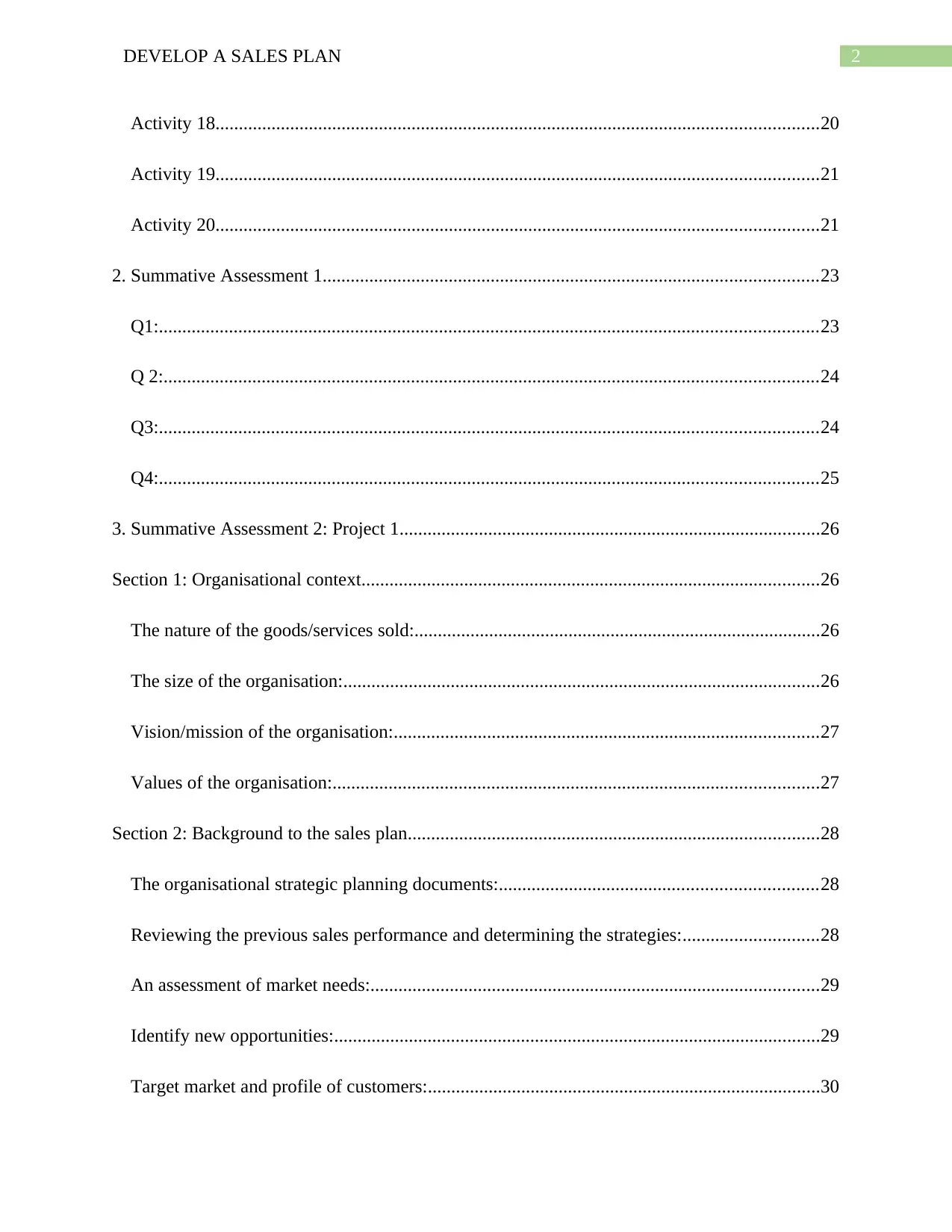
2DEVELOP A SALES PLAN
Activity 18.................................................................................................................................20
Activity 19.................................................................................................................................21
Activity 20.................................................................................................................................21
2. Summative Assessment 1..........................................................................................................23
Q1:.............................................................................................................................................23
Q 2:............................................................................................................................................24
Q3:.............................................................................................................................................24
Q4:.............................................................................................................................................25
3. Summative Assessment 2: Project 1..........................................................................................26
Section 1: Organisational context..................................................................................................26
The nature of the goods/services sold:.......................................................................................26
The size of the organisation:......................................................................................................26
Vision/mission of the organisation:...........................................................................................27
Values of the organisation:........................................................................................................27
Section 2: Background to the sales plan........................................................................................28
The organisational strategic planning documents:....................................................................28
Reviewing the previous sales performance and determining the strategies:.............................28
An assessment of market needs:................................................................................................29
Identify new opportunities:........................................................................................................29
Target market and profile of customers:....................................................................................30
Activity 18.................................................................................................................................20
Activity 19.................................................................................................................................21
Activity 20.................................................................................................................................21
2. Summative Assessment 1..........................................................................................................23
Q1:.............................................................................................................................................23
Q 2:............................................................................................................................................24
Q3:.............................................................................................................................................24
Q4:.............................................................................................................................................25
3. Summative Assessment 2: Project 1..........................................................................................26
Section 1: Organisational context..................................................................................................26
The nature of the goods/services sold:.......................................................................................26
The size of the organisation:......................................................................................................26
Vision/mission of the organisation:...........................................................................................27
Values of the organisation:........................................................................................................27
Section 2: Background to the sales plan........................................................................................28
The organisational strategic planning documents:....................................................................28
Reviewing the previous sales performance and determining the strategies:.............................28
An assessment of market needs:................................................................................................29
Identify new opportunities:........................................................................................................29
Target market and profile of customers:....................................................................................30
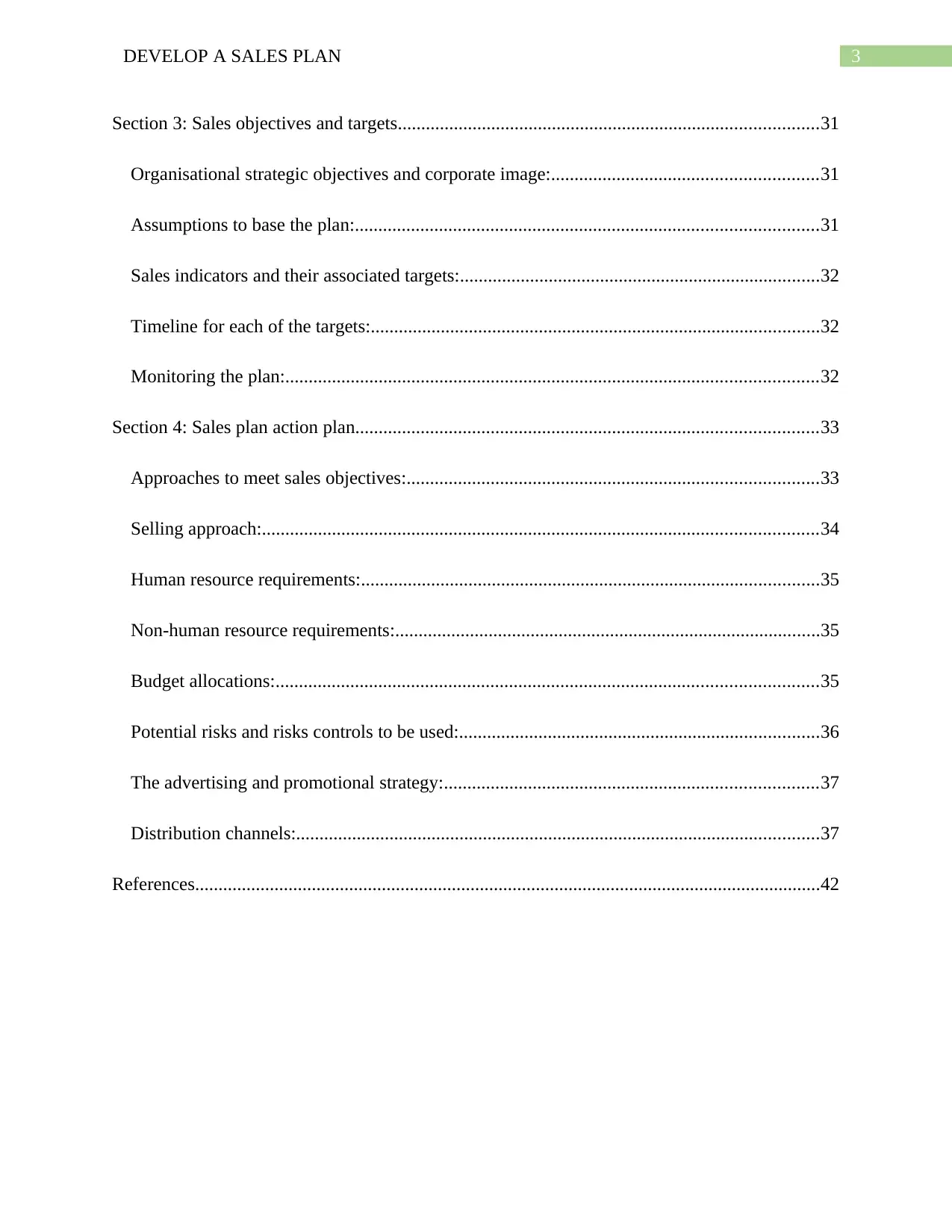
3DEVELOP A SALES PLAN
Section 3: Sales objectives and targets..........................................................................................31
Organisational strategic objectives and corporate image:.........................................................31
Assumptions to base the plan:...................................................................................................31
Sales indicators and their associated targets:.............................................................................32
Timeline for each of the targets:................................................................................................32
Monitoring the plan:..................................................................................................................32
Section 4: Sales plan action plan...................................................................................................33
Approaches to meet sales objectives:........................................................................................33
Selling approach:.......................................................................................................................34
Human resource requirements:..................................................................................................35
Non-human resource requirements:...........................................................................................35
Budget allocations:....................................................................................................................35
Potential risks and risks controls to be used:.............................................................................36
The advertising and promotional strategy:................................................................................37
Distribution channels:................................................................................................................37
References......................................................................................................................................42
Section 3: Sales objectives and targets..........................................................................................31
Organisational strategic objectives and corporate image:.........................................................31
Assumptions to base the plan:...................................................................................................31
Sales indicators and their associated targets:.............................................................................32
Timeline for each of the targets:................................................................................................32
Monitoring the plan:..................................................................................................................32
Section 4: Sales plan action plan...................................................................................................33
Approaches to meet sales objectives:........................................................................................33
Selling approach:.......................................................................................................................34
Human resource requirements:..................................................................................................35
Non-human resource requirements:...........................................................................................35
Budget allocations:....................................................................................................................35
Potential risks and risks controls to be used:.............................................................................36
The advertising and promotional strategy:................................................................................37
Distribution channels:................................................................................................................37
References......................................................................................................................................42
Secure Best Marks with AI Grader
Need help grading? Try our AI Grader for instant feedback on your assignments.
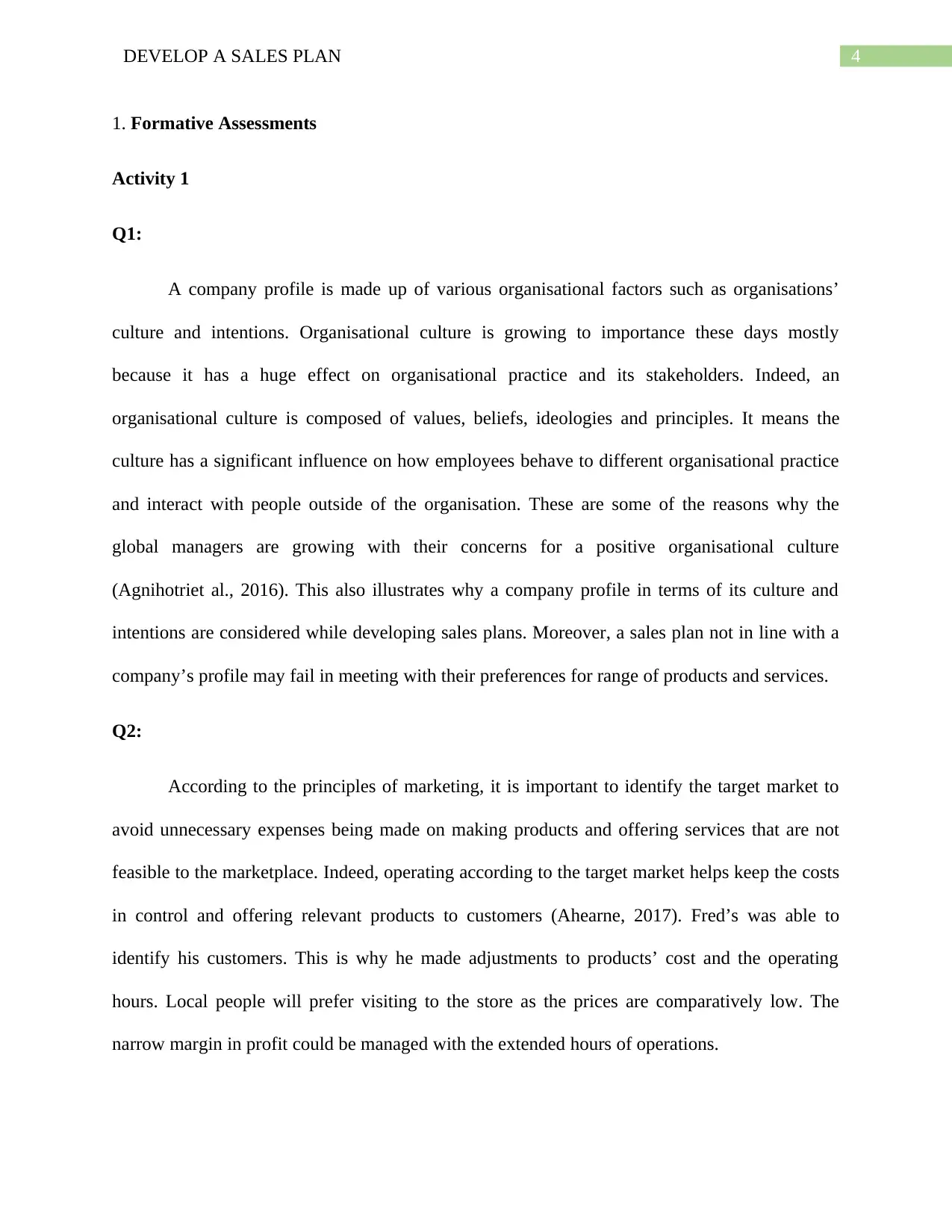
4DEVELOP A SALES PLAN
1. Formative Assessments
Activity 1
Q1:
A company profile is made up of various organisational factors such as organisations’
culture and intentions. Organisational culture is growing to importance these days mostly
because it has a huge effect on organisational practice and its stakeholders. Indeed, an
organisational culture is composed of values, beliefs, ideologies and principles. It means the
culture has a significant influence on how employees behave to different organisational practice
and interact with people outside of the organisation. These are some of the reasons why the
global managers are growing with their concerns for a positive organisational culture
(Agnihotriet al., 2016). This also illustrates why a company profile in terms of its culture and
intentions are considered while developing sales plans. Moreover, a sales plan not in line with a
company’s profile may fail in meeting with their preferences for range of products and services.
Q2:
According to the principles of marketing, it is important to identify the target market to
avoid unnecessary expenses being made on making products and offering services that are not
feasible to the marketplace. Indeed, operating according to the target market helps keep the costs
in control and offering relevant products to customers (Ahearne, 2017). Fred’s was able to
identify his customers. This is why he made adjustments to products’ cost and the operating
hours. Local people will prefer visiting to the store as the prices are comparatively low. The
narrow margin in profit could be managed with the extended hours of operations.
1. Formative Assessments
Activity 1
Q1:
A company profile is made up of various organisational factors such as organisations’
culture and intentions. Organisational culture is growing to importance these days mostly
because it has a huge effect on organisational practice and its stakeholders. Indeed, an
organisational culture is composed of values, beliefs, ideologies and principles. It means the
culture has a significant influence on how employees behave to different organisational practice
and interact with people outside of the organisation. These are some of the reasons why the
global managers are growing with their concerns for a positive organisational culture
(Agnihotriet al., 2016). This also illustrates why a company profile in terms of its culture and
intentions are considered while developing sales plans. Moreover, a sales plan not in line with a
company’s profile may fail in meeting with their preferences for range of products and services.
Q2:
According to the principles of marketing, it is important to identify the target market to
avoid unnecessary expenses being made on making products and offering services that are not
feasible to the marketplace. Indeed, operating according to the target market helps keep the costs
in control and offering relevant products to customers (Ahearne, 2017). Fred’s was able to
identify his customers. This is why he made adjustments to products’ cost and the operating
hours. Local people will prefer visiting to the store as the prices are comparatively low. The
narrow margin in profit could be managed with the extended hours of operations.
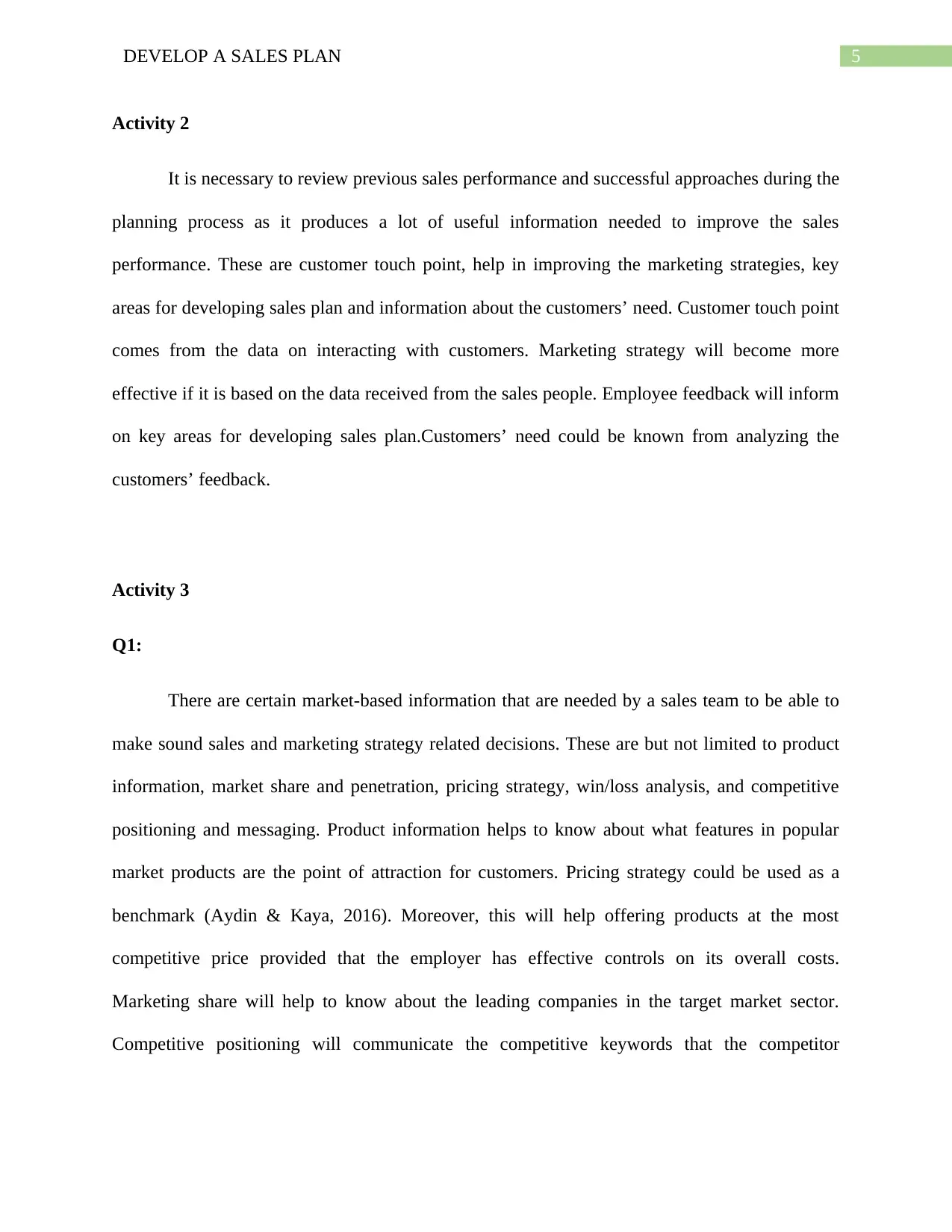
5DEVELOP A SALES PLAN
Activity 2
It is necessary to review previous sales performance and successful approaches during the
planning process as it produces a lot of useful information needed to improve the sales
performance. These are customer touch point, help in improving the marketing strategies, key
areas for developing sales plan and information about the customers’ need. Customer touch point
comes from the data on interacting with customers. Marketing strategy will become more
effective if it is based on the data received from the sales people. Employee feedback will inform
on key areas for developing sales plan.Customers’ need could be known from analyzing the
customers’ feedback.
Activity 3
Q1:
There are certain market-based information that are needed by a sales team to be able to
make sound sales and marketing strategy related decisions. These are but not limited to product
information, market share and penetration, pricing strategy, win/loss analysis, and competitive
positioning and messaging. Product information helps to know about what features in popular
market products are the point of attraction for customers. Pricing strategy could be used as a
benchmark (Aydin & Kaya, 2016). Moreover, this will help offering products at the most
competitive price provided that the employer has effective controls on its overall costs.
Marketing share will help to know about the leading companies in the target market sector.
Competitive positioning will communicate the competitive keywords that the competitor
Activity 2
It is necessary to review previous sales performance and successful approaches during the
planning process as it produces a lot of useful information needed to improve the sales
performance. These are customer touch point, help in improving the marketing strategies, key
areas for developing sales plan and information about the customers’ need. Customer touch point
comes from the data on interacting with customers. Marketing strategy will become more
effective if it is based on the data received from the sales people. Employee feedback will inform
on key areas for developing sales plan.Customers’ need could be known from analyzing the
customers’ feedback.
Activity 3
Q1:
There are certain market-based information that are needed by a sales team to be able to
make sound sales and marketing strategy related decisions. These are but not limited to product
information, market share and penetration, pricing strategy, win/loss analysis, and competitive
positioning and messaging. Product information helps to know about what features in popular
market products are the point of attraction for customers. Pricing strategy could be used as a
benchmark (Aydin & Kaya, 2016). Moreover, this will help offering products at the most
competitive price provided that the employer has effective controls on its overall costs.
Marketing share will help to know about the leading companies in the target market sector.
Competitive positioning will communicate the competitive keywords that the competitor

6DEVELOP A SALES PLAN
companies use to dominate search engines. Win/loss will help to understand the features of the
products and services being liked and disliked by customers.
Q2:
A market segment is a group of people who have one or more thing on common. Each
market segment is unique as it follows behaviours different from that of another.
Segmenting a market is essential to identify who are the actual customers (Bolander&
Richards, 2018). One product cannot be offered to people of all age groups, geography etc. For
an example, ‘Chocolates’ may not be a preferred choice of foods to the old people as they may
be suffering from diabetes. Again, luxury cars cannot have its target market set to locations that
mostly have people making average income. These examples illustrate the fact that segmenting a
marketing is an essential part of a sales strategy. It must be analysed appropriately to produce the
maximum of impact with it.
Activity 4
Q1:
There are many benefits of basing assumptions on quantifiable data. It is used to identify
and know the most important assumptions of to be able to deal with uncertainty. This also helps
to know the most important of assumptions in business plans of a company. Moreover, these
assumptions can also be tested. Such tests will produce a piece of information to be used to
create a database. The database will help to know about the assumptions that worked or else
companies use to dominate search engines. Win/loss will help to understand the features of the
products and services being liked and disliked by customers.
Q2:
A market segment is a group of people who have one or more thing on common. Each
market segment is unique as it follows behaviours different from that of another.
Segmenting a market is essential to identify who are the actual customers (Bolander&
Richards, 2018). One product cannot be offered to people of all age groups, geography etc. For
an example, ‘Chocolates’ may not be a preferred choice of foods to the old people as they may
be suffering from diabetes. Again, luxury cars cannot have its target market set to locations that
mostly have people making average income. These examples illustrate the fact that segmenting a
marketing is an essential part of a sales strategy. It must be analysed appropriately to produce the
maximum of impact with it.
Activity 4
Q1:
There are many benefits of basing assumptions on quantifiable data. It is used to identify
and know the most important assumptions of to be able to deal with uncertainty. This also helps
to know the most important of assumptions in business plans of a company. Moreover, these
assumptions can also be tested. Such tests will produce a piece of information to be used to
create a database. The database will help to know about the assumptions that worked or else
Paraphrase This Document
Need a fresh take? Get an instant paraphrase of this document with our AI Paraphraser
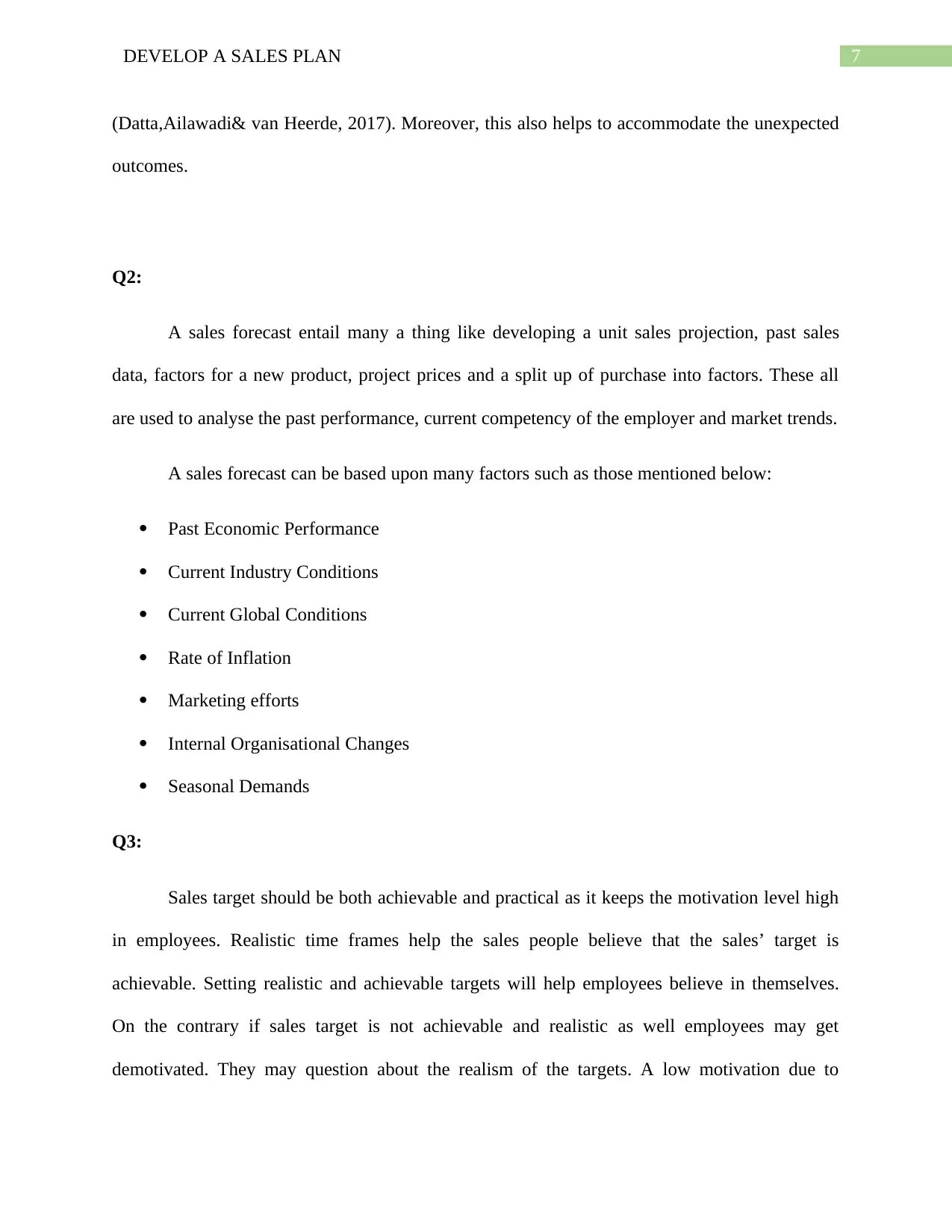
7DEVELOP A SALES PLAN
(Datta,Ailawadi& van Heerde, 2017). Moreover, this also helps to accommodate the unexpected
outcomes.
Q2:
A sales forecast entail many a thing like developing a unit sales projection, past sales
data, factors for a new product, project prices and a split up of purchase into factors. These all
are used to analyse the past performance, current competency of the employer and market trends.
A sales forecast can be based upon many factors such as those mentioned below:
Past Economic Performance
Current Industry Conditions
Current Global Conditions
Rate of Inflation
Marketing efforts
Internal Organisational Changes
Seasonal Demands
Q3:
Sales target should be both achievable and practical as it keeps the motivation level high
in employees. Realistic time frames help the sales people believe that the sales’ target is
achievable. Setting realistic and achievable targets will help employees believe in themselves.
On the contrary if sales target is not achievable and realistic as well employees may get
demotivated. They may question about the realism of the targets. A low motivation due to
(Datta,Ailawadi& van Heerde, 2017). Moreover, this also helps to accommodate the unexpected
outcomes.
Q2:
A sales forecast entail many a thing like developing a unit sales projection, past sales
data, factors for a new product, project prices and a split up of purchase into factors. These all
are used to analyse the past performance, current competency of the employer and market trends.
A sales forecast can be based upon many factors such as those mentioned below:
Past Economic Performance
Current Industry Conditions
Current Global Conditions
Rate of Inflation
Marketing efforts
Internal Organisational Changes
Seasonal Demands
Q3:
Sales target should be both achievable and practical as it keeps the motivation level high
in employees. Realistic time frames help the sales people believe that the sales’ target is
achievable. Setting realistic and achievable targets will help employees believe in themselves.
On the contrary if sales target is not achievable and realistic as well employees may get
demotivated. They may question about the realism of the targets. A low motivation due to
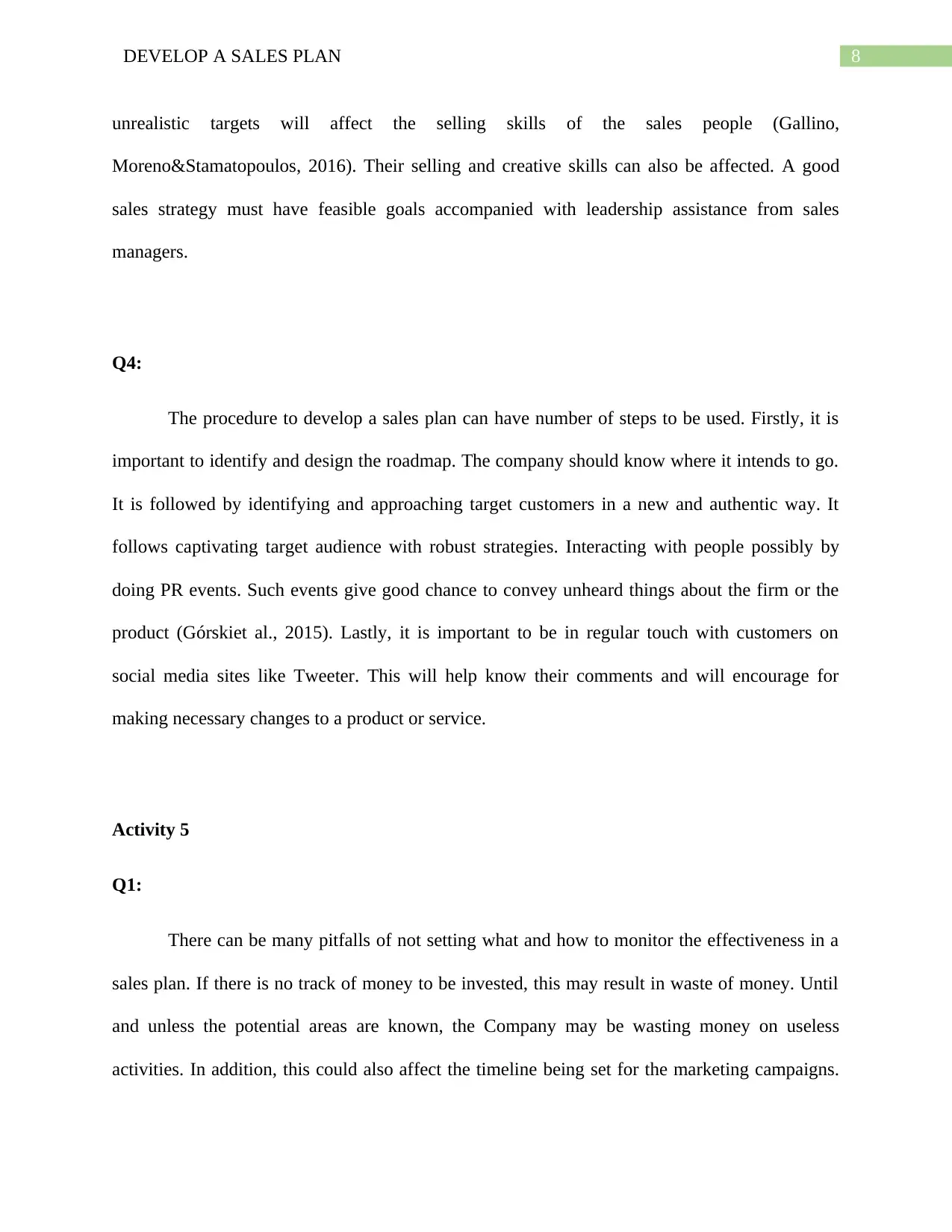
8DEVELOP A SALES PLAN
unrealistic targets will affect the selling skills of the sales people (Gallino,
Moreno&Stamatopoulos, 2016). Their selling and creative skills can also be affected. A good
sales strategy must have feasible goals accompanied with leadership assistance from sales
managers.
Q4:
The procedure to develop a sales plan can have number of steps to be used. Firstly, it is
important to identify and design the roadmap. The company should know where it intends to go.
It is followed by identifying and approaching target customers in a new and authentic way. It
follows captivating target audience with robust strategies. Interacting with people possibly by
doing PR events. Such events give good chance to convey unheard things about the firm or the
product (Górskiet al., 2015). Lastly, it is important to be in regular touch with customers on
social media sites like Tweeter. This will help know their comments and will encourage for
making necessary changes to a product or service.
Activity 5
Q1:
There can be many pitfalls of not setting what and how to monitor the effectiveness in a
sales plan. If there is no track of money to be invested, this may result in waste of money. Until
and unless the potential areas are known, the Company may be wasting money on useless
activities. In addition, this could also affect the timeline being set for the marketing campaigns.
unrealistic targets will affect the selling skills of the sales people (Gallino,
Moreno&Stamatopoulos, 2016). Their selling and creative skills can also be affected. A good
sales strategy must have feasible goals accompanied with leadership assistance from sales
managers.
Q4:
The procedure to develop a sales plan can have number of steps to be used. Firstly, it is
important to identify and design the roadmap. The company should know where it intends to go.
It is followed by identifying and approaching target customers in a new and authentic way. It
follows captivating target audience with robust strategies. Interacting with people possibly by
doing PR events. Such events give good chance to convey unheard things about the firm or the
product (Górskiet al., 2015). Lastly, it is important to be in regular touch with customers on
social media sites like Tweeter. This will help know their comments and will encourage for
making necessary changes to a product or service.
Activity 5
Q1:
There can be many pitfalls of not setting what and how to monitor the effectiveness in a
sales plan. If there is no track of money to be invested, this may result in waste of money. Until
and unless the potential areas are known, the Company may be wasting money on useless
activities. In addition, this could also affect the timeline being set for the marketing campaigns.
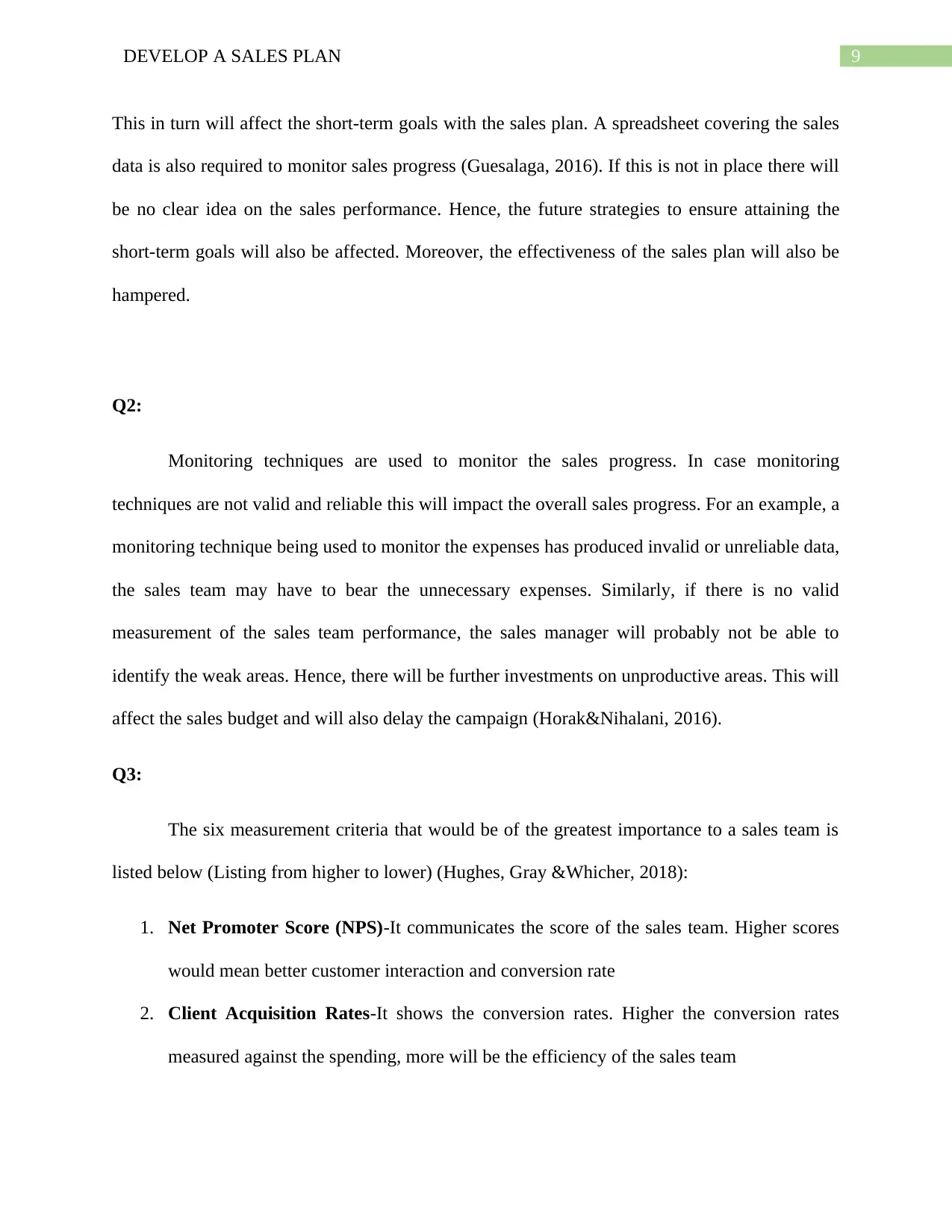
9DEVELOP A SALES PLAN
This in turn will affect the short-term goals with the sales plan. A spreadsheet covering the sales
data is also required to monitor sales progress (Guesalaga, 2016). If this is not in place there will
be no clear idea on the sales performance. Hence, the future strategies to ensure attaining the
short-term goals will also be affected. Moreover, the effectiveness of the sales plan will also be
hampered.
Q2:
Monitoring techniques are used to monitor the sales progress. In case monitoring
techniques are not valid and reliable this will impact the overall sales progress. For an example, a
monitoring technique being used to monitor the expenses has produced invalid or unreliable data,
the sales team may have to bear the unnecessary expenses. Similarly, if there is no valid
measurement of the sales team performance, the sales manager will probably not be able to
identify the weak areas. Hence, there will be further investments on unproductive areas. This will
affect the sales budget and will also delay the campaign (Horak&Nihalani, 2016).
Q3:
The six measurement criteria that would be of the greatest importance to a sales team is
listed below (Listing from higher to lower) (Hughes, Gray &Whicher, 2018):
1. Net Promoter Score (NPS)-It communicates the score of the sales team. Higher scores
would mean better customer interaction and conversion rate
2. Client Acquisition Rates-It shows the conversion rates. Higher the conversion rates
measured against the spending, more will be the efficiency of the sales team
This in turn will affect the short-term goals with the sales plan. A spreadsheet covering the sales
data is also required to monitor sales progress (Guesalaga, 2016). If this is not in place there will
be no clear idea on the sales performance. Hence, the future strategies to ensure attaining the
short-term goals will also be affected. Moreover, the effectiveness of the sales plan will also be
hampered.
Q2:
Monitoring techniques are used to monitor the sales progress. In case monitoring
techniques are not valid and reliable this will impact the overall sales progress. For an example, a
monitoring technique being used to monitor the expenses has produced invalid or unreliable data,
the sales team may have to bear the unnecessary expenses. Similarly, if there is no valid
measurement of the sales team performance, the sales manager will probably not be able to
identify the weak areas. Hence, there will be further investments on unproductive areas. This will
affect the sales budget and will also delay the campaign (Horak&Nihalani, 2016).
Q3:
The six measurement criteria that would be of the greatest importance to a sales team is
listed below (Listing from higher to lower) (Hughes, Gray &Whicher, 2018):
1. Net Promoter Score (NPS)-It communicates the score of the sales team. Higher scores
would mean better customer interaction and conversion rate
2. Client Acquisition Rates-It shows the conversion rates. Higher the conversion rates
measured against the spending, more will be the efficiency of the sales team
Secure Best Marks with AI Grader
Need help grading? Try our AI Grader for instant feedback on your assignments.
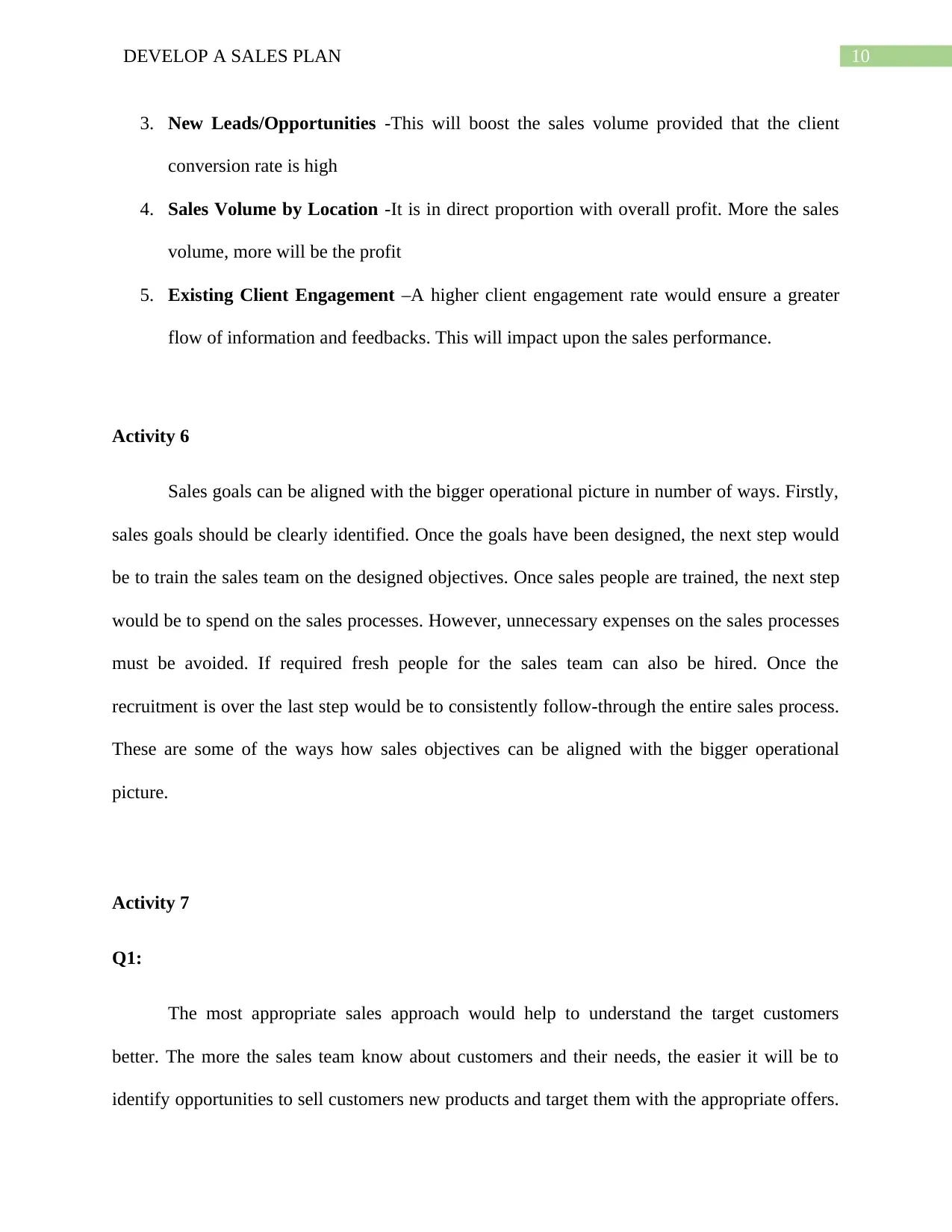
10DEVELOP A SALES PLAN
3. New Leads/Opportunities -This will boost the sales volume provided that the client
conversion rate is high
4. Sales Volume by Location -It is in direct proportion with overall profit. More the sales
volume, more will be the profit
5. Existing Client Engagement –A higher client engagement rate would ensure a greater
flow of information and feedbacks. This will impact upon the sales performance.
Activity 6
Sales goals can be aligned with the bigger operational picture in number of ways. Firstly,
sales goals should be clearly identified. Once the goals have been designed, the next step would
be to train the sales team on the designed objectives. Once sales people are trained, the next step
would be to spend on the sales processes. However, unnecessary expenses on the sales processes
must be avoided. If required fresh people for the sales team can also be hired. Once the
recruitment is over the last step would be to consistently follow-through the entire sales process.
These are some of the ways how sales objectives can be aligned with the bigger operational
picture.
Activity 7
Q1:
The most appropriate sales approach would help to understand the target customers
better. The more the sales team know about customers and their needs, the easier it will be to
identify opportunities to sell customers new products and target them with the appropriate offers.
3. New Leads/Opportunities -This will boost the sales volume provided that the client
conversion rate is high
4. Sales Volume by Location -It is in direct proportion with overall profit. More the sales
volume, more will be the profit
5. Existing Client Engagement –A higher client engagement rate would ensure a greater
flow of information and feedbacks. This will impact upon the sales performance.
Activity 6
Sales goals can be aligned with the bigger operational picture in number of ways. Firstly,
sales goals should be clearly identified. Once the goals have been designed, the next step would
be to train the sales team on the designed objectives. Once sales people are trained, the next step
would be to spend on the sales processes. However, unnecessary expenses on the sales processes
must be avoided. If required fresh people for the sales team can also be hired. Once the
recruitment is over the last step would be to consistently follow-through the entire sales process.
These are some of the ways how sales objectives can be aligned with the bigger operational
picture.
Activity 7
Q1:
The most appropriate sales approach would help to understand the target customers
better. The more the sales team know about customers and their needs, the easier it will be to
identify opportunities to sell customers new products and target them with the appropriate offers.
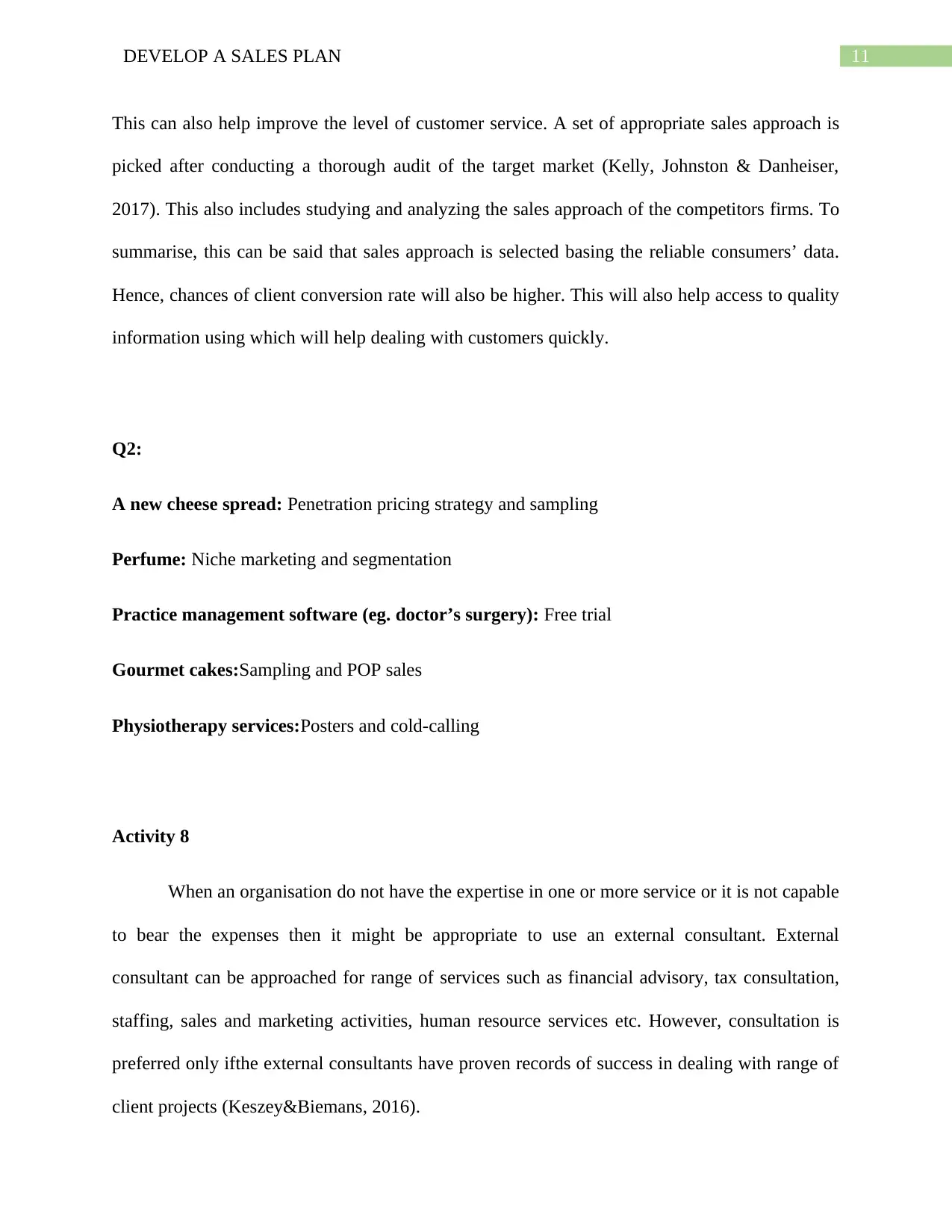
11DEVELOP A SALES PLAN
This can also help improve the level of customer service. A set of appropriate sales approach is
picked after conducting a thorough audit of the target market (Kelly, Johnston & Danheiser,
2017). This also includes studying and analyzing the sales approach of the competitors firms. To
summarise, this can be said that sales approach is selected basing the reliable consumers’ data.
Hence, chances of client conversion rate will also be higher. This will also help access to quality
information using which will help dealing with customers quickly.
Q2:
A new cheese spread: Penetration pricing strategy and sampling
Perfume: Niche marketing and segmentation
Practice management software (eg. doctor’s surgery): Free trial
Gourmet cakes:Sampling and POP sales
Physiotherapy services:Posters and cold-calling
Activity 8
When an organisation do not have the expertise in one or more service or it is not capable
to bear the expenses then it might be appropriate to use an external consultant. External
consultant can be approached for range of services such as financial advisory, tax consultation,
staffing, sales and marketing activities, human resource services etc. However, consultation is
preferred only ifthe external consultants have proven records of success in dealing with range of
client projects (Keszey&Biemans, 2016).
This can also help improve the level of customer service. A set of appropriate sales approach is
picked after conducting a thorough audit of the target market (Kelly, Johnston & Danheiser,
2017). This also includes studying and analyzing the sales approach of the competitors firms. To
summarise, this can be said that sales approach is selected basing the reliable consumers’ data.
Hence, chances of client conversion rate will also be higher. This will also help access to quality
information using which will help dealing with customers quickly.
Q2:
A new cheese spread: Penetration pricing strategy and sampling
Perfume: Niche marketing and segmentation
Practice management software (eg. doctor’s surgery): Free trial
Gourmet cakes:Sampling and POP sales
Physiotherapy services:Posters and cold-calling
Activity 8
When an organisation do not have the expertise in one or more service or it is not capable
to bear the expenses then it might be appropriate to use an external consultant. External
consultant can be approached for range of services such as financial advisory, tax consultation,
staffing, sales and marketing activities, human resource services etc. However, consultation is
preferred only ifthe external consultants have proven records of success in dealing with range of
client projects (Keszey&Biemans, 2016).
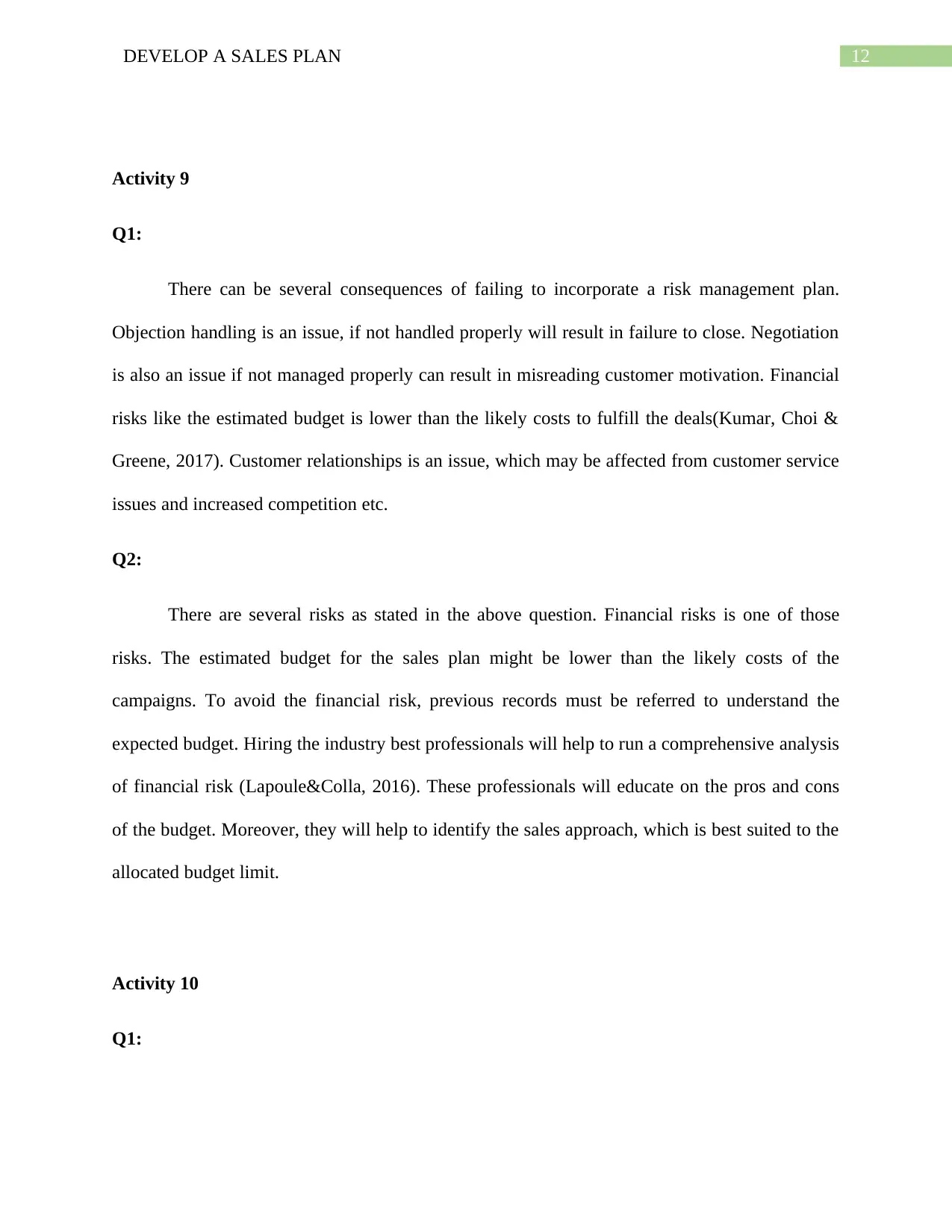
12DEVELOP A SALES PLAN
Activity 9
Q1:
There can be several consequences of failing to incorporate a risk management plan.
Objection handling is an issue, if not handled properly will result in failure to close. Negotiation
is also an issue if not managed properly can result in misreading customer motivation. Financial
risks like the estimated budget is lower than the likely costs to fulfill the deals(Kumar, Choi &
Greene, 2017). Customer relationships is an issue, which may be affected from customer service
issues and increased competition etc.
Q2:
There are several risks as stated in the above question. Financial risks is one of those
risks. The estimated budget for the sales plan might be lower than the likely costs of the
campaigns. To avoid the financial risk, previous records must be referred to understand the
expected budget. Hiring the industry best professionals will help to run a comprehensive analysis
of financial risk (Lapoule&Colla, 2016). These professionals will educate on the pros and cons
of the budget. Moreover, they will help to identify the sales approach, which is best suited to the
allocated budget limit.
Activity 10
Q1:
Activity 9
Q1:
There can be several consequences of failing to incorporate a risk management plan.
Objection handling is an issue, if not handled properly will result in failure to close. Negotiation
is also an issue if not managed properly can result in misreading customer motivation. Financial
risks like the estimated budget is lower than the likely costs to fulfill the deals(Kumar, Choi &
Greene, 2017). Customer relationships is an issue, which may be affected from customer service
issues and increased competition etc.
Q2:
There are several risks as stated in the above question. Financial risks is one of those
risks. The estimated budget for the sales plan might be lower than the likely costs of the
campaigns. To avoid the financial risk, previous records must be referred to understand the
expected budget. Hiring the industry best professionals will help to run a comprehensive analysis
of financial risk (Lapoule&Colla, 2016). These professionals will educate on the pros and cons
of the budget. Moreover, they will help to identify the sales approach, which is best suited to the
allocated budget limit.
Activity 10
Q1:
Paraphrase This Document
Need a fresh take? Get an instant paraphrase of this document with our AI Paraphraser
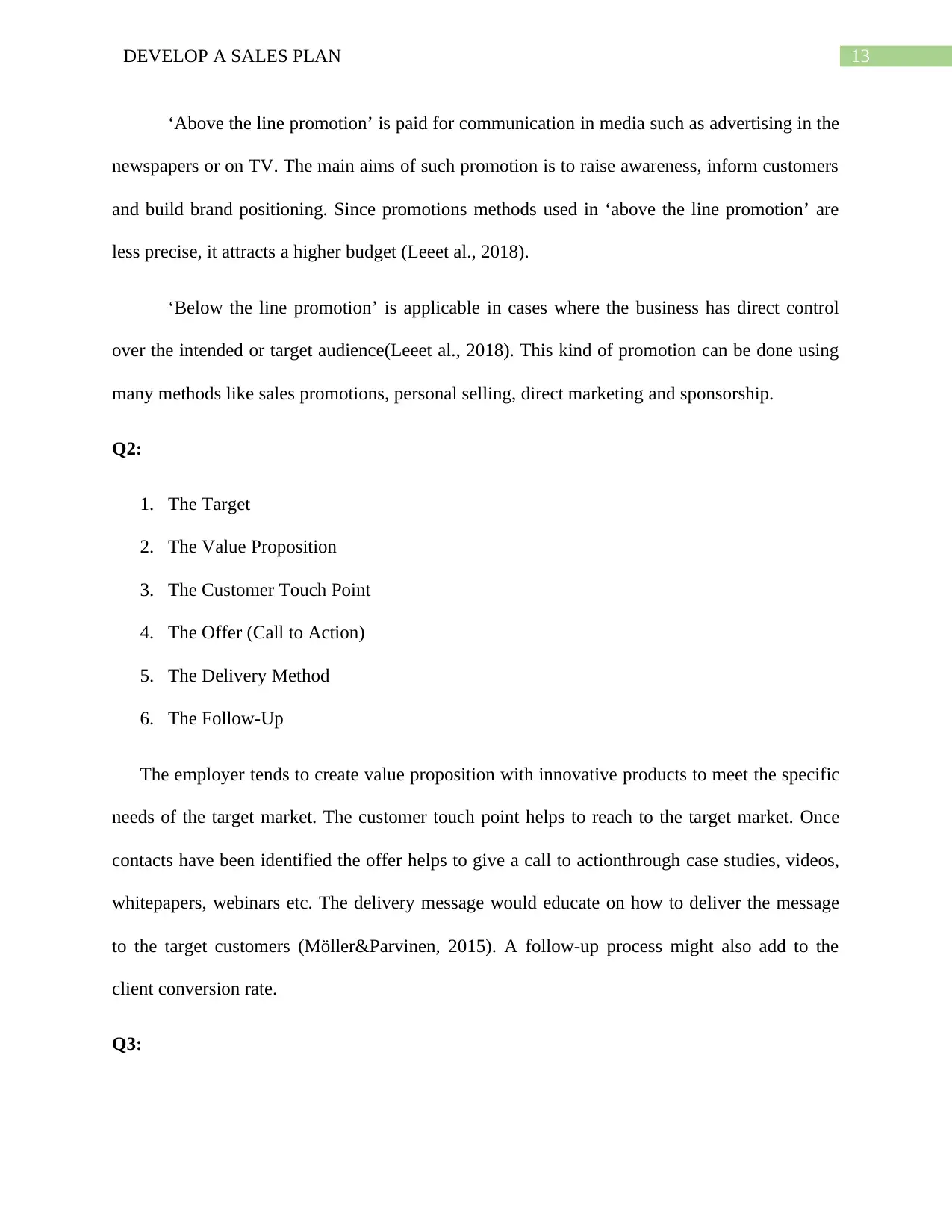
13DEVELOP A SALES PLAN
‘Above the line promotion’ is paid for communication in media such as advertising in the
newspapers or on TV. The main aims of such promotion is to raise awareness, inform customers
and build brand positioning. Since promotions methods used in ‘above the line promotion’ are
less precise, it attracts a higher budget (Leeet al., 2018).
‘Below the line promotion’ is applicable in cases where the business has direct control
over the intended or target audience(Leeet al., 2018). This kind of promotion can be done using
many methods like sales promotions, personal selling, direct marketing and sponsorship.
Q2:
1. The Target
2. The Value Proposition
3. The Customer Touch Point
4. The Offer (Call to Action)
5. The Delivery Method
6. The Follow-Up
The employer tends to create value proposition with innovative products to meet the specific
needs of the target market. The customer touch point helps to reach to the target market. Once
contacts have been identified the offer helps to give a call to actionthrough case studies, videos,
whitepapers, webinars etc. The delivery message would educate on how to deliver the message
to the target customers (Möller&Parvinen, 2015). A follow-up process might also add to the
client conversion rate.
Q3:
‘Above the line promotion’ is paid for communication in media such as advertising in the
newspapers or on TV. The main aims of such promotion is to raise awareness, inform customers
and build brand positioning. Since promotions methods used in ‘above the line promotion’ are
less precise, it attracts a higher budget (Leeet al., 2018).
‘Below the line promotion’ is applicable in cases where the business has direct control
over the intended or target audience(Leeet al., 2018). This kind of promotion can be done using
many methods like sales promotions, personal selling, direct marketing and sponsorship.
Q2:
1. The Target
2. The Value Proposition
3. The Customer Touch Point
4. The Offer (Call to Action)
5. The Delivery Method
6. The Follow-Up
The employer tends to create value proposition with innovative products to meet the specific
needs of the target market. The customer touch point helps to reach to the target market. Once
contacts have been identified the offer helps to give a call to actionthrough case studies, videos,
whitepapers, webinars etc. The delivery message would educate on how to deliver the message
to the target customers (Möller&Parvinen, 2015). A follow-up process might also add to the
client conversion rate.
Q3:
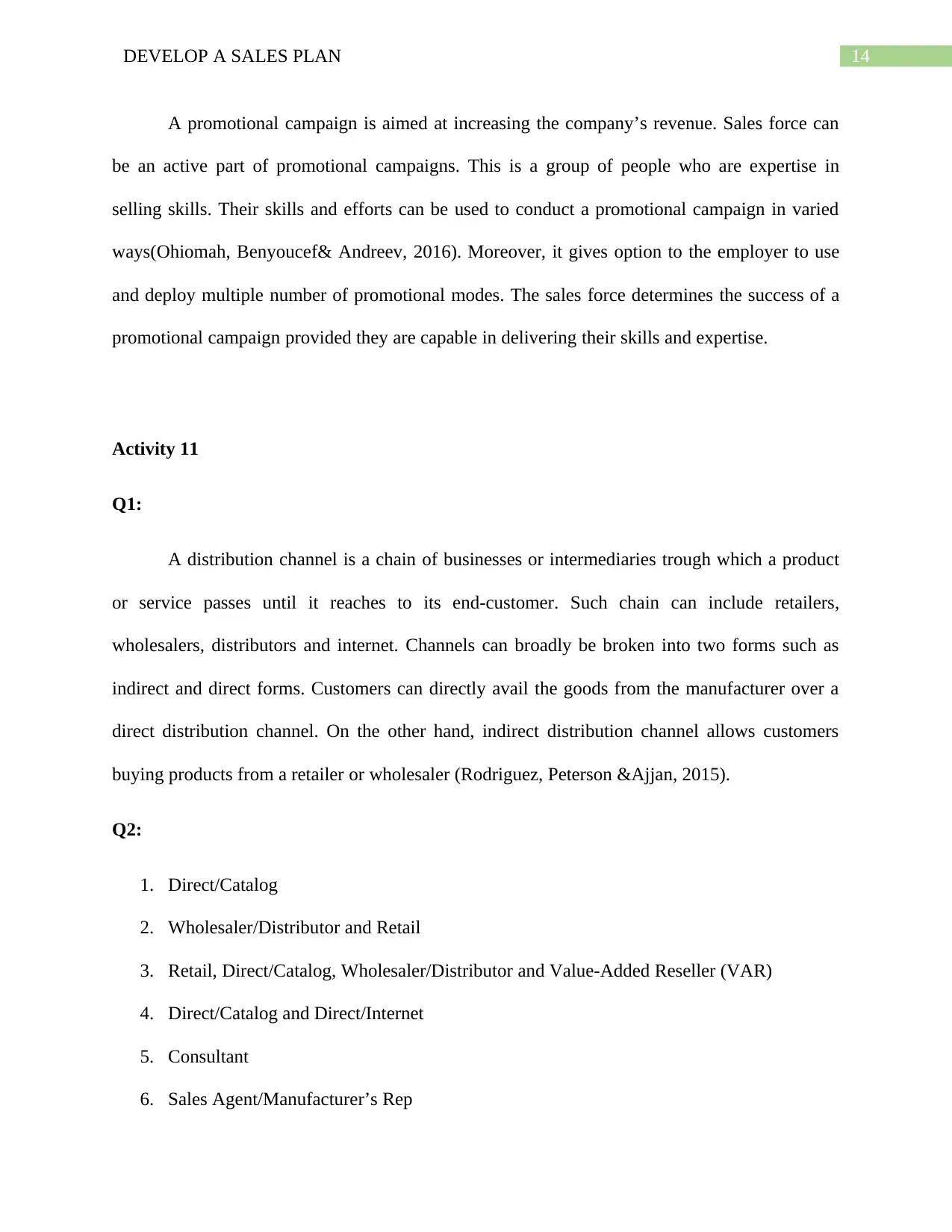
14DEVELOP A SALES PLAN
A promotional campaign is aimed at increasing the company’s revenue. Sales force can
be an active part of promotional campaigns. This is a group of people who are expertise in
selling skills. Their skills and efforts can be used to conduct a promotional campaign in varied
ways(Ohiomah, Benyoucef& Andreev, 2016). Moreover, it gives option to the employer to use
and deploy multiple number of promotional modes. The sales force determines the success of a
promotional campaign provided they are capable in delivering their skills and expertise.
Activity 11
Q1:
A distribution channel is a chain of businesses or intermediaries trough which a product
or service passes until it reaches to its end-customer. Such chain can include retailers,
wholesalers, distributors and internet. Channels can broadly be broken into two forms such as
indirect and direct forms. Customers can directly avail the goods from the manufacturer over a
direct distribution channel. On the other hand, indirect distribution channel allows customers
buying products from a retailer or wholesaler (Rodriguez, Peterson &Ajjan, 2015).
Q2:
1. Direct/Catalog
2. Wholesaler/Distributor and Retail
3. Retail, Direct/Catalog, Wholesaler/Distributor and Value-Added Reseller (VAR)
4. Direct/Catalog and Direct/Internet
5. Consultant
6. Sales Agent/Manufacturer’s Rep
A promotional campaign is aimed at increasing the company’s revenue. Sales force can
be an active part of promotional campaigns. This is a group of people who are expertise in
selling skills. Their skills and efforts can be used to conduct a promotional campaign in varied
ways(Ohiomah, Benyoucef& Andreev, 2016). Moreover, it gives option to the employer to use
and deploy multiple number of promotional modes. The sales force determines the success of a
promotional campaign provided they are capable in delivering their skills and expertise.
Activity 11
Q1:
A distribution channel is a chain of businesses or intermediaries trough which a product
or service passes until it reaches to its end-customer. Such chain can include retailers,
wholesalers, distributors and internet. Channels can broadly be broken into two forms such as
indirect and direct forms. Customers can directly avail the goods from the manufacturer over a
direct distribution channel. On the other hand, indirect distribution channel allows customers
buying products from a retailer or wholesaler (Rodriguez, Peterson &Ajjan, 2015).
Q2:
1. Direct/Catalog
2. Wholesaler/Distributor and Retail
3. Retail, Direct/Catalog, Wholesaler/Distributor and Value-Added Reseller (VAR)
4. Direct/Catalog and Direct/Internet
5. Consultant
6. Sales Agent/Manufacturer’s Rep
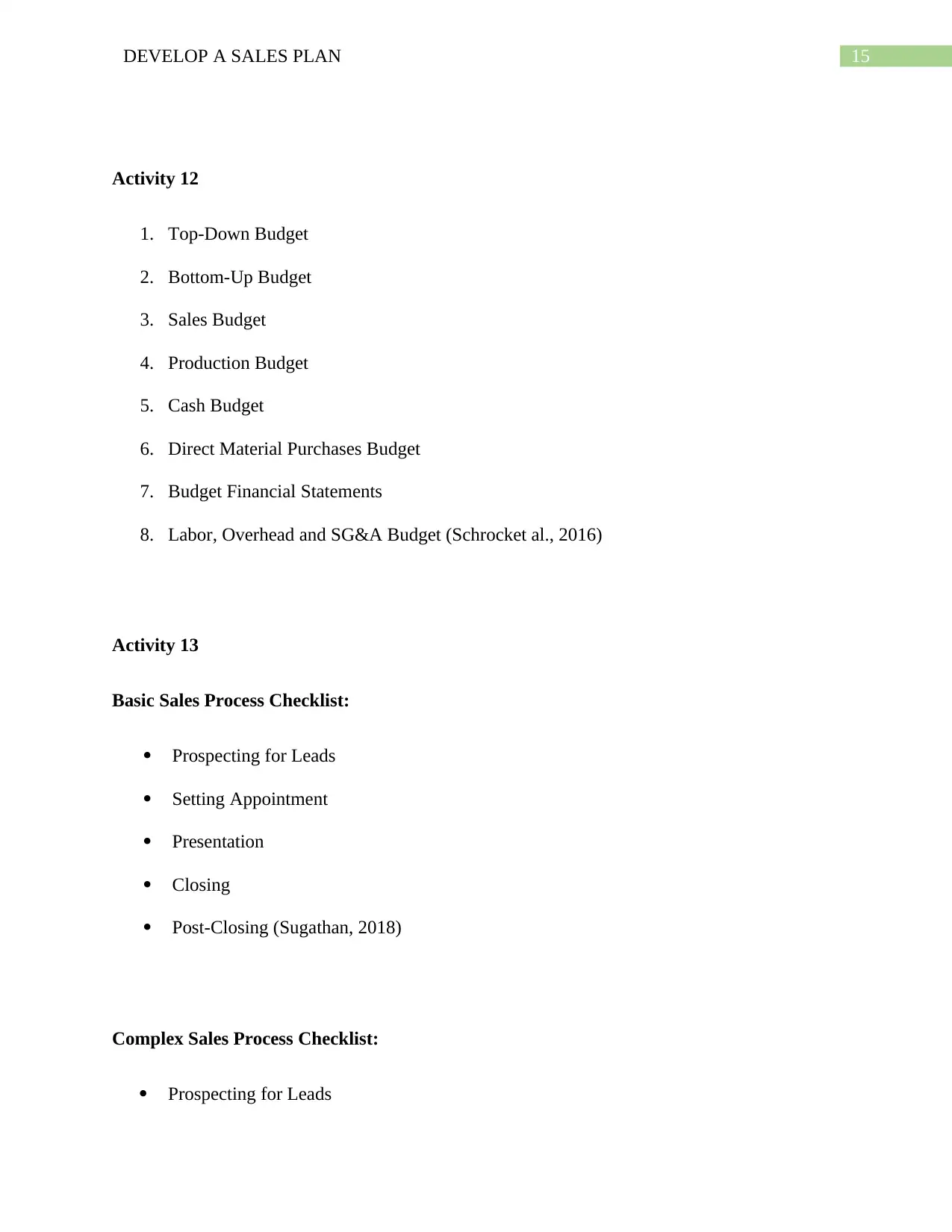
15DEVELOP A SALES PLAN
Activity 12
1. Top-Down Budget
2. Bottom-Up Budget
3. Sales Budget
4. Production Budget
5. Cash Budget
6. Direct Material Purchases Budget
7. Budget Financial Statements
8. Labor, Overhead and SG&A Budget (Schrocket al., 2016)
Activity 13
Basic Sales Process Checklist:
Prospecting for Leads
Setting Appointment
Presentation
Closing
Post-Closing (Sugathan, 2018)
Complex Sales Process Checklist:
Prospecting for Leads
Activity 12
1. Top-Down Budget
2. Bottom-Up Budget
3. Sales Budget
4. Production Budget
5. Cash Budget
6. Direct Material Purchases Budget
7. Budget Financial Statements
8. Labor, Overhead and SG&A Budget (Schrocket al., 2016)
Activity 13
Basic Sales Process Checklist:
Prospecting for Leads
Setting Appointment
Presentation
Closing
Post-Closing (Sugathan, 2018)
Complex Sales Process Checklist:
Prospecting for Leads
Secure Best Marks with AI Grader
Need help grading? Try our AI Grader for instant feedback on your assignments.
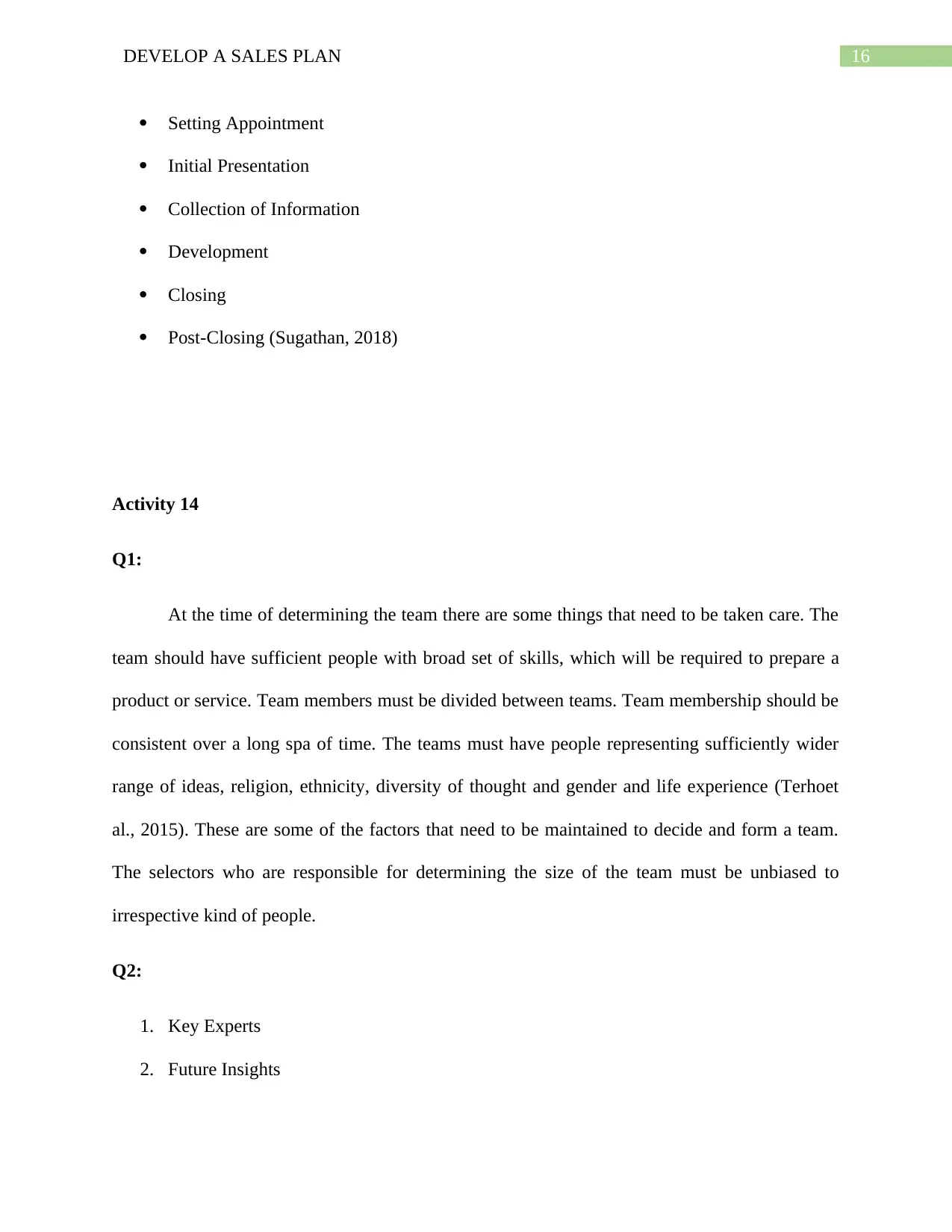
16DEVELOP A SALES PLAN
Setting Appointment
Initial Presentation
Collection of Information
Development
Closing
Post-Closing (Sugathan, 2018)
Activity 14
Q1:
At the time of determining the team there are some things that need to be taken care. The
team should have sufficient people with broad set of skills, which will be required to prepare a
product or service. Team members must be divided between teams. Team membership should be
consistent over a long spa of time. The teams must have people representing sufficiently wider
range of ideas, religion, ethnicity, diversity of thought and gender and life experience (Terhoet
al., 2015). These are some of the factors that need to be maintained to decide and form a team.
The selectors who are responsible for determining the size of the team must be unbiased to
irrespective kind of people.
Q2:
1. Key Experts
2. Future Insights
Setting Appointment
Initial Presentation
Collection of Information
Development
Closing
Post-Closing (Sugathan, 2018)
Activity 14
Q1:
At the time of determining the team there are some things that need to be taken care. The
team should have sufficient people with broad set of skills, which will be required to prepare a
product or service. Team members must be divided between teams. Team membership should be
consistent over a long spa of time. The teams must have people representing sufficiently wider
range of ideas, religion, ethnicity, diversity of thought and gender and life experience (Terhoet
al., 2015). These are some of the factors that need to be maintained to decide and form a team.
The selectors who are responsible for determining the size of the team must be unbiased to
irrespective kind of people.
Q2:
1. Key Experts
2. Future Insights
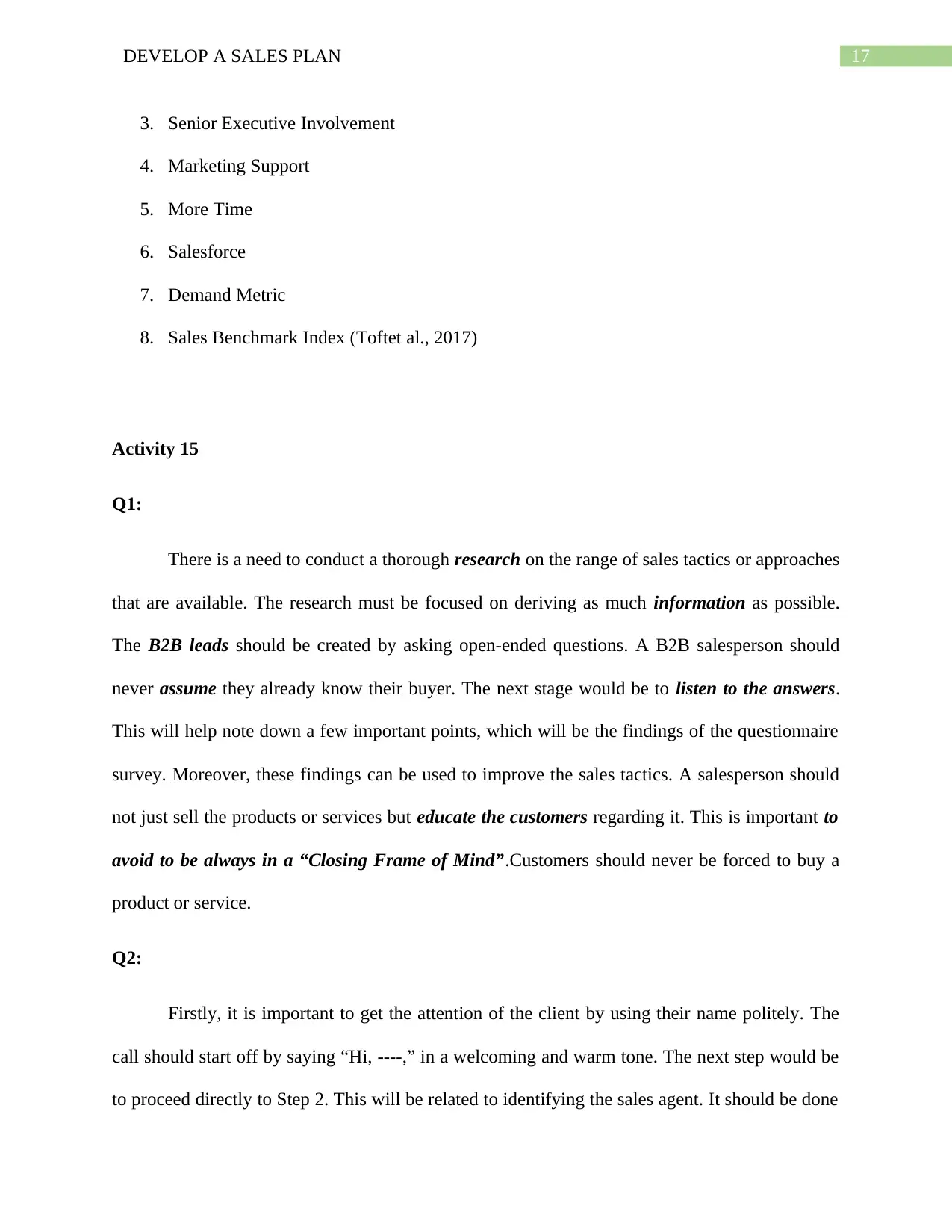
17DEVELOP A SALES PLAN
3. Senior Executive Involvement
4. Marketing Support
5. More Time
6. Salesforce
7. Demand Metric
8. Sales Benchmark Index (Toftet al., 2017)
Activity 15
Q1:
There is a need to conduct a thorough research on the range of sales tactics or approaches
that are available. The research must be focused on deriving as much information as possible.
The B2B leads should be created by asking open-ended questions. A B2B salesperson should
never assume they already know their buyer. The next stage would be to listen to the answers.
This will help note down a few important points, which will be the findings of the questionnaire
survey. Moreover, these findings can be used to improve the sales tactics. A salesperson should
not just sell the products or services but educate the customers regarding it. This is important to
avoid to be always in a “Closing Frame of Mind”.Customers should never be forced to buy a
product or service.
Q2:
Firstly, it is important to get the attention of the client by using their name politely. The
call should start off by saying “Hi, ----,” in a welcoming and warm tone. The next step would be
to proceed directly to Step 2. This will be related to identifying the sales agent. It should be done
3. Senior Executive Involvement
4. Marketing Support
5. More Time
6. Salesforce
7. Demand Metric
8. Sales Benchmark Index (Toftet al., 2017)
Activity 15
Q1:
There is a need to conduct a thorough research on the range of sales tactics or approaches
that are available. The research must be focused on deriving as much information as possible.
The B2B leads should be created by asking open-ended questions. A B2B salesperson should
never assume they already know their buyer. The next stage would be to listen to the answers.
This will help note down a few important points, which will be the findings of the questionnaire
survey. Moreover, these findings can be used to improve the sales tactics. A salesperson should
not just sell the products or services but educate the customers regarding it. This is important to
avoid to be always in a “Closing Frame of Mind”.Customers should never be forced to buy a
product or service.
Q2:
Firstly, it is important to get the attention of the client by using their name politely. The
call should start off by saying “Hi, ----,” in a welcoming and warm tone. The next step would be
to proceed directly to Step 2. This will be related to identifying the sales agent. It should be done
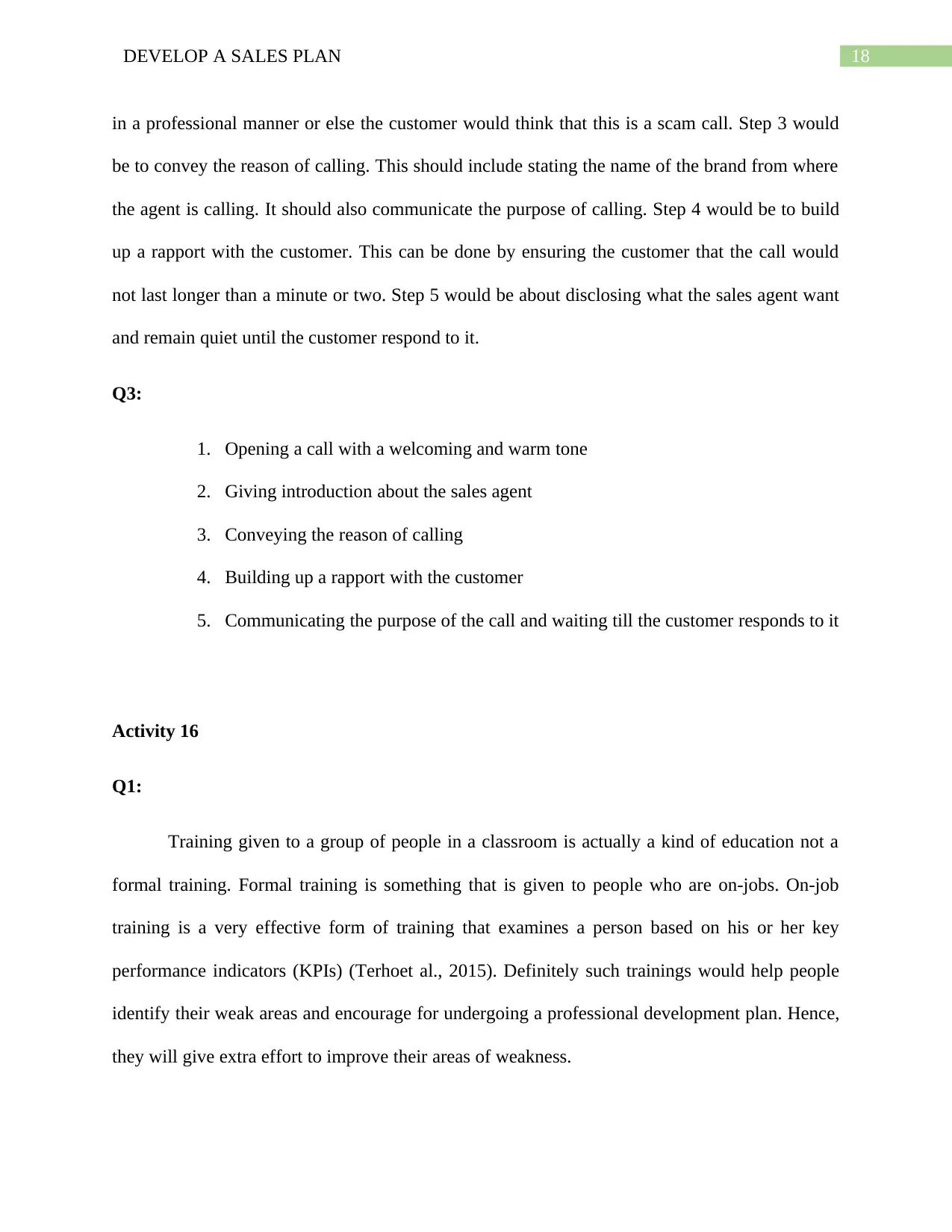
18DEVELOP A SALES PLAN
in a professional manner or else the customer would think that this is a scam call. Step 3 would
be to convey the reason of calling. This should include stating the name of the brand from where
the agent is calling. It should also communicate the purpose of calling. Step 4 would be to build
up a rapport with the customer. This can be done by ensuring the customer that the call would
not last longer than a minute or two. Step 5 would be about disclosing what the sales agent want
and remain quiet until the customer respond to it.
Q3:
1. Opening a call with a welcoming and warm tone
2. Giving introduction about the sales agent
3. Conveying the reason of calling
4. Building up a rapport with the customer
5. Communicating the purpose of the call and waiting till the customer responds to it
Activity 16
Q1:
Training given to a group of people in a classroom is actually a kind of education not a
formal training. Formal training is something that is given to people who are on-jobs. On-job
training is a very effective form of training that examines a person based on his or her key
performance indicators (KPIs) (Terhoet al., 2015). Definitely such trainings would help people
identify their weak areas and encourage for undergoing a professional development plan. Hence,
they will give extra effort to improve their areas of weakness.
in a professional manner or else the customer would think that this is a scam call. Step 3 would
be to convey the reason of calling. This should include stating the name of the brand from where
the agent is calling. It should also communicate the purpose of calling. Step 4 would be to build
up a rapport with the customer. This can be done by ensuring the customer that the call would
not last longer than a minute or two. Step 5 would be about disclosing what the sales agent want
and remain quiet until the customer respond to it.
Q3:
1. Opening a call with a welcoming and warm tone
2. Giving introduction about the sales agent
3. Conveying the reason of calling
4. Building up a rapport with the customer
5. Communicating the purpose of the call and waiting till the customer responds to it
Activity 16
Q1:
Training given to a group of people in a classroom is actually a kind of education not a
formal training. Formal training is something that is given to people who are on-jobs. On-job
training is a very effective form of training that examines a person based on his or her key
performance indicators (KPIs) (Terhoet al., 2015). Definitely such trainings would help people
identify their weak areas and encourage for undergoing a professional development plan. Hence,
they will give extra effort to improve their areas of weakness.
Paraphrase This Document
Need a fresh take? Get an instant paraphrase of this document with our AI Paraphraser
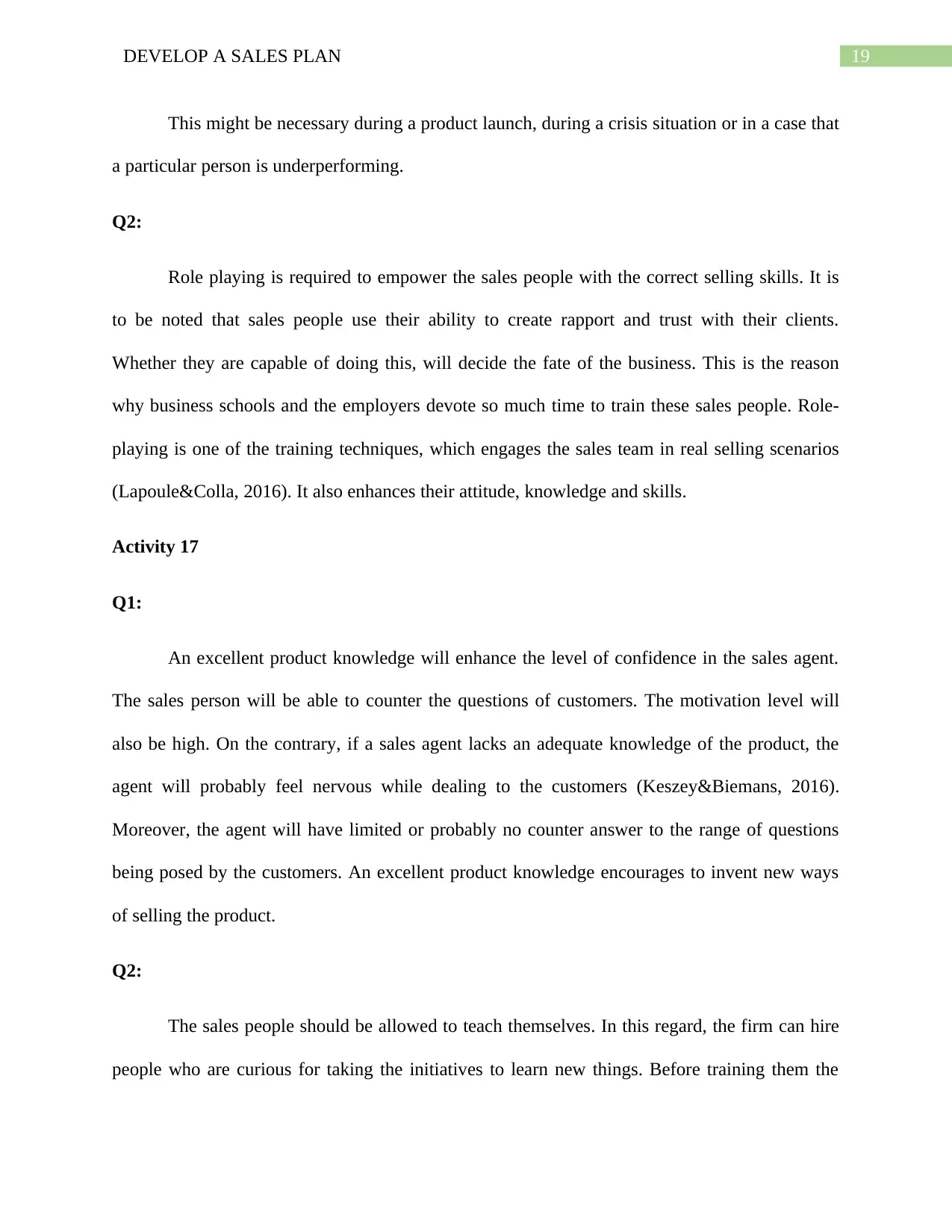
19DEVELOP A SALES PLAN
This might be necessary during a product launch, during a crisis situation or in a case that
a particular person is underperforming.
Q2:
Role playing is required to empower the sales people with the correct selling skills. It is
to be noted that sales people use their ability to create rapport and trust with their clients.
Whether they are capable of doing this, will decide the fate of the business. This is the reason
why business schools and the employers devote so much time to train these sales people. Role-
playing is one of the training techniques, which engages the sales team in real selling scenarios
(Lapoule&Colla, 2016). It also enhances their attitude, knowledge and skills.
Activity 17
Q1:
An excellent product knowledge will enhance the level of confidence in the sales agent.
The sales person will be able to counter the questions of customers. The motivation level will
also be high. On the contrary, if a sales agent lacks an adequate knowledge of the product, the
agent will probably feel nervous while dealing to the customers (Keszey&Biemans, 2016).
Moreover, the agent will have limited or probably no counter answer to the range of questions
being posed by the customers. An excellent product knowledge encourages to invent new ways
of selling the product.
Q2:
The sales people should be allowed to teach themselves. In this regard, the firm can hire
people who are curious for taking the initiatives to learn new things. Before training them the
This might be necessary during a product launch, during a crisis situation or in a case that
a particular person is underperforming.
Q2:
Role playing is required to empower the sales people with the correct selling skills. It is
to be noted that sales people use their ability to create rapport and trust with their clients.
Whether they are capable of doing this, will decide the fate of the business. This is the reason
why business schools and the employers devote so much time to train these sales people. Role-
playing is one of the training techniques, which engages the sales team in real selling scenarios
(Lapoule&Colla, 2016). It also enhances their attitude, knowledge and skills.
Activity 17
Q1:
An excellent product knowledge will enhance the level of confidence in the sales agent.
The sales person will be able to counter the questions of customers. The motivation level will
also be high. On the contrary, if a sales agent lacks an adequate knowledge of the product, the
agent will probably feel nervous while dealing to the customers (Keszey&Biemans, 2016).
Moreover, the agent will have limited or probably no counter answer to the range of questions
being posed by the customers. An excellent product knowledge encourages to invent new ways
of selling the product.
Q2:
The sales people should be allowed to teach themselves. In this regard, the firm can hire
people who are curious for taking the initiatives to learn new things. Before training them the
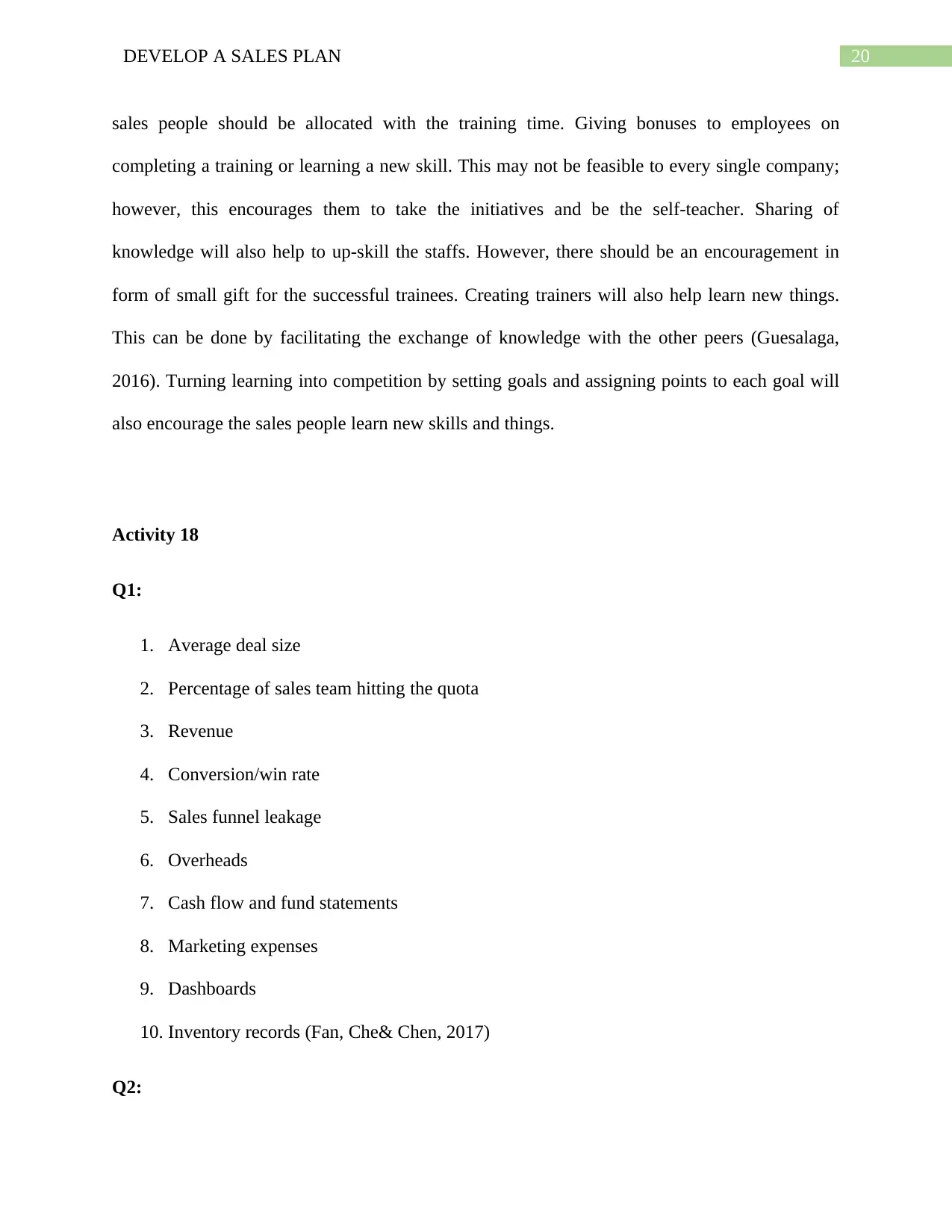
20DEVELOP A SALES PLAN
sales people should be allocated with the training time. Giving bonuses to employees on
completing a training or learning a new skill. This may not be feasible to every single company;
however, this encourages them to take the initiatives and be the self-teacher. Sharing of
knowledge will also help to up-skill the staffs. However, there should be an encouragement in
form of small gift for the successful trainees. Creating trainers will also help learn new things.
This can be done by facilitating the exchange of knowledge with the other peers (Guesalaga,
2016). Turning learning into competition by setting goals and assigning points to each goal will
also encourage the sales people learn new skills and things.
Activity 18
Q1:
1. Average deal size
2. Percentage of sales team hitting the quota
3. Revenue
4. Conversion/win rate
5. Sales funnel leakage
6. Overheads
7. Cash flow and fund statements
8. Marketing expenses
9. Dashboards
10. Inventory records (Fan, Che& Chen, 2017)
Q2:
sales people should be allocated with the training time. Giving bonuses to employees on
completing a training or learning a new skill. This may not be feasible to every single company;
however, this encourages them to take the initiatives and be the self-teacher. Sharing of
knowledge will also help to up-skill the staffs. However, there should be an encouragement in
form of small gift for the successful trainees. Creating trainers will also help learn new things.
This can be done by facilitating the exchange of knowledge with the other peers (Guesalaga,
2016). Turning learning into competition by setting goals and assigning points to each goal will
also encourage the sales people learn new skills and things.
Activity 18
Q1:
1. Average deal size
2. Percentage of sales team hitting the quota
3. Revenue
4. Conversion/win rate
5. Sales funnel leakage
6. Overheads
7. Cash flow and fund statements
8. Marketing expenses
9. Dashboards
10. Inventory records (Fan, Che& Chen, 2017)
Q2:
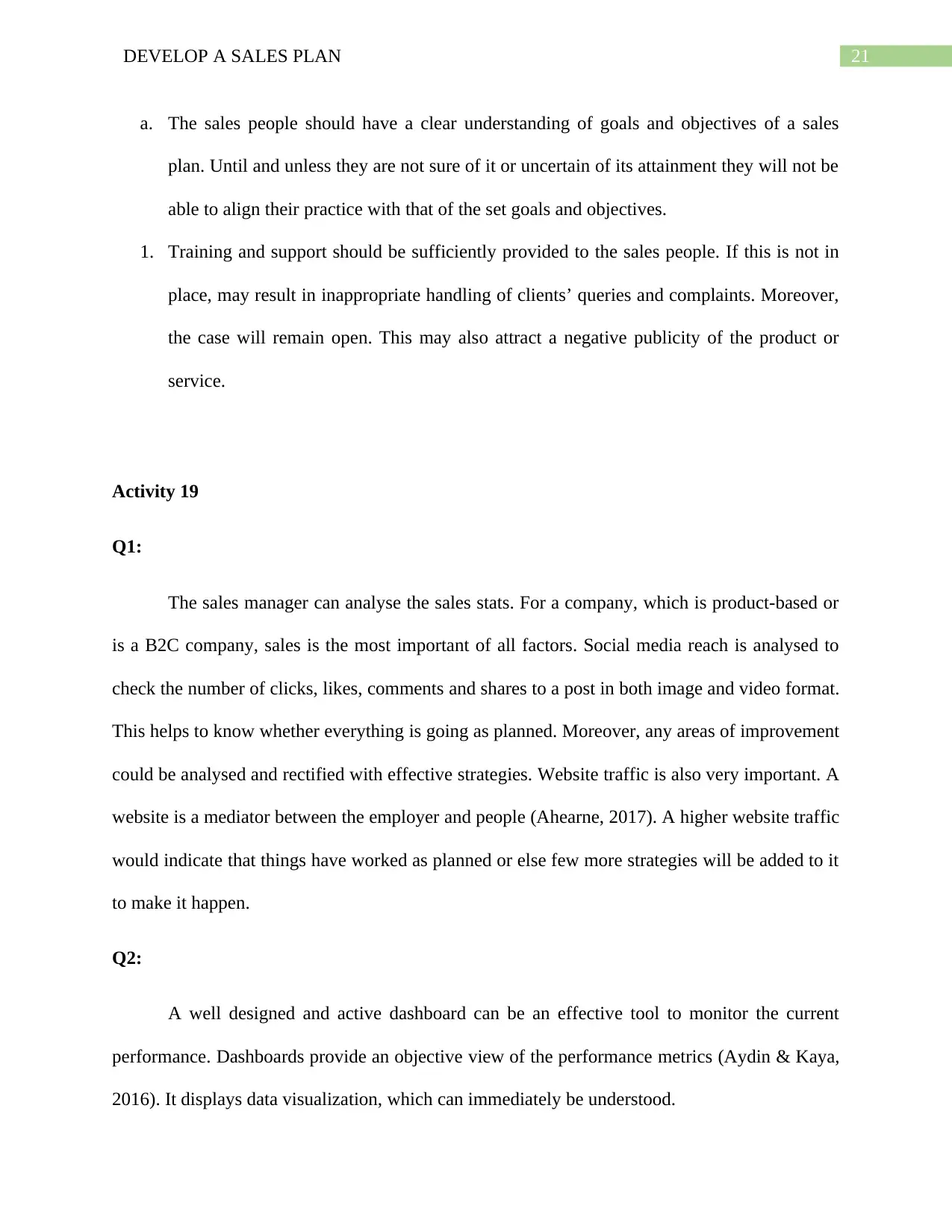
21DEVELOP A SALES PLAN
a. The sales people should have a clear understanding of goals and objectives of a sales
plan. Until and unless they are not sure of it or uncertain of its attainment they will not be
able to align their practice with that of the set goals and objectives.
1. Training and support should be sufficiently provided to the sales people. If this is not in
place, may result in inappropriate handling of clients’ queries and complaints. Moreover,
the case will remain open. This may also attract a negative publicity of the product or
service.
Activity 19
Q1:
The sales manager can analyse the sales stats. For a company, which is product-based or
is a B2C company, sales is the most important of all factors. Social media reach is analysed to
check the number of clicks, likes, comments and shares to a post in both image and video format.
This helps to know whether everything is going as planned. Moreover, any areas of improvement
could be analysed and rectified with effective strategies. Website traffic is also very important. A
website is a mediator between the employer and people (Ahearne, 2017). A higher website traffic
would indicate that things have worked as planned or else few more strategies will be added to it
to make it happen.
Q2:
A well designed and active dashboard can be an effective tool to monitor the current
performance. Dashboards provide an objective view of the performance metrics (Aydin & Kaya,
2016). It displays data visualization, which can immediately be understood.
a. The sales people should have a clear understanding of goals and objectives of a sales
plan. Until and unless they are not sure of it or uncertain of its attainment they will not be
able to align their practice with that of the set goals and objectives.
1. Training and support should be sufficiently provided to the sales people. If this is not in
place, may result in inappropriate handling of clients’ queries and complaints. Moreover,
the case will remain open. This may also attract a negative publicity of the product or
service.
Activity 19
Q1:
The sales manager can analyse the sales stats. For a company, which is product-based or
is a B2C company, sales is the most important of all factors. Social media reach is analysed to
check the number of clicks, likes, comments and shares to a post in both image and video format.
This helps to know whether everything is going as planned. Moreover, any areas of improvement
could be analysed and rectified with effective strategies. Website traffic is also very important. A
website is a mediator between the employer and people (Ahearne, 2017). A higher website traffic
would indicate that things have worked as planned or else few more strategies will be added to it
to make it happen.
Q2:
A well designed and active dashboard can be an effective tool to monitor the current
performance. Dashboards provide an objective view of the performance metrics (Aydin & Kaya,
2016). It displays data visualization, which can immediately be understood.
Secure Best Marks with AI Grader
Need help grading? Try our AI Grader for instant feedback on your assignments.
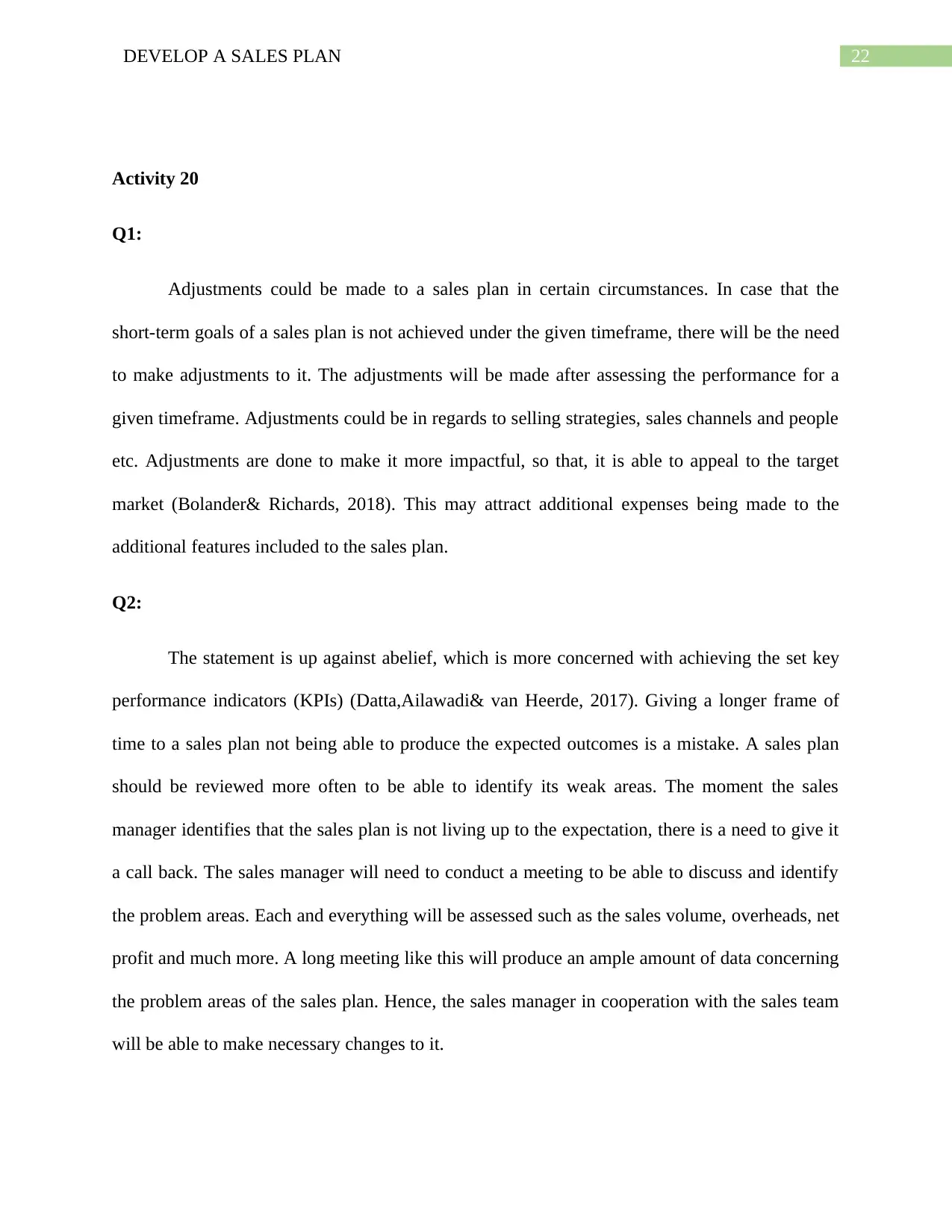
22DEVELOP A SALES PLAN
Activity 20
Q1:
Adjustments could be made to a sales plan in certain circumstances. In case that the
short-term goals of a sales plan is not achieved under the given timeframe, there will be the need
to make adjustments to it. The adjustments will be made after assessing the performance for a
given timeframe. Adjustments could be in regards to selling strategies, sales channels and people
etc. Adjustments are done to make it more impactful, so that, it is able to appeal to the target
market (Bolander& Richards, 2018). This may attract additional expenses being made to the
additional features included to the sales plan.
Q2:
The statement is up against abelief, which is more concerned with achieving the set key
performance indicators (KPIs) (Datta,Ailawadi& van Heerde, 2017). Giving a longer frame of
time to a sales plan not being able to produce the expected outcomes is a mistake. A sales plan
should be reviewed more often to be able to identify its weak areas. The moment the sales
manager identifies that the sales plan is not living up to the expectation, there is a need to give it
a call back. The sales manager will need to conduct a meeting to be able to discuss and identify
the problem areas. Each and everything will be assessed such as the sales volume, overheads, net
profit and much more. A long meeting like this will produce an ample amount of data concerning
the problem areas of the sales plan. Hence, the sales manager in cooperation with the sales team
will be able to make necessary changes to it.
Activity 20
Q1:
Adjustments could be made to a sales plan in certain circumstances. In case that the
short-term goals of a sales plan is not achieved under the given timeframe, there will be the need
to make adjustments to it. The adjustments will be made after assessing the performance for a
given timeframe. Adjustments could be in regards to selling strategies, sales channels and people
etc. Adjustments are done to make it more impactful, so that, it is able to appeal to the target
market (Bolander& Richards, 2018). This may attract additional expenses being made to the
additional features included to the sales plan.
Q2:
The statement is up against abelief, which is more concerned with achieving the set key
performance indicators (KPIs) (Datta,Ailawadi& van Heerde, 2017). Giving a longer frame of
time to a sales plan not being able to produce the expected outcomes is a mistake. A sales plan
should be reviewed more often to be able to identify its weak areas. The moment the sales
manager identifies that the sales plan is not living up to the expectation, there is a need to give it
a call back. The sales manager will need to conduct a meeting to be able to discuss and identify
the problem areas. Each and everything will be assessed such as the sales volume, overheads, net
profit and much more. A long meeting like this will produce an ample amount of data concerning
the problem areas of the sales plan. Hence, the sales manager in cooperation with the sales team
will be able to make necessary changes to it.
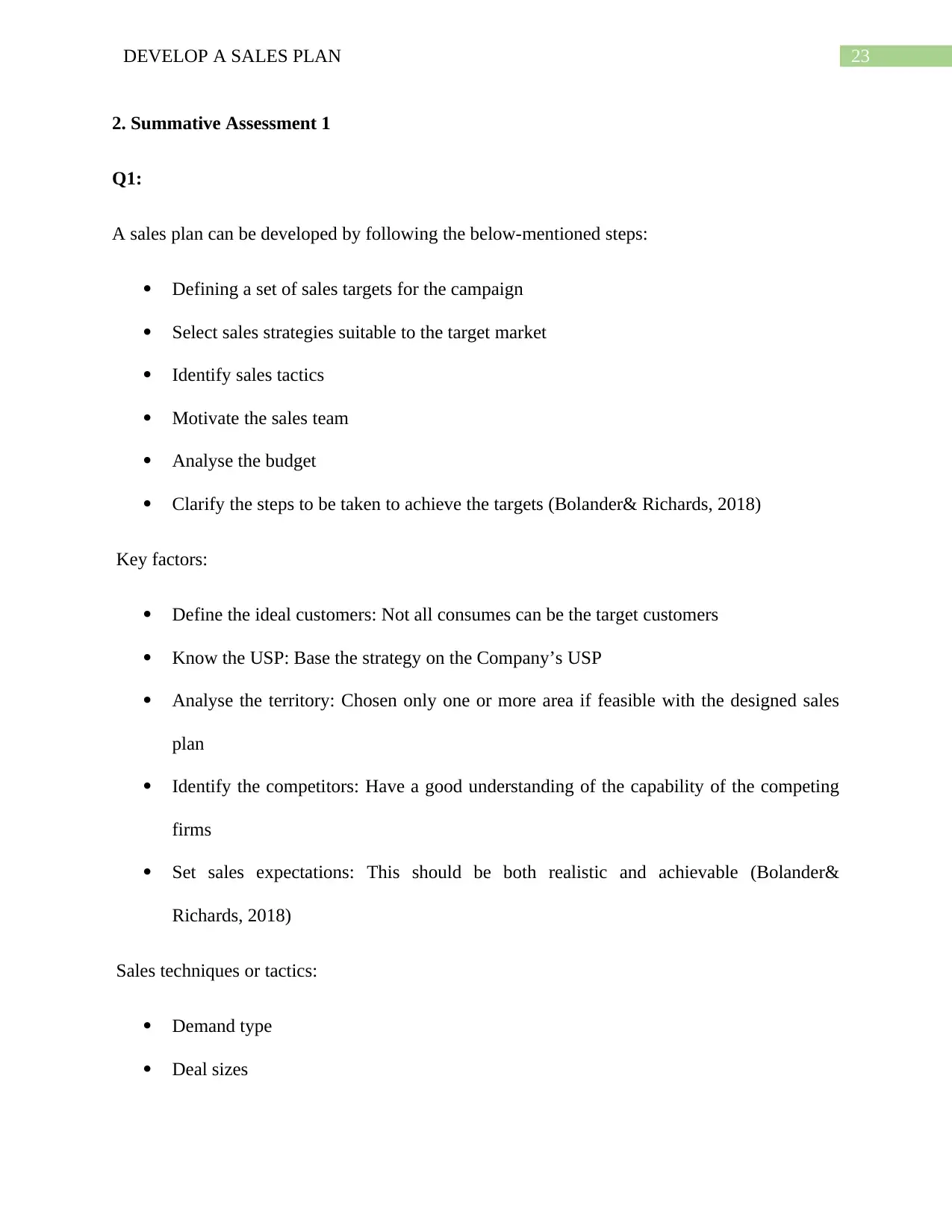
23DEVELOP A SALES PLAN
2. Summative Assessment 1
Q1:
A sales plan can be developed by following the below-mentioned steps:
Defining a set of sales targets for the campaign
Select sales strategies suitable to the target market
Identify sales tactics
Motivate the sales team
Analyse the budget
Clarify the steps to be taken to achieve the targets (Bolander& Richards, 2018)
Key factors:
Define the ideal customers: Not all consumes can be the target customers
Know the USP: Base the strategy on the Company’s USP
Analyse the territory: Chosen only one or more area if feasible with the designed sales
plan
Identify the competitors: Have a good understanding of the capability of the competing
firms
Set sales expectations: This should be both realistic and achievable (Bolander&
Richards, 2018)
Sales techniques or tactics:
Demand type
Deal sizes
2. Summative Assessment 1
Q1:
A sales plan can be developed by following the below-mentioned steps:
Defining a set of sales targets for the campaign
Select sales strategies suitable to the target market
Identify sales tactics
Motivate the sales team
Analyse the budget
Clarify the steps to be taken to achieve the targets (Bolander& Richards, 2018)
Key factors:
Define the ideal customers: Not all consumes can be the target customers
Know the USP: Base the strategy on the Company’s USP
Analyse the territory: Chosen only one or more area if feasible with the designed sales
plan
Identify the competitors: Have a good understanding of the capability of the competing
firms
Set sales expectations: This should be both realistic and achievable (Bolander&
Richards, 2018)
Sales techniques or tactics:
Demand type
Deal sizes

24DEVELOP A SALES PLAN
One time vs. renewing revenue (Bolander& Richards, 2018)
Q 2:
Setting goals and tracking those during the year is one of the ways to monitor the sales
outcomes. Distribution analysis will also educate on the sales volume and hence, the sales
outcomes. Margin analysis is another way that can be used to monitor the sales outcomes. This
will help to know about the items that contributed largely to the sales. Following the result
adjustments can be made to both low and high-margin items. Growth analysis is another tool
where the sales manager needs to assess the performance by distribution channel, geographic
area, sales and items representatives. Metrics analysis will help to differentiate between the
larger and less selling items (Fan, Che& Chen, 2017).
Q3:
Data is the raw information, which are used to create statistics. Statistics provide an
interpretation and summary of the collected data.
Statistical data can be used to learn the below-mentioned things:
Sales figures: Statistical data present a very good understanding of the sales figures. Such
data can also be analysed.
Research on customers’ return frequency
Financial trends
Industry specific numbers of product’ sales
Phone or online questionnaires (Gallino, Moreno&Stamatopoulos, 2016)
One time vs. renewing revenue (Bolander& Richards, 2018)
Q 2:
Setting goals and tracking those during the year is one of the ways to monitor the sales
outcomes. Distribution analysis will also educate on the sales volume and hence, the sales
outcomes. Margin analysis is another way that can be used to monitor the sales outcomes. This
will help to know about the items that contributed largely to the sales. Following the result
adjustments can be made to both low and high-margin items. Growth analysis is another tool
where the sales manager needs to assess the performance by distribution channel, geographic
area, sales and items representatives. Metrics analysis will help to differentiate between the
larger and less selling items (Fan, Che& Chen, 2017).
Q3:
Data is the raw information, which are used to create statistics. Statistics provide an
interpretation and summary of the collected data.
Statistical data can be used to learn the below-mentioned things:
Sales figures: Statistical data present a very good understanding of the sales figures. Such
data can also be analysed.
Research on customers’ return frequency
Financial trends
Industry specific numbers of product’ sales
Phone or online questionnaires (Gallino, Moreno&Stamatopoulos, 2016)
Paraphrase This Document
Need a fresh take? Get an instant paraphrase of this document with our AI Paraphraser
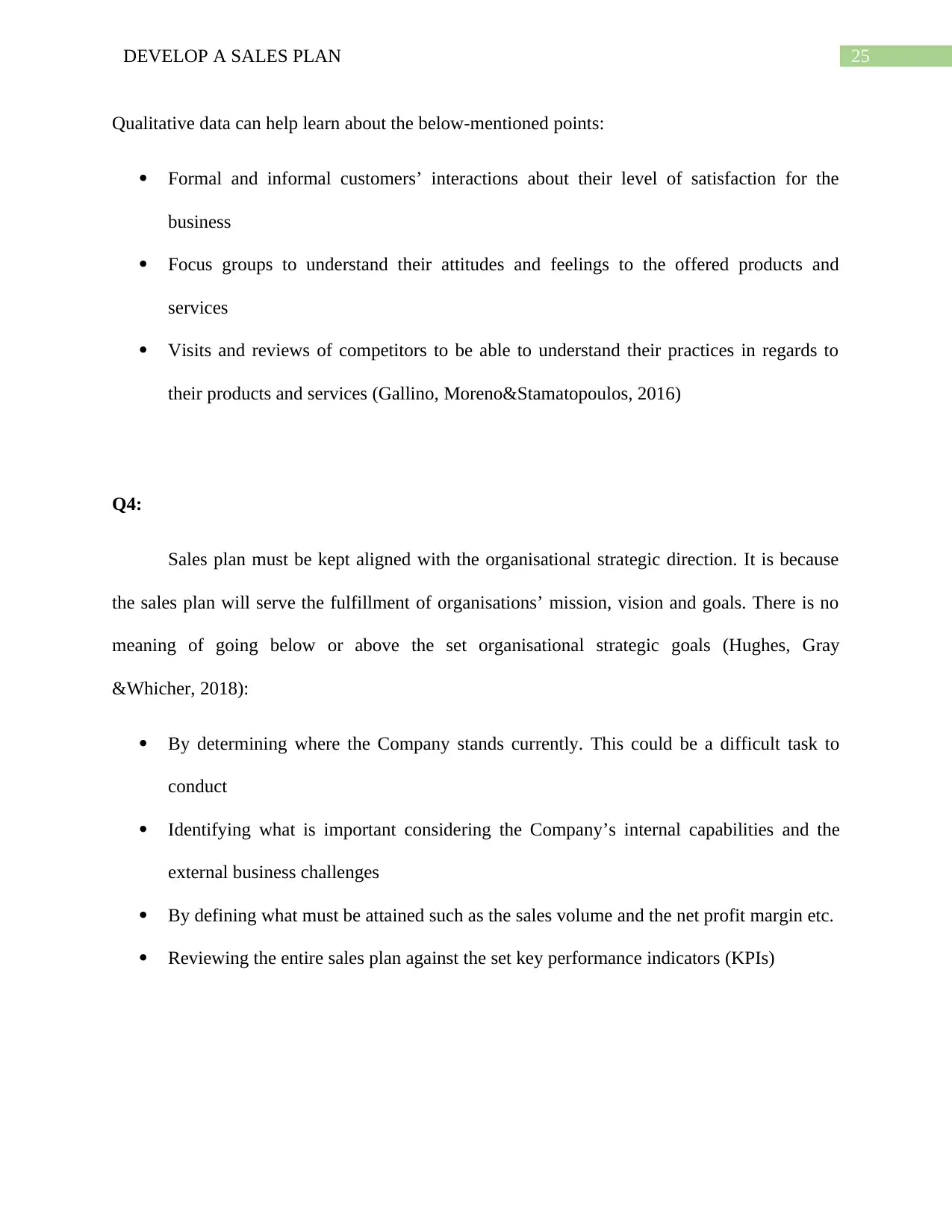
25DEVELOP A SALES PLAN
Qualitative data can help learn about the below-mentioned points:
Formal and informal customers’ interactions about their level of satisfaction for the
business
Focus groups to understand their attitudes and feelings to the offered products and
services
Visits and reviews of competitors to be able to understand their practices in regards to
their products and services (Gallino, Moreno&Stamatopoulos, 2016)
Q4:
Sales plan must be kept aligned with the organisational strategic direction. It is because
the sales plan will serve the fulfillment of organisations’ mission, vision and goals. There is no
meaning of going below or above the set organisational strategic goals (Hughes, Gray
&Whicher, 2018):
By determining where the Company stands currently. This could be a difficult task to
conduct
Identifying what is important considering the Company’s internal capabilities and the
external business challenges
By defining what must be attained such as the sales volume and the net profit margin etc.
Reviewing the entire sales plan against the set key performance indicators (KPIs)
Qualitative data can help learn about the below-mentioned points:
Formal and informal customers’ interactions about their level of satisfaction for the
business
Focus groups to understand their attitudes and feelings to the offered products and
services
Visits and reviews of competitors to be able to understand their practices in regards to
their products and services (Gallino, Moreno&Stamatopoulos, 2016)
Q4:
Sales plan must be kept aligned with the organisational strategic direction. It is because
the sales plan will serve the fulfillment of organisations’ mission, vision and goals. There is no
meaning of going below or above the set organisational strategic goals (Hughes, Gray
&Whicher, 2018):
By determining where the Company stands currently. This could be a difficult task to
conduct
Identifying what is important considering the Company’s internal capabilities and the
external business challenges
By defining what must be attained such as the sales volume and the net profit margin etc.
Reviewing the entire sales plan against the set key performance indicators (KPIs)
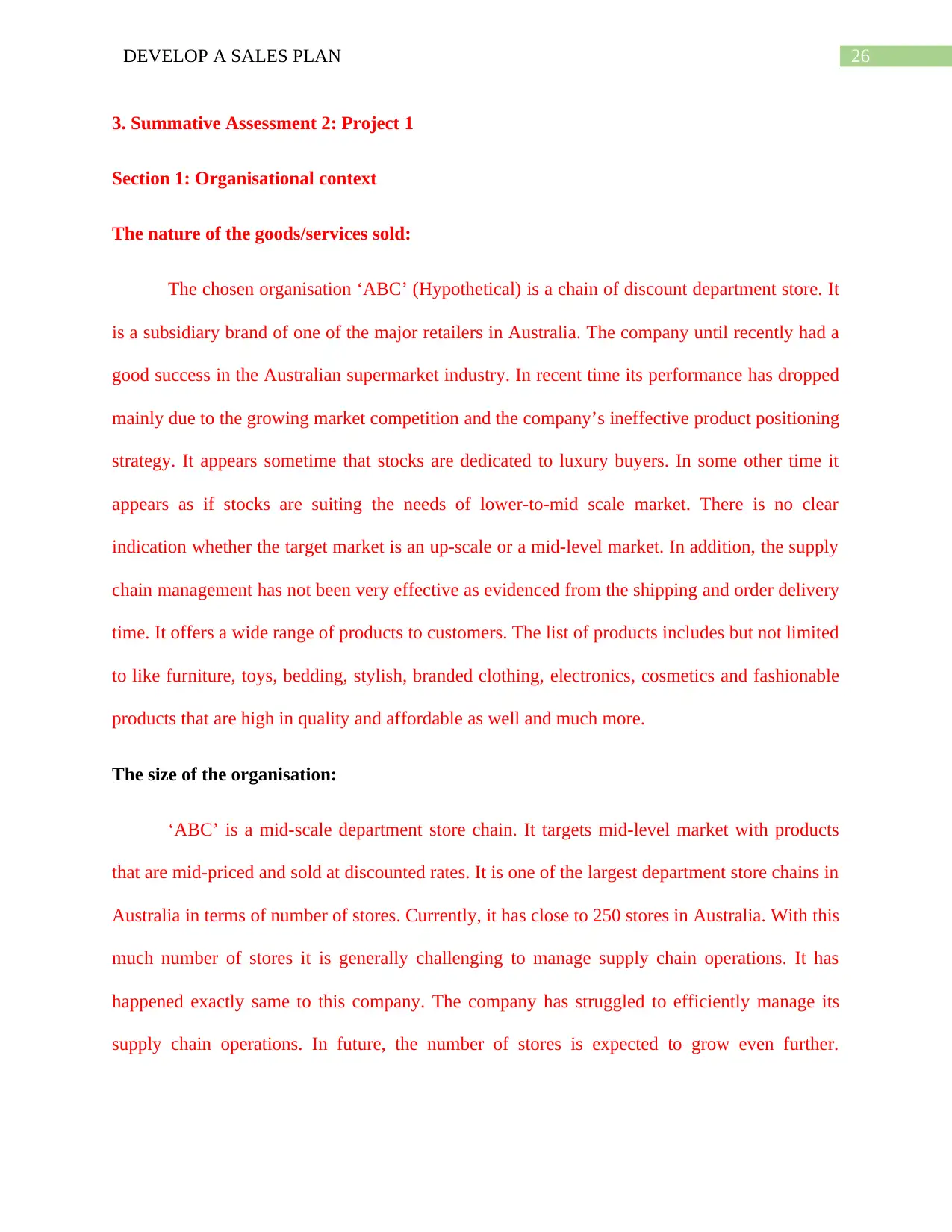
26DEVELOP A SALES PLAN
3. Summative Assessment 2: Project 1
Section 1: Organisational context
The nature of the goods/services sold:
The chosen organisation ‘ABC’ (Hypothetical) is a chain of discount department store. It
is a subsidiary brand of one of the major retailers in Australia. The company until recently had a
good success in the Australian supermarket industry. In recent time its performance has dropped
mainly due to the growing market competition and the company’s ineffective product positioning
strategy. It appears sometime that stocks are dedicated to luxury buyers. In some other time it
appears as if stocks are suiting the needs of lower-to-mid scale market. There is no clear
indication whether the target market is an up-scale or a mid-level market. In addition, the supply
chain management has not been very effective as evidenced from the shipping and order delivery
time. It offers a wide range of products to customers. The list of products includes but not limited
to like furniture, toys, bedding, stylish, branded clothing, electronics, cosmetics and fashionable
products that are high in quality and affordable as well and much more.
The size of the organisation:
‘ABC’ is a mid-scale department store chain. It targets mid-level market with products
that are mid-priced and sold at discounted rates. It is one of the largest department store chains in
Australia in terms of number of stores. Currently, it has close to 250 stores in Australia. With this
much number of stores it is generally challenging to manage supply chain operations. It has
happened exactly same to this company. The company has struggled to efficiently manage its
supply chain operations. In future, the number of stores is expected to grow even further.
3. Summative Assessment 2: Project 1
Section 1: Organisational context
The nature of the goods/services sold:
The chosen organisation ‘ABC’ (Hypothetical) is a chain of discount department store. It
is a subsidiary brand of one of the major retailers in Australia. The company until recently had a
good success in the Australian supermarket industry. In recent time its performance has dropped
mainly due to the growing market competition and the company’s ineffective product positioning
strategy. It appears sometime that stocks are dedicated to luxury buyers. In some other time it
appears as if stocks are suiting the needs of lower-to-mid scale market. There is no clear
indication whether the target market is an up-scale or a mid-level market. In addition, the supply
chain management has not been very effective as evidenced from the shipping and order delivery
time. It offers a wide range of products to customers. The list of products includes but not limited
to like furniture, toys, bedding, stylish, branded clothing, electronics, cosmetics and fashionable
products that are high in quality and affordable as well and much more.
The size of the organisation:
‘ABC’ is a mid-scale department store chain. It targets mid-level market with products
that are mid-priced and sold at discounted rates. It is one of the largest department store chains in
Australia in terms of number of stores. Currently, it has close to 250 stores in Australia. With this
much number of stores it is generally challenging to manage supply chain operations. It has
happened exactly same to this company. The company has struggled to efficiently manage its
supply chain operations. In future, the number of stores is expected to grow even further.
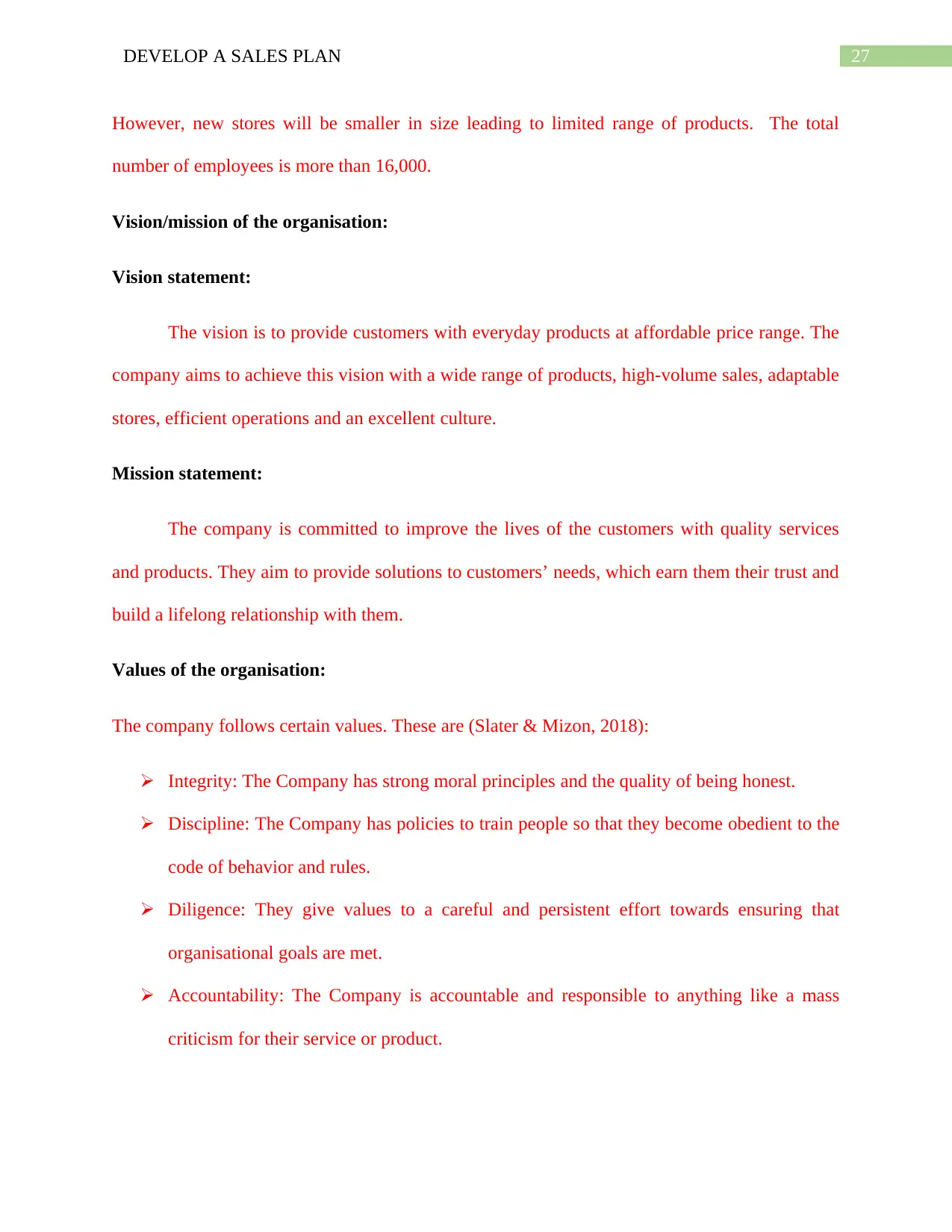
27DEVELOP A SALES PLAN
However, new stores will be smaller in size leading to limited range of products. The total
number of employees is more than 16,000.
Vision/mission of the organisation:
Vision statement:
The vision is to provide customers with everyday products at affordable price range. The
company aims to achieve this vision with a wide range of products, high-volume sales, adaptable
stores, efficient operations and an excellent culture.
Mission statement:
The company is committed to improve the lives of the customers with quality services
and products. They aim to provide solutions to customers’ needs, which earn them their trust and
build a lifelong relationship with them.
Values of the organisation:
The company follows certain values. These are (Slater & Mizon, 2018):
Integrity: The Company has strong moral principles and the quality of being honest.
Discipline: The Company has policies to train people so that they become obedient to the
code of behavior and rules.
Diligence: They give values to a careful and persistent effort towards ensuring that
organisational goals are met.
Accountability: The Company is accountable and responsible to anything like a mass
criticism for their service or product.
However, new stores will be smaller in size leading to limited range of products. The total
number of employees is more than 16,000.
Vision/mission of the organisation:
Vision statement:
The vision is to provide customers with everyday products at affordable price range. The
company aims to achieve this vision with a wide range of products, high-volume sales, adaptable
stores, efficient operations and an excellent culture.
Mission statement:
The company is committed to improve the lives of the customers with quality services
and products. They aim to provide solutions to customers’ needs, which earn them their trust and
build a lifelong relationship with them.
Values of the organisation:
The company follows certain values. These are (Slater & Mizon, 2018):
Integrity: The Company has strong moral principles and the quality of being honest.
Discipline: The Company has policies to train people so that they become obedient to the
code of behavior and rules.
Diligence: They give values to a careful and persistent effort towards ensuring that
organisational goals are met.
Accountability: The Company is accountable and responsible to anything like a mass
criticism for their service or product.
Secure Best Marks with AI Grader
Need help grading? Try our AI Grader for instant feedback on your assignments.
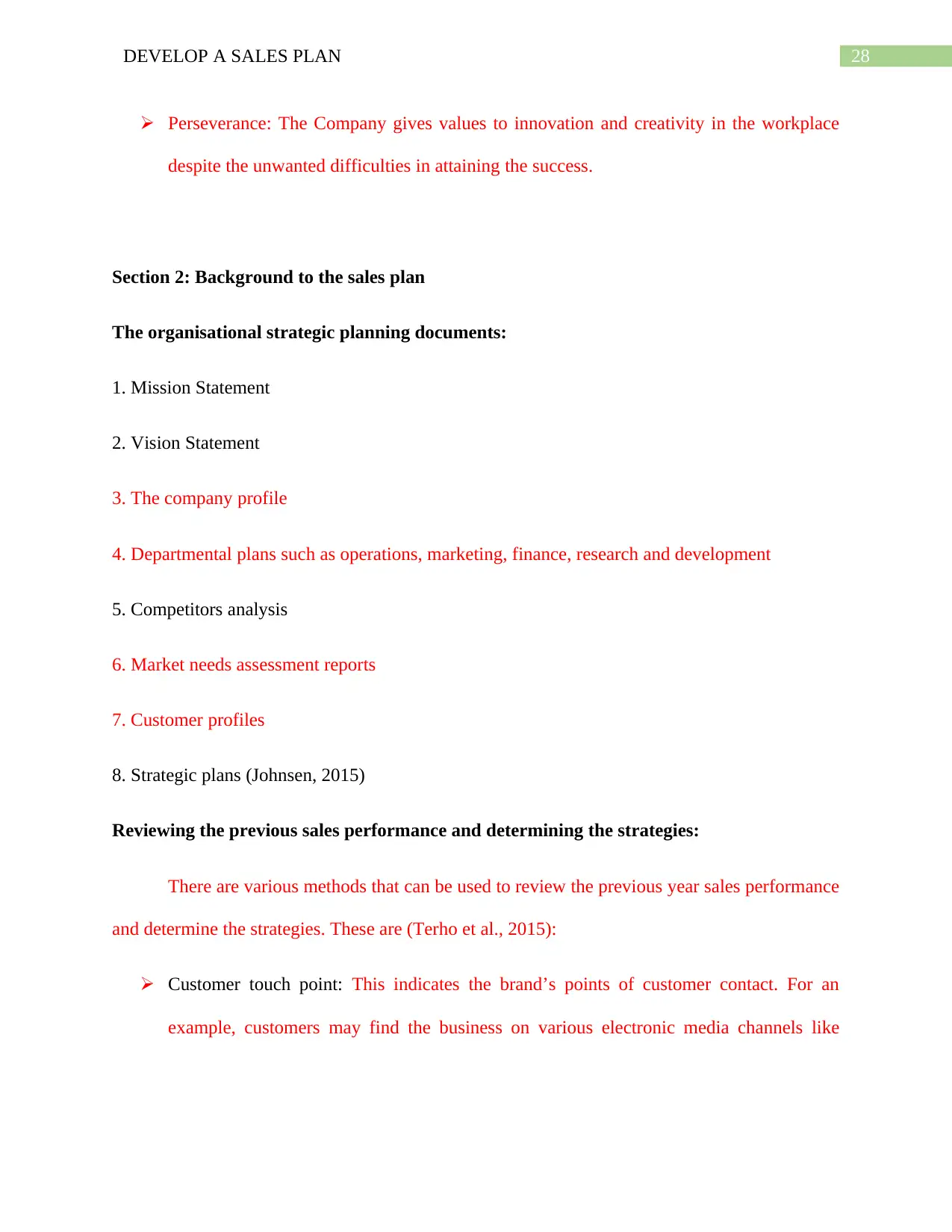
28DEVELOP A SALES PLAN
Perseverance: The Company gives values to innovation and creativity in the workplace
despite the unwanted difficulties in attaining the success.
Section 2: Background to the sales plan
The organisational strategic planning documents:
1. Mission Statement
2. Vision Statement
3. The company profile
4. Departmental plans such as operations, marketing, finance, research and development
5. Competitors analysis
6. Market needs assessment reports
7. Customer profiles
8. Strategic plans (Johnsen, 2015)
Reviewing the previous sales performance and determining the strategies:
There are various methods that can be used to review the previous year sales performance
and determine the strategies. These are (Terho et al., 2015):
Customer touch point: This indicates the brand’s points of customer contact. For an
example, customers may find the business on various electronic media channels like
Perseverance: The Company gives values to innovation and creativity in the workplace
despite the unwanted difficulties in attaining the success.
Section 2: Background to the sales plan
The organisational strategic planning documents:
1. Mission Statement
2. Vision Statement
3. The company profile
4. Departmental plans such as operations, marketing, finance, research and development
5. Competitors analysis
6. Market needs assessment reports
7. Customer profiles
8. Strategic plans (Johnsen, 2015)
Reviewing the previous sales performance and determining the strategies:
There are various methods that can be used to review the previous year sales performance
and determine the strategies. These are (Terho et al., 2015):
Customer touch point: This indicates the brand’s points of customer contact. For an
example, customers may find the business on various electronic media channels like
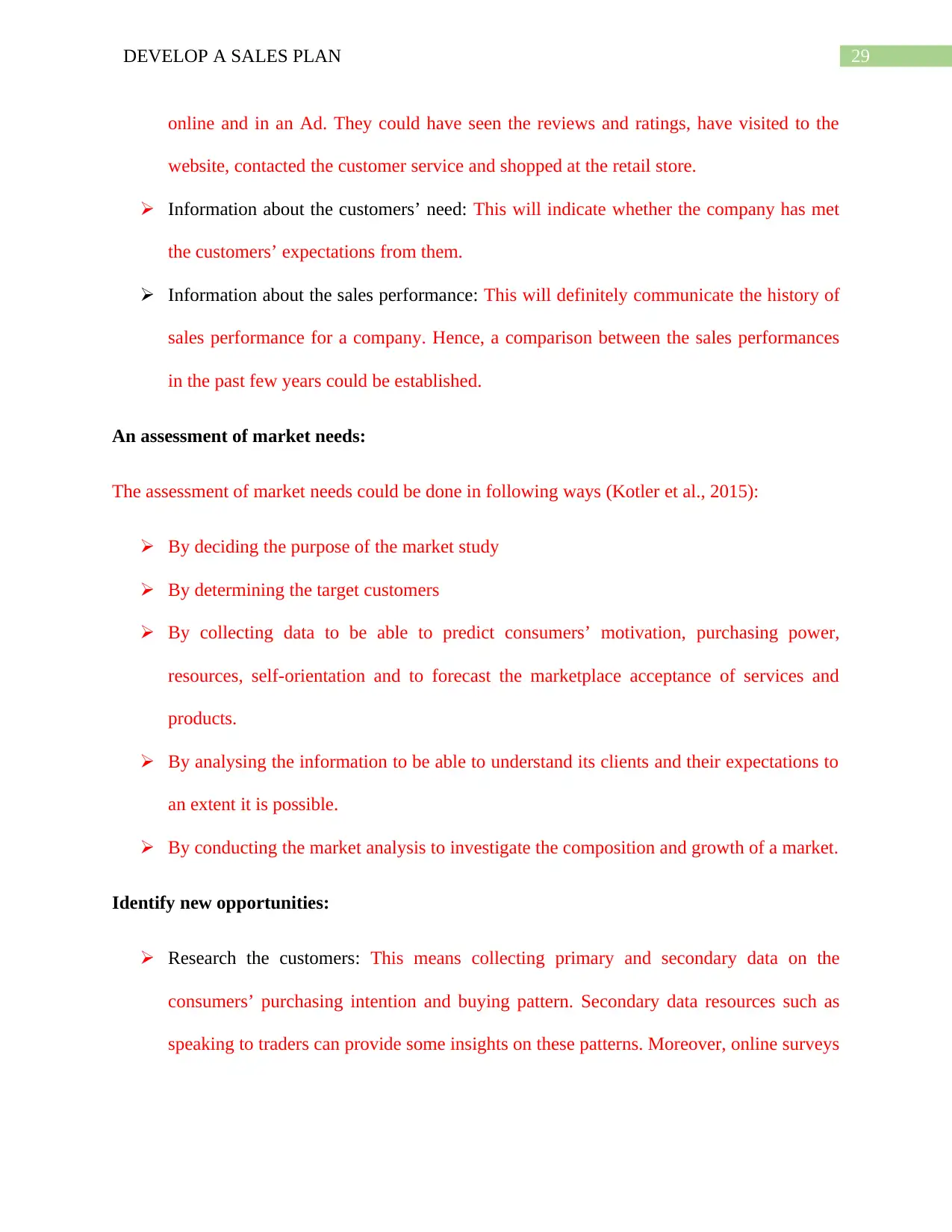
29DEVELOP A SALES PLAN
online and in an Ad. They could have seen the reviews and ratings, have visited to the
website, contacted the customer service and shopped at the retail store.
Information about the customers’ need: This will indicate whether the company has met
the customers’ expectations from them.
Information about the sales performance: This will definitely communicate the history of
sales performance for a company. Hence, a comparison between the sales performances
in the past few years could be established.
An assessment of market needs:
The assessment of market needs could be done in following ways (Kotler et al., 2015):
By deciding the purpose of the market study
By determining the target customers
By collecting data to be able to predict consumers’ motivation, purchasing power,
resources, self-orientation and to forecast the marketplace acceptance of services and
products.
By analysing the information to be able to understand its clients and their expectations to
an extent it is possible.
By conducting the market analysis to investigate the composition and growth of a market.
Identify new opportunities:
Research the customers: This means collecting primary and secondary data on the
consumers’ purchasing intention and buying pattern. Secondary data resources such as
speaking to traders can provide some insights on these patterns. Moreover, online surveys
online and in an Ad. They could have seen the reviews and ratings, have visited to the
website, contacted the customer service and shopped at the retail store.
Information about the customers’ need: This will indicate whether the company has met
the customers’ expectations from them.
Information about the sales performance: This will definitely communicate the history of
sales performance for a company. Hence, a comparison between the sales performances
in the past few years could be established.
An assessment of market needs:
The assessment of market needs could be done in following ways (Kotler et al., 2015):
By deciding the purpose of the market study
By determining the target customers
By collecting data to be able to predict consumers’ motivation, purchasing power,
resources, self-orientation and to forecast the marketplace acceptance of services and
products.
By analysing the information to be able to understand its clients and their expectations to
an extent it is possible.
By conducting the market analysis to investigate the composition and growth of a market.
Identify new opportunities:
Research the customers: This means collecting primary and secondary data on the
consumers’ purchasing intention and buying pattern. Secondary data resources such as
speaking to traders can provide some insights on these patterns. Moreover, online surveys
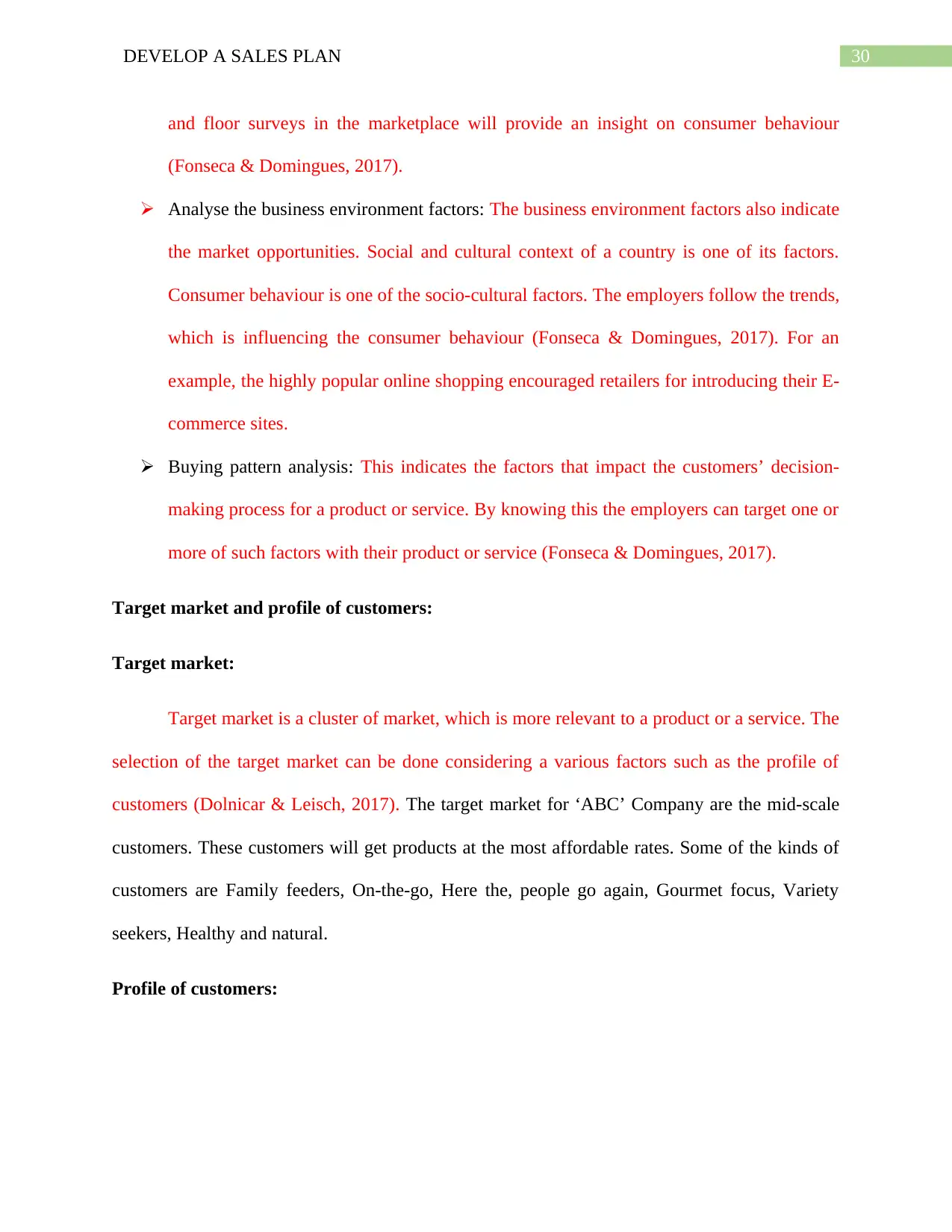
30DEVELOP A SALES PLAN
and floor surveys in the marketplace will provide an insight on consumer behaviour
(Fonseca & Domingues, 2017).
Analyse the business environment factors: The business environment factors also indicate
the market opportunities. Social and cultural context of a country is one of its factors.
Consumer behaviour is one of the socio-cultural factors. The employers follow the trends,
which is influencing the consumer behaviour (Fonseca & Domingues, 2017). For an
example, the highly popular online shopping encouraged retailers for introducing their E-
commerce sites.
Buying pattern analysis: This indicates the factors that impact the customers’ decision-
making process for a product or service. By knowing this the employers can target one or
more of such factors with their product or service (Fonseca & Domingues, 2017).
Target market and profile of customers:
Target market:
Target market is a cluster of market, which is more relevant to a product or a service. The
selection of the target market can be done considering a various factors such as the profile of
customers (Dolnicar & Leisch, 2017). The target market for ‘ABC’ Company are the mid-scale
customers. These customers will get products at the most affordable rates. Some of the kinds of
customers are Family feeders, On-the-go, Here the, people go again, Gourmet focus, Variety
seekers, Healthy and natural.
Profile of customers:
and floor surveys in the marketplace will provide an insight on consumer behaviour
(Fonseca & Domingues, 2017).
Analyse the business environment factors: The business environment factors also indicate
the market opportunities. Social and cultural context of a country is one of its factors.
Consumer behaviour is one of the socio-cultural factors. The employers follow the trends,
which is influencing the consumer behaviour (Fonseca & Domingues, 2017). For an
example, the highly popular online shopping encouraged retailers for introducing their E-
commerce sites.
Buying pattern analysis: This indicates the factors that impact the customers’ decision-
making process for a product or service. By knowing this the employers can target one or
more of such factors with their product or service (Fonseca & Domingues, 2017).
Target market and profile of customers:
Target market:
Target market is a cluster of market, which is more relevant to a product or a service. The
selection of the target market can be done considering a various factors such as the profile of
customers (Dolnicar & Leisch, 2017). The target market for ‘ABC’ Company are the mid-scale
customers. These customers will get products at the most affordable rates. Some of the kinds of
customers are Family feeders, On-the-go, Here the, people go again, Gourmet focus, Variety
seekers, Healthy and natural.
Profile of customers:
Paraphrase This Document
Need a fresh take? Get an instant paraphrase of this document with our AI Paraphraser
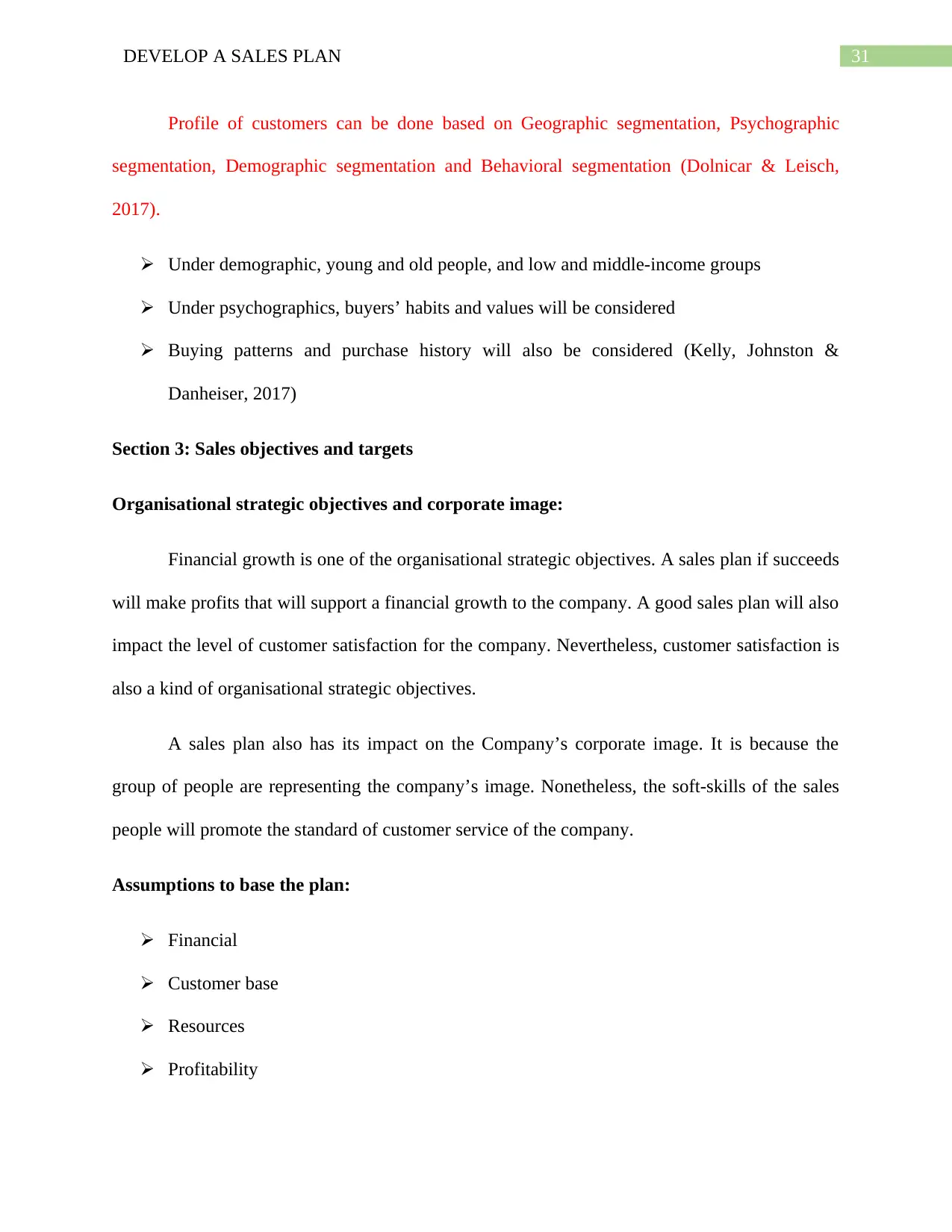
31DEVELOP A SALES PLAN
Profile of customers can be done based on Geographic segmentation, Psychographic
segmentation, Demographic segmentation and Behavioral segmentation (Dolnicar & Leisch,
2017).
Under demographic, young and old people, and low and middle-income groups
Under psychographics, buyers’ habits and values will be considered
Buying patterns and purchase history will also be considered (Kelly, Johnston &
Danheiser, 2017)
Section 3: Sales objectives and targets
Organisational strategic objectives and corporate image:
Financial growth is one of the organisational strategic objectives. A sales plan if succeeds
will make profits that will support a financial growth to the company. A good sales plan will also
impact the level of customer satisfaction for the company. Nevertheless, customer satisfaction is
also a kind of organisational strategic objectives.
A sales plan also has its impact on the Company’s corporate image. It is because the
group of people are representing the company’s image. Nonetheless, the soft-skills of the sales
people will promote the standard of customer service of the company.
Assumptions to base the plan:
Financial
Customer base
Resources
Profitability
Profile of customers can be done based on Geographic segmentation, Psychographic
segmentation, Demographic segmentation and Behavioral segmentation (Dolnicar & Leisch,
2017).
Under demographic, young and old people, and low and middle-income groups
Under psychographics, buyers’ habits and values will be considered
Buying patterns and purchase history will also be considered (Kelly, Johnston &
Danheiser, 2017)
Section 3: Sales objectives and targets
Organisational strategic objectives and corporate image:
Financial growth is one of the organisational strategic objectives. A sales plan if succeeds
will make profits that will support a financial growth to the company. A good sales plan will also
impact the level of customer satisfaction for the company. Nevertheless, customer satisfaction is
also a kind of organisational strategic objectives.
A sales plan also has its impact on the Company’s corporate image. It is because the
group of people are representing the company’s image. Nonetheless, the soft-skills of the sales
people will promote the standard of customer service of the company.
Assumptions to base the plan:
Financial
Customer base
Resources
Profitability
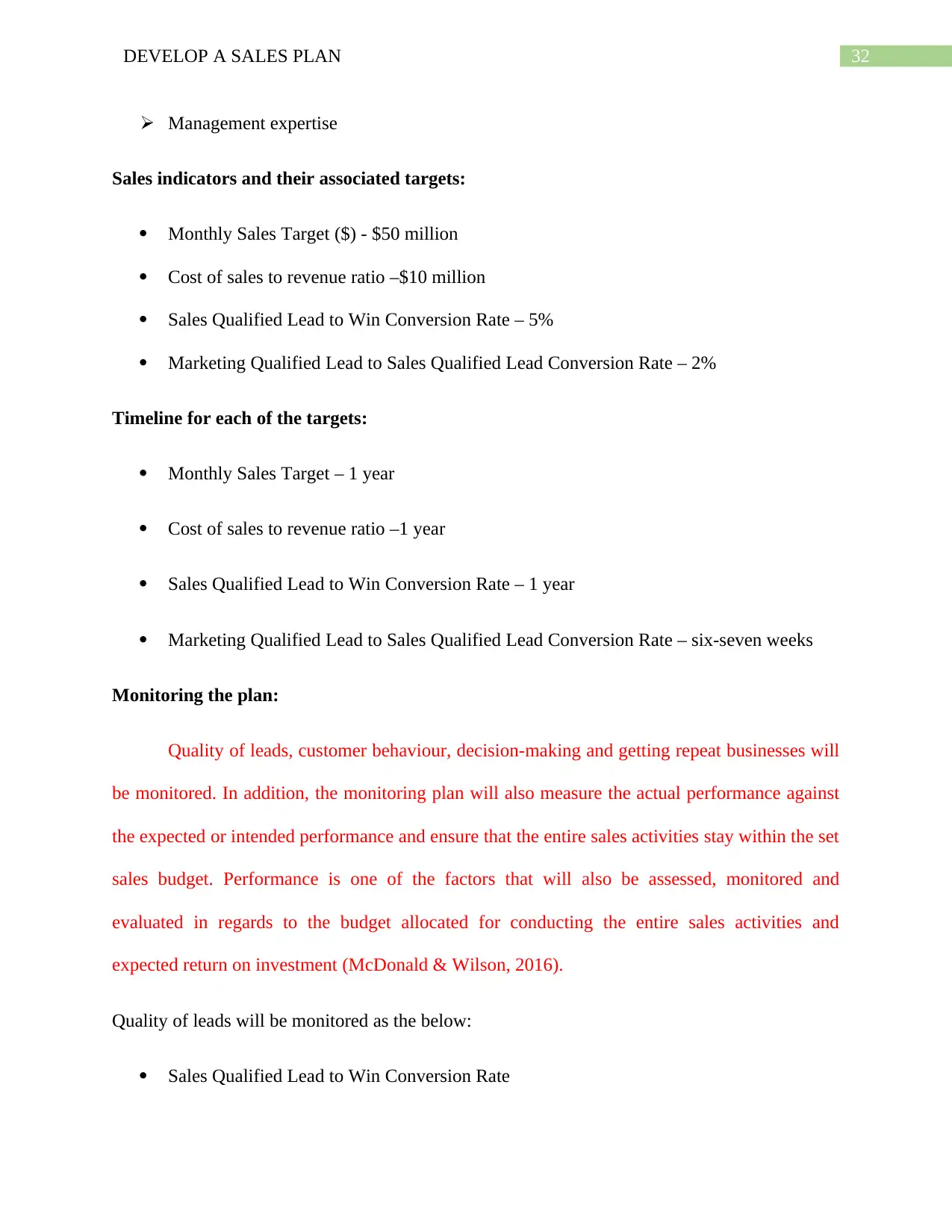
32DEVELOP A SALES PLAN
Management expertise
Sales indicators and their associated targets:
Monthly Sales Target ($) - $50 million
Cost of sales to revenue ratio –$10 million
Sales Qualified Lead to Win Conversion Rate – 5%
Marketing Qualified Lead to Sales Qualified Lead Conversion Rate – 2%
Timeline for each of the targets:
Monthly Sales Target – 1 year
Cost of sales to revenue ratio –1 year
Sales Qualified Lead to Win Conversion Rate – 1 year
Marketing Qualified Lead to Sales Qualified Lead Conversion Rate – six-seven weeks
Monitoring the plan:
Quality of leads, customer behaviour, decision-making and getting repeat businesses will
be monitored. In addition, the monitoring plan will also measure the actual performance against
the expected or intended performance and ensure that the entire sales activities stay within the set
sales budget. Performance is one of the factors that will also be assessed, monitored and
evaluated in regards to the budget allocated for conducting the entire sales activities and
expected return on investment (McDonald & Wilson, 2016).
Quality of leads will be monitored as the below:
Sales Qualified Lead to Win Conversion Rate
Management expertise
Sales indicators and their associated targets:
Monthly Sales Target ($) - $50 million
Cost of sales to revenue ratio –$10 million
Sales Qualified Lead to Win Conversion Rate – 5%
Marketing Qualified Lead to Sales Qualified Lead Conversion Rate – 2%
Timeline for each of the targets:
Monthly Sales Target – 1 year
Cost of sales to revenue ratio –1 year
Sales Qualified Lead to Win Conversion Rate – 1 year
Marketing Qualified Lead to Sales Qualified Lead Conversion Rate – six-seven weeks
Monitoring the plan:
Quality of leads, customer behaviour, decision-making and getting repeat businesses will
be monitored. In addition, the monitoring plan will also measure the actual performance against
the expected or intended performance and ensure that the entire sales activities stay within the set
sales budget. Performance is one of the factors that will also be assessed, monitored and
evaluated in regards to the budget allocated for conducting the entire sales activities and
expected return on investment (McDonald & Wilson, 2016).
Quality of leads will be monitored as the below:
Sales Qualified Lead to Win Conversion Rate
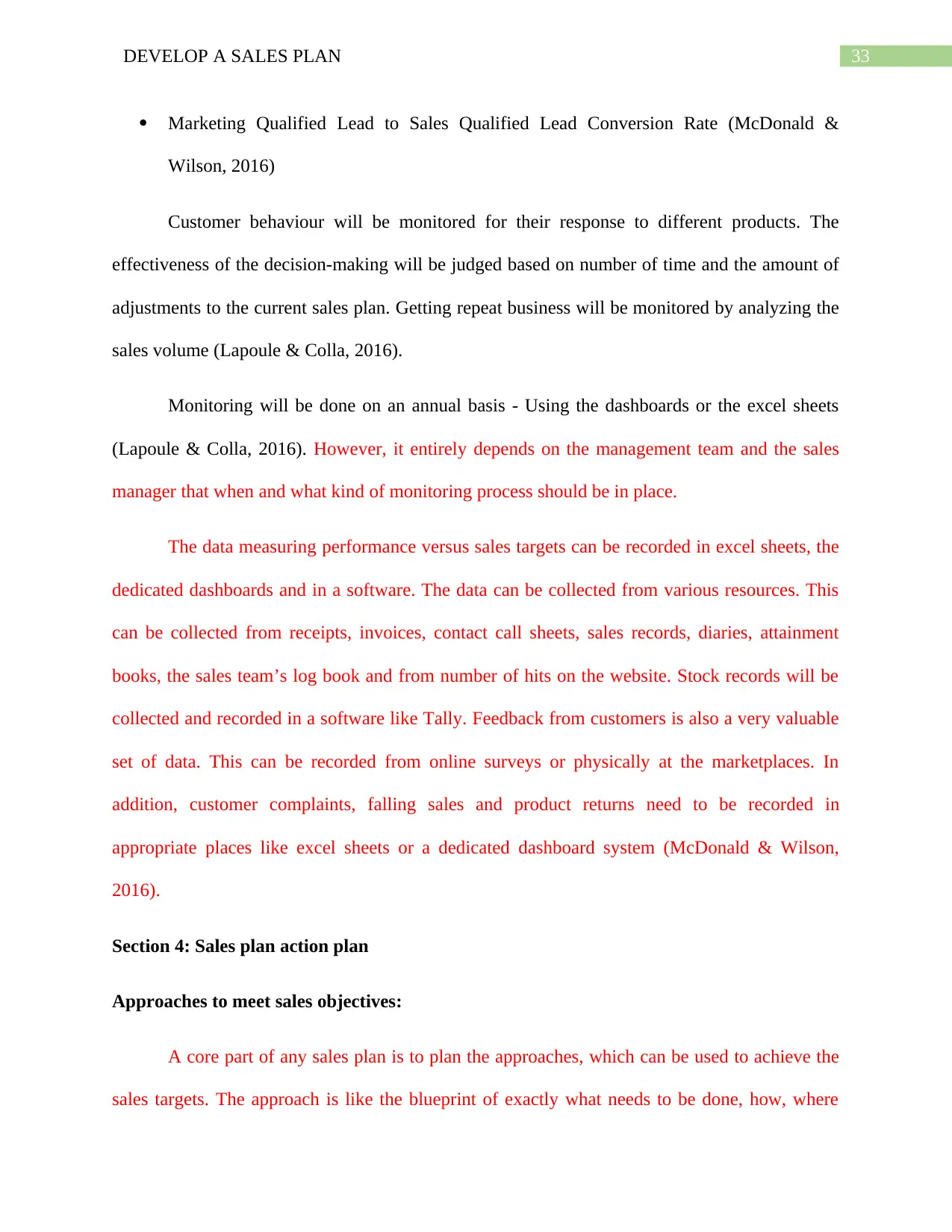
33DEVELOP A SALES PLAN
Marketing Qualified Lead to Sales Qualified Lead Conversion Rate (McDonald &
Wilson, 2016)
Customer behaviour will be monitored for their response to different products. The
effectiveness of the decision-making will be judged based on number of time and the amount of
adjustments to the current sales plan. Getting repeat business will be monitored by analyzing the
sales volume (Lapoule & Colla, 2016).
Monitoring will be done on an annual basis - Using the dashboards or the excel sheets
(Lapoule & Colla, 2016). However, it entirely depends on the management team and the sales
manager that when and what kind of monitoring process should be in place.
The data measuring performance versus sales targets can be recorded in excel sheets, the
dedicated dashboards and in a software. The data can be collected from various resources. This
can be collected from receipts, invoices, contact call sheets, sales records, diaries, attainment
books, the sales team’s log book and from number of hits on the website. Stock records will be
collected and recorded in a software like Tally. Feedback from customers is also a very valuable
set of data. This can be recorded from online surveys or physically at the marketplaces. In
addition, customer complaints, falling sales and product returns need to be recorded in
appropriate places like excel sheets or a dedicated dashboard system (McDonald & Wilson,
2016).
Section 4: Sales plan action plan
Approaches to meet sales objectives:
A core part of any sales plan is to plan the approaches, which can be used to achieve the
sales targets. The approach is like the blueprint of exactly what needs to be done, how, where
Marketing Qualified Lead to Sales Qualified Lead Conversion Rate (McDonald &
Wilson, 2016)
Customer behaviour will be monitored for their response to different products. The
effectiveness of the decision-making will be judged based on number of time and the amount of
adjustments to the current sales plan. Getting repeat business will be monitored by analyzing the
sales volume (Lapoule & Colla, 2016).
Monitoring will be done on an annual basis - Using the dashboards or the excel sheets
(Lapoule & Colla, 2016). However, it entirely depends on the management team and the sales
manager that when and what kind of monitoring process should be in place.
The data measuring performance versus sales targets can be recorded in excel sheets, the
dedicated dashboards and in a software. The data can be collected from various resources. This
can be collected from receipts, invoices, contact call sheets, sales records, diaries, attainment
books, the sales team’s log book and from number of hits on the website. Stock records will be
collected and recorded in a software like Tally. Feedback from customers is also a very valuable
set of data. This can be recorded from online surveys or physically at the marketplaces. In
addition, customer complaints, falling sales and product returns need to be recorded in
appropriate places like excel sheets or a dedicated dashboard system (McDonald & Wilson,
2016).
Section 4: Sales plan action plan
Approaches to meet sales objectives:
A core part of any sales plan is to plan the approaches, which can be used to achieve the
sales targets. The approach is like the blueprint of exactly what needs to be done, how, where
Secure Best Marks with AI Grader
Need help grading? Try our AI Grader for instant feedback on your assignments.
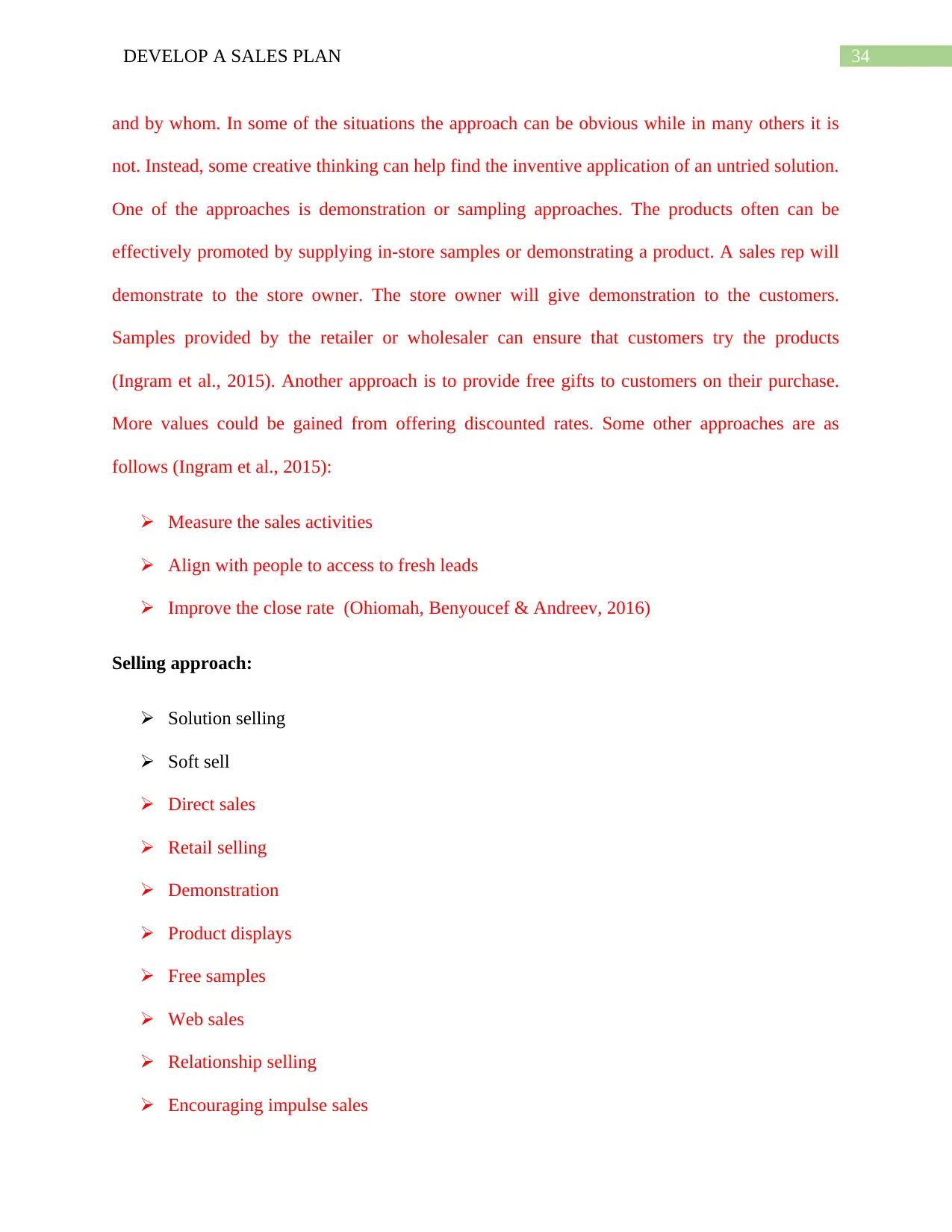
34DEVELOP A SALES PLAN
and by whom. In some of the situations the approach can be obvious while in many others it is
not. Instead, some creative thinking can help find the inventive application of an untried solution.
One of the approaches is demonstration or sampling approaches. The products often can be
effectively promoted by supplying in-store samples or demonstrating a product. A sales rep will
demonstrate to the store owner. The store owner will give demonstration to the customers.
Samples provided by the retailer or wholesaler can ensure that customers try the products
(Ingram et al., 2015). Another approach is to provide free gifts to customers on their purchase.
More values could be gained from offering discounted rates. Some other approaches are as
follows (Ingram et al., 2015):
Measure the sales activities
Align with people to access to fresh leads
Improve the close rate (Ohiomah, Benyoucef & Andreev, 2016)
Selling approach:
Solution selling
Soft sell
Direct sales
Retail selling
Demonstration
Product displays
Free samples
Web sales
Relationship selling
Encouraging impulse sales
and by whom. In some of the situations the approach can be obvious while in many others it is
not. Instead, some creative thinking can help find the inventive application of an untried solution.
One of the approaches is demonstration or sampling approaches. The products often can be
effectively promoted by supplying in-store samples or demonstrating a product. A sales rep will
demonstrate to the store owner. The store owner will give demonstration to the customers.
Samples provided by the retailer or wholesaler can ensure that customers try the products
(Ingram et al., 2015). Another approach is to provide free gifts to customers on their purchase.
More values could be gained from offering discounted rates. Some other approaches are as
follows (Ingram et al., 2015):
Measure the sales activities
Align with people to access to fresh leads
Improve the close rate (Ohiomah, Benyoucef & Andreev, 2016)
Selling approach:
Solution selling
Soft sell
Direct sales
Retail selling
Demonstration
Product displays
Free samples
Web sales
Relationship selling
Encouraging impulse sales
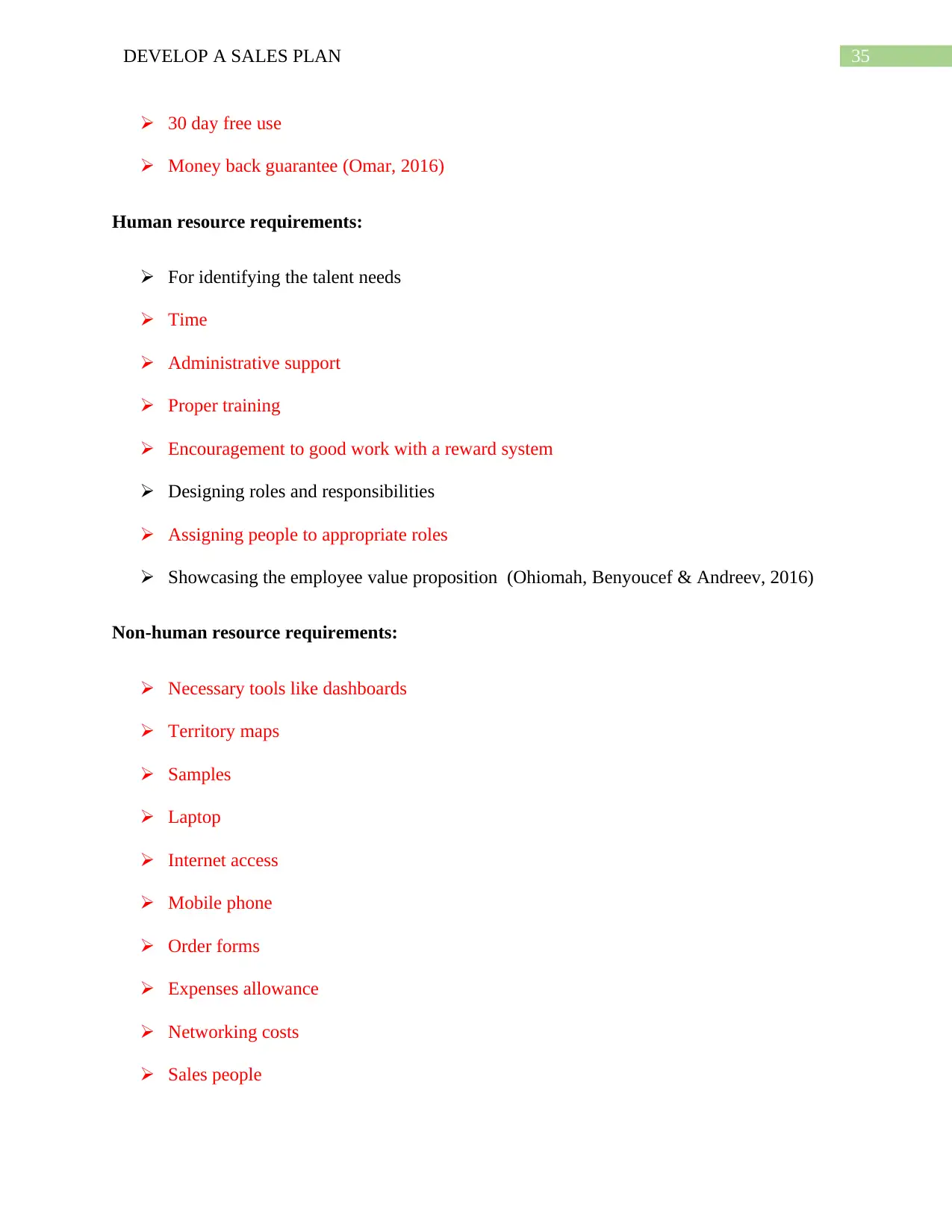
35DEVELOP A SALES PLAN
30 day free use
Money back guarantee (Omar, 2016)
Human resource requirements:
For identifying the talent needs
Time
Administrative support
Proper training
Encouragement to good work with a reward system
Designing roles and responsibilities
Assigning people to appropriate roles
Showcasing the employee value proposition (Ohiomah, Benyoucef & Andreev, 2016)
Non-human resource requirements:
Necessary tools like dashboards
Territory maps
Samples
Laptop
Internet access
Mobile phone
Order forms
Expenses allowance
Networking costs
Sales people
30 day free use
Money back guarantee (Omar, 2016)
Human resource requirements:
For identifying the talent needs
Time
Administrative support
Proper training
Encouragement to good work with a reward system
Designing roles and responsibilities
Assigning people to appropriate roles
Showcasing the employee value proposition (Ohiomah, Benyoucef & Andreev, 2016)
Non-human resource requirements:
Necessary tools like dashboards
Territory maps
Samples
Laptop
Internet access
Mobile phone
Order forms
Expenses allowance
Networking costs
Sales people
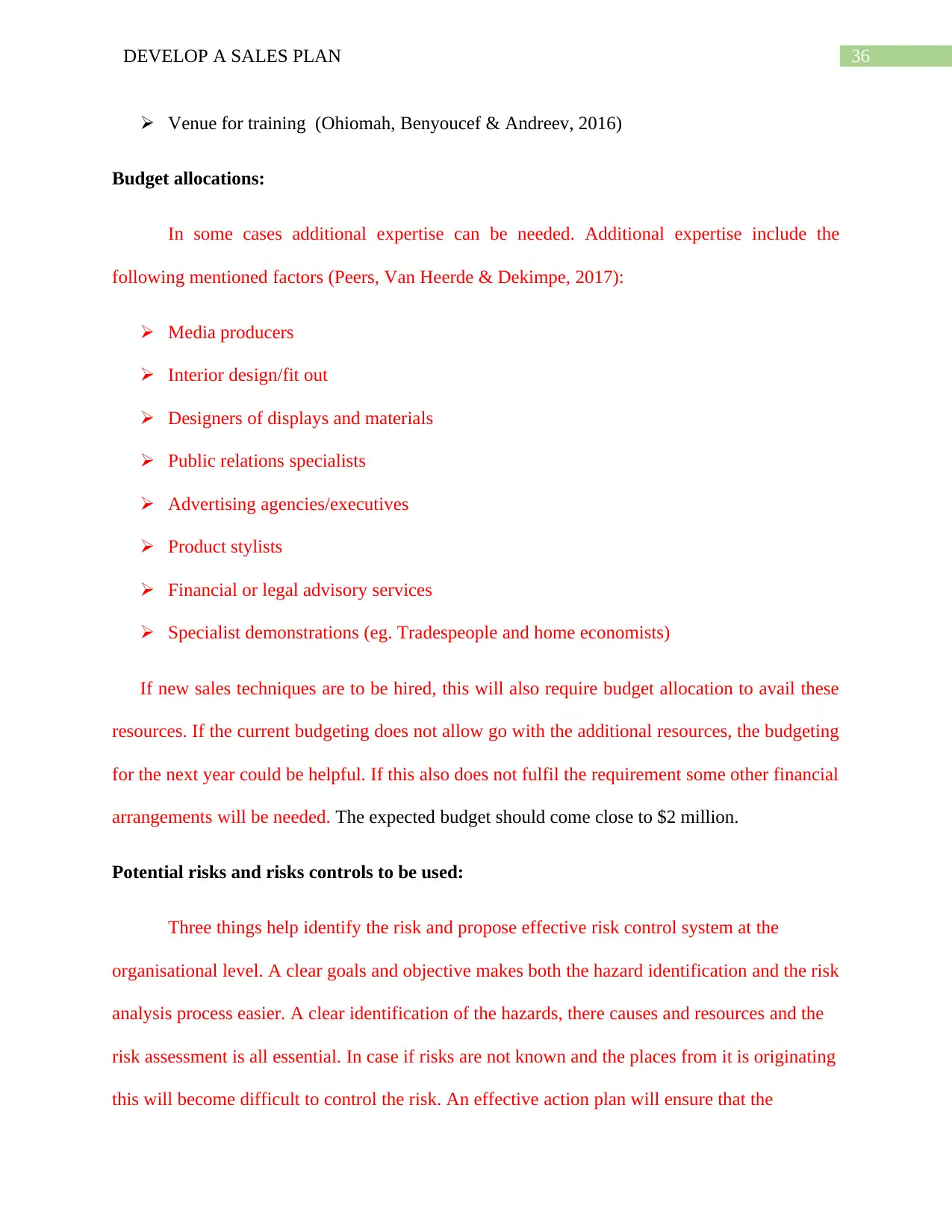
36DEVELOP A SALES PLAN
Venue for training (Ohiomah, Benyoucef & Andreev, 2016)
Budget allocations:
In some cases additional expertise can be needed. Additional expertise include the
following mentioned factors (Peers, Van Heerde & Dekimpe, 2017):
Media producers
Interior design/fit out
Designers of displays and materials
Public relations specialists
Advertising agencies/executives
Product stylists
Financial or legal advisory services
Specialist demonstrations (eg. Tradespeople and home economists)
If new sales techniques are to be hired, this will also require budget allocation to avail these
resources. If the current budgeting does not allow go with the additional resources, the budgeting
for the next year could be helpful. If this also does not fulfil the requirement some other financial
arrangements will be needed. The expected budget should come close to $2 million.
Potential risks and risks controls to be used:
Three things help identify the risk and propose effective risk control system at the
organisational level. A clear goals and objective makes both the hazard identification and the risk
analysis process easier. A clear identification of the hazards, there causes and resources and the
risk assessment is all essential. In case if risks are not known and the places from it is originating
this will become difficult to control the risk. An effective action plan will ensure that the
Venue for training (Ohiomah, Benyoucef & Andreev, 2016)
Budget allocations:
In some cases additional expertise can be needed. Additional expertise include the
following mentioned factors (Peers, Van Heerde & Dekimpe, 2017):
Media producers
Interior design/fit out
Designers of displays and materials
Public relations specialists
Advertising agencies/executives
Product stylists
Financial or legal advisory services
Specialist demonstrations (eg. Tradespeople and home economists)
If new sales techniques are to be hired, this will also require budget allocation to avail these
resources. If the current budgeting does not allow go with the additional resources, the budgeting
for the next year could be helpful. If this also does not fulfil the requirement some other financial
arrangements will be needed. The expected budget should come close to $2 million.
Potential risks and risks controls to be used:
Three things help identify the risk and propose effective risk control system at the
organisational level. A clear goals and objective makes both the hazard identification and the risk
analysis process easier. A clear identification of the hazards, there causes and resources and the
risk assessment is all essential. In case if risks are not known and the places from it is originating
this will become difficult to control the risk. An effective action plan will ensure that the
Paraphrase This Document
Need a fresh take? Get an instant paraphrase of this document with our AI Paraphraser
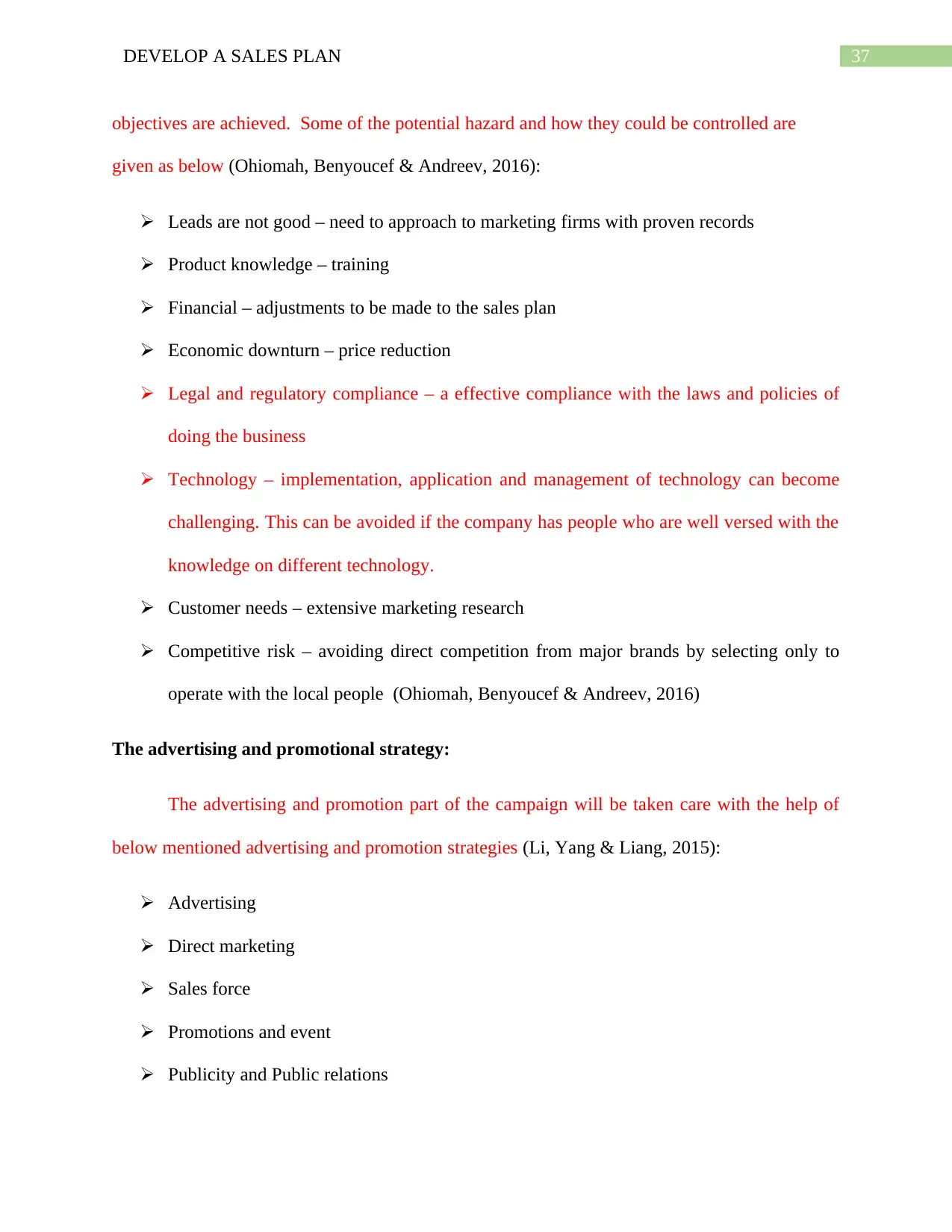
37DEVELOP A SALES PLAN
objectives are achieved. Some of the potential hazard and how they could be controlled are
given as below (Ohiomah, Benyoucef & Andreev, 2016):
Leads are not good – need to approach to marketing firms with proven records
Product knowledge – training
Financial – adjustments to be made to the sales plan
Economic downturn – price reduction
Legal and regulatory compliance – a effective compliance with the laws and policies of
doing the business
Technology – implementation, application and management of technology can become
challenging. This can be avoided if the company has people who are well versed with the
knowledge on different technology.
Customer needs – extensive marketing research
Competitive risk – avoiding direct competition from major brands by selecting only to
operate with the local people (Ohiomah, Benyoucef & Andreev, 2016)
The advertising and promotional strategy:
The advertising and promotion part of the campaign will be taken care with the help of
below mentioned advertising and promotion strategies (Li, Yang & Liang, 2015):
Advertising
Direct marketing
Sales force
Promotions and event
Publicity and Public relations
objectives are achieved. Some of the potential hazard and how they could be controlled are
given as below (Ohiomah, Benyoucef & Andreev, 2016):
Leads are not good – need to approach to marketing firms with proven records
Product knowledge – training
Financial – adjustments to be made to the sales plan
Economic downturn – price reduction
Legal and regulatory compliance – a effective compliance with the laws and policies of
doing the business
Technology – implementation, application and management of technology can become
challenging. This can be avoided if the company has people who are well versed with the
knowledge on different technology.
Customer needs – extensive marketing research
Competitive risk – avoiding direct competition from major brands by selecting only to
operate with the local people (Ohiomah, Benyoucef & Andreev, 2016)
The advertising and promotional strategy:
The advertising and promotion part of the campaign will be taken care with the help of
below mentioned advertising and promotion strategies (Li, Yang & Liang, 2015):
Advertising
Direct marketing
Sales force
Promotions and event
Publicity and Public relations
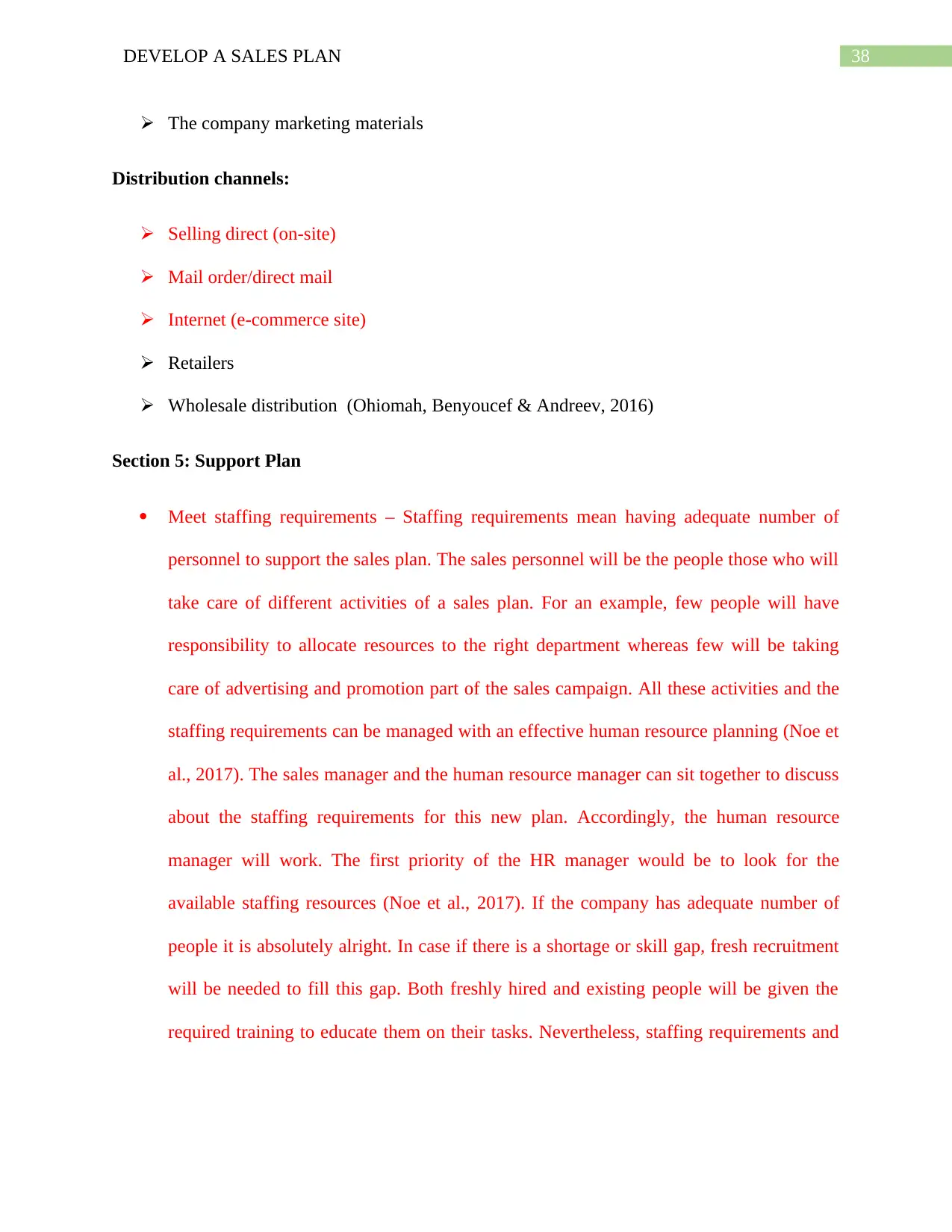
38DEVELOP A SALES PLAN
The company marketing materials
Distribution channels:
Selling direct (on-site)
Mail order/direct mail
Internet (e-commerce site)
Retailers
Wholesale distribution (Ohiomah, Benyoucef & Andreev, 2016)
Section 5: Support Plan
Meet staffing requirements – Staffing requirements mean having adequate number of
personnel to support the sales plan. The sales personnel will be the people those who will
take care of different activities of a sales plan. For an example, few people will have
responsibility to allocate resources to the right department whereas few will be taking
care of advertising and promotion part of the sales campaign. All these activities and the
staffing requirements can be managed with an effective human resource planning (Noe et
al., 2017). The sales manager and the human resource manager can sit together to discuss
about the staffing requirements for this new plan. Accordingly, the human resource
manager will work. The first priority of the HR manager would be to look for the
available staffing resources (Noe et al., 2017). If the company has adequate number of
people it is absolutely alright. In case if there is a shortage or skill gap, fresh recruitment
will be needed to fill this gap. Both freshly hired and existing people will be given the
required training to educate them on their tasks. Nevertheless, staffing requirements and
The company marketing materials
Distribution channels:
Selling direct (on-site)
Mail order/direct mail
Internet (e-commerce site)
Retailers
Wholesale distribution (Ohiomah, Benyoucef & Andreev, 2016)
Section 5: Support Plan
Meet staffing requirements – Staffing requirements mean having adequate number of
personnel to support the sales plan. The sales personnel will be the people those who will
take care of different activities of a sales plan. For an example, few people will have
responsibility to allocate resources to the right department whereas few will be taking
care of advertising and promotion part of the sales campaign. All these activities and the
staffing requirements can be managed with an effective human resource planning (Noe et
al., 2017). The sales manager and the human resource manager can sit together to discuss
about the staffing requirements for this new plan. Accordingly, the human resource
manager will work. The first priority of the HR manager would be to look for the
available staffing resources (Noe et al., 2017). If the company has adequate number of
people it is absolutely alright. In case if there is a shortage or skill gap, fresh recruitment
will be needed to fill this gap. Both freshly hired and existing people will be given the
required training to educate them on their tasks. Nevertheless, staffing requirements and
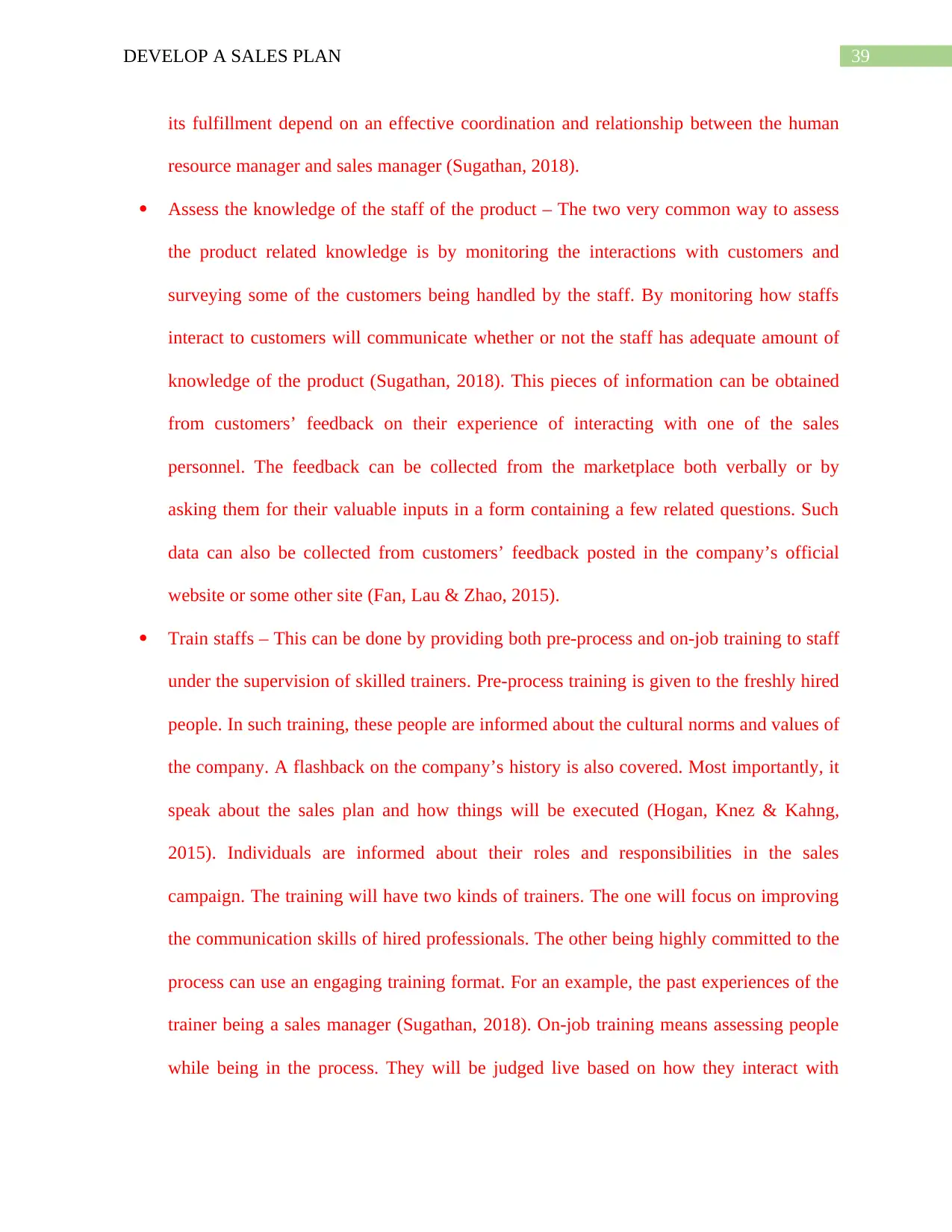
39DEVELOP A SALES PLAN
its fulfillment depend on an effective coordination and relationship between the human
resource manager and sales manager (Sugathan, 2018).
Assess the knowledge of the staff of the product – The two very common way to assess
the product related knowledge is by monitoring the interactions with customers and
surveying some of the customers being handled by the staff. By monitoring how staffs
interact to customers will communicate whether or not the staff has adequate amount of
knowledge of the product (Sugathan, 2018). This pieces of information can be obtained
from customers’ feedback on their experience of interacting with one of the sales
personnel. The feedback can be collected from the marketplace both verbally or by
asking them for their valuable inputs in a form containing a few related questions. Such
data can also be collected from customers’ feedback posted in the company’s official
website or some other site (Fan, Lau & Zhao, 2015).
Train staffs – This can be done by providing both pre-process and on-job training to staff
under the supervision of skilled trainers. Pre-process training is given to the freshly hired
people. In such training, these people are informed about the cultural norms and values of
the company. A flashback on the company’s history is also covered. Most importantly, it
speak about the sales plan and how things will be executed (Hogan, Knez & Kahng,
2015). Individuals are informed about their roles and responsibilities in the sales
campaign. The training will have two kinds of trainers. The one will focus on improving
the communication skills of hired professionals. The other being highly committed to the
process can use an engaging training format. For an example, the past experiences of the
trainer being a sales manager (Sugathan, 2018). On-job training means assessing people
while being in the process. They will be judged live based on how they interact with
its fulfillment depend on an effective coordination and relationship between the human
resource manager and sales manager (Sugathan, 2018).
Assess the knowledge of the staff of the product – The two very common way to assess
the product related knowledge is by monitoring the interactions with customers and
surveying some of the customers being handled by the staff. By monitoring how staffs
interact to customers will communicate whether or not the staff has adequate amount of
knowledge of the product (Sugathan, 2018). This pieces of information can be obtained
from customers’ feedback on their experience of interacting with one of the sales
personnel. The feedback can be collected from the marketplace both verbally or by
asking them for their valuable inputs in a form containing a few related questions. Such
data can also be collected from customers’ feedback posted in the company’s official
website or some other site (Fan, Lau & Zhao, 2015).
Train staffs – This can be done by providing both pre-process and on-job training to staff
under the supervision of skilled trainers. Pre-process training is given to the freshly hired
people. In such training, these people are informed about the cultural norms and values of
the company. A flashback on the company’s history is also covered. Most importantly, it
speak about the sales plan and how things will be executed (Hogan, Knez & Kahng,
2015). Individuals are informed about their roles and responsibilities in the sales
campaign. The training will have two kinds of trainers. The one will focus on improving
the communication skills of hired professionals. The other being highly committed to the
process can use an engaging training format. For an example, the past experiences of the
trainer being a sales manager (Sugathan, 2018). On-job training means assessing people
while being in the process. They will be judged live based on how they interact with
Secure Best Marks with AI Grader
Need help grading? Try our AI Grader for instant feedback on your assignments.
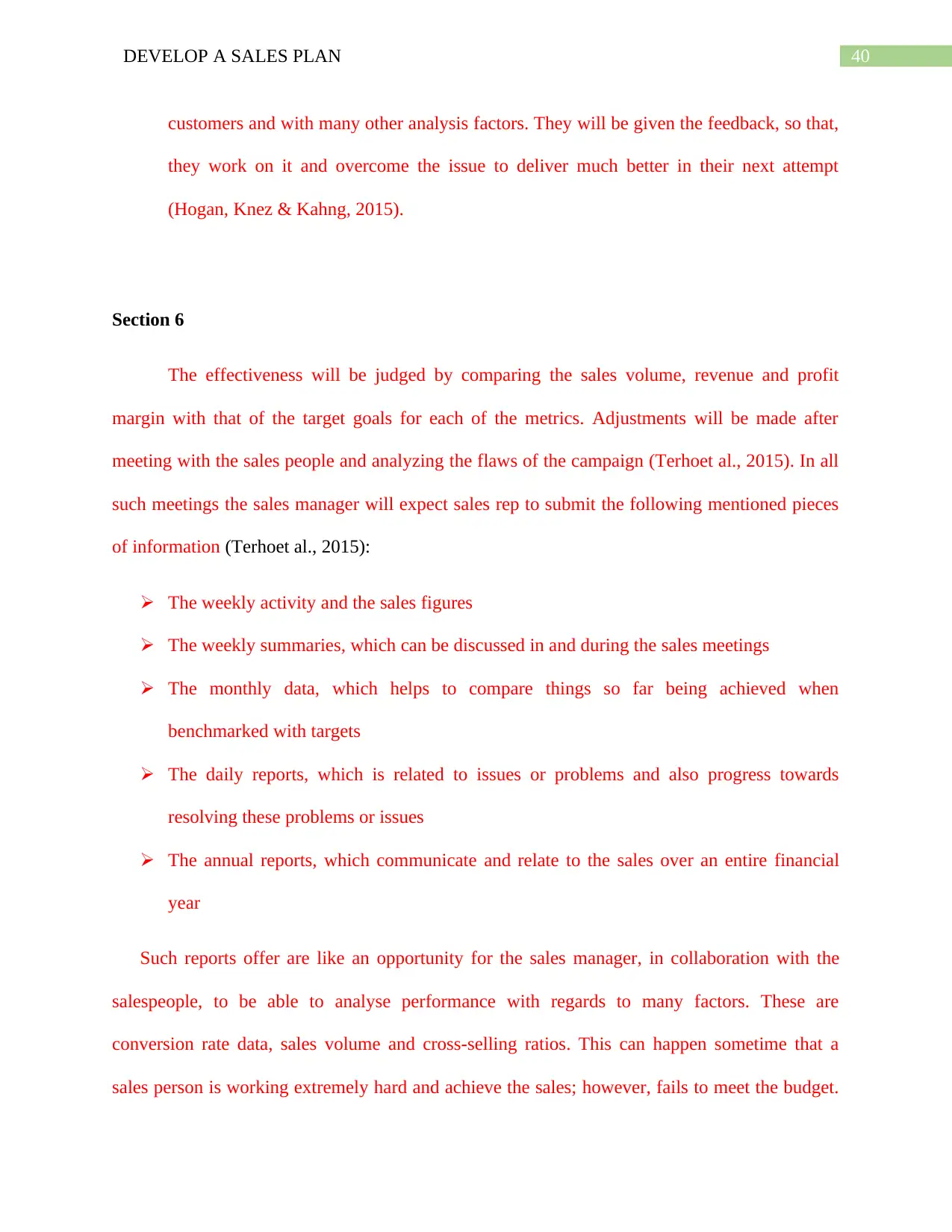
40DEVELOP A SALES PLAN
customers and with many other analysis factors. They will be given the feedback, so that,
they work on it and overcome the issue to deliver much better in their next attempt
(Hogan, Knez & Kahng, 2015).
Section 6
The effectiveness will be judged by comparing the sales volume, revenue and profit
margin with that of the target goals for each of the metrics. Adjustments will be made after
meeting with the sales people and analyzing the flaws of the campaign (Terhoet al., 2015). In all
such meetings the sales manager will expect sales rep to submit the following mentioned pieces
of information (Terhoet al., 2015):
The weekly activity and the sales figures
The weekly summaries, which can be discussed in and during the sales meetings
The monthly data, which helps to compare things so far being achieved when
benchmarked with targets
The daily reports, which is related to issues or problems and also progress towards
resolving these problems or issues
The annual reports, which communicate and relate to the sales over an entire financial
year
Such reports offer are like an opportunity for the sales manager, in collaboration with the
salespeople, to be able to analyse performance with regards to many factors. These are
conversion rate data, sales volume and cross-selling ratios. This can happen sometime that a
sales person is working extremely hard and achieve the sales; however, fails to meet the budget.
customers and with many other analysis factors. They will be given the feedback, so that,
they work on it and overcome the issue to deliver much better in their next attempt
(Hogan, Knez & Kahng, 2015).
Section 6
The effectiveness will be judged by comparing the sales volume, revenue and profit
margin with that of the target goals for each of the metrics. Adjustments will be made after
meeting with the sales people and analyzing the flaws of the campaign (Terhoet al., 2015). In all
such meetings the sales manager will expect sales rep to submit the following mentioned pieces
of information (Terhoet al., 2015):
The weekly activity and the sales figures
The weekly summaries, which can be discussed in and during the sales meetings
The monthly data, which helps to compare things so far being achieved when
benchmarked with targets
The daily reports, which is related to issues or problems and also progress towards
resolving these problems or issues
The annual reports, which communicate and relate to the sales over an entire financial
year
Such reports offer are like an opportunity for the sales manager, in collaboration with the
salespeople, to be able to analyse performance with regards to many factors. These are
conversion rate data, sales volume and cross-selling ratios. This can happen sometime that a
sales person is working extremely hard and achieve the sales; however, fails to meet the budget.

41DEVELOP A SALES PLAN
This can also happen that a salespeople has adequate leads and qualified prospects as well.
Despite these he or she fails to close sales or to commence an appropriate cross-sales
(Baumgartner, Hatami & De Uster, 2016). Such reports should encourage sales manager and
salespeople work together to be able to identify the causes of failures and its probable solutions.
Making adjustments to the plan is also a part of a sales plan. A sales report might indicate
that there is some potential issue with regards to performance of a sales people or the entire team.
The issues can be anything from over to under achievement to not relating to the plan. Sales
objectives might be set very unattainable and unrealistic. This can be demotivating to the
salespeople. The problems and issues will continue with the sales team. By monitoring the plan
and respectively analysing the performance of the team could inform on a few issues or
problems. Once such problems are known or are identified it becomes feasible to make some
adjustments to the sales plan to make it more robust (Terhoet al., 2015). The purpose will be to
make it deliver the anticipated results from the sales plan. The reports and records can be used to
evaluate the objectives. Accordingly, the adjustments can be made to the plan. An evaluation of
objective with the help of records and reports will be as mentioned below (Baumgartner, Hatami
& De Uster, 2016):
Market share: To know about whether an increased share has been captured.
Sales volume: To be able to know whether the sales are on target to achieve the intended
increases.
Strategy: To identify whether the sales strategies are meeting the needs of the
organisation and of the target market.
Were the promotions being done timely?
Was the promotion and advertising able to reach to the target groups?
This can also happen that a salespeople has adequate leads and qualified prospects as well.
Despite these he or she fails to close sales or to commence an appropriate cross-sales
(Baumgartner, Hatami & De Uster, 2016). Such reports should encourage sales manager and
salespeople work together to be able to identify the causes of failures and its probable solutions.
Making adjustments to the plan is also a part of a sales plan. A sales report might indicate
that there is some potential issue with regards to performance of a sales people or the entire team.
The issues can be anything from over to under achievement to not relating to the plan. Sales
objectives might be set very unattainable and unrealistic. This can be demotivating to the
salespeople. The problems and issues will continue with the sales team. By monitoring the plan
and respectively analysing the performance of the team could inform on a few issues or
problems. Once such problems are known or are identified it becomes feasible to make some
adjustments to the sales plan to make it more robust (Terhoet al., 2015). The purpose will be to
make it deliver the anticipated results from the sales plan. The reports and records can be used to
evaluate the objectives. Accordingly, the adjustments can be made to the plan. An evaluation of
objective with the help of records and reports will be as mentioned below (Baumgartner, Hatami
& De Uster, 2016):
Market share: To know about whether an increased share has been captured.
Sales volume: To be able to know whether the sales are on target to achieve the intended
increases.
Strategy: To identify whether the sales strategies are meeting the needs of the
organisation and of the target market.
Were the promotions being done timely?
Was the promotion and advertising able to reach to the target groups?

42DEVELOP A SALES PLAN
To identify whether customers responded to advertising and promotions.
To identify whether customers responded to advertising and promotions.
Paraphrase This Document
Need a fresh take? Get an instant paraphrase of this document with our AI Paraphraser
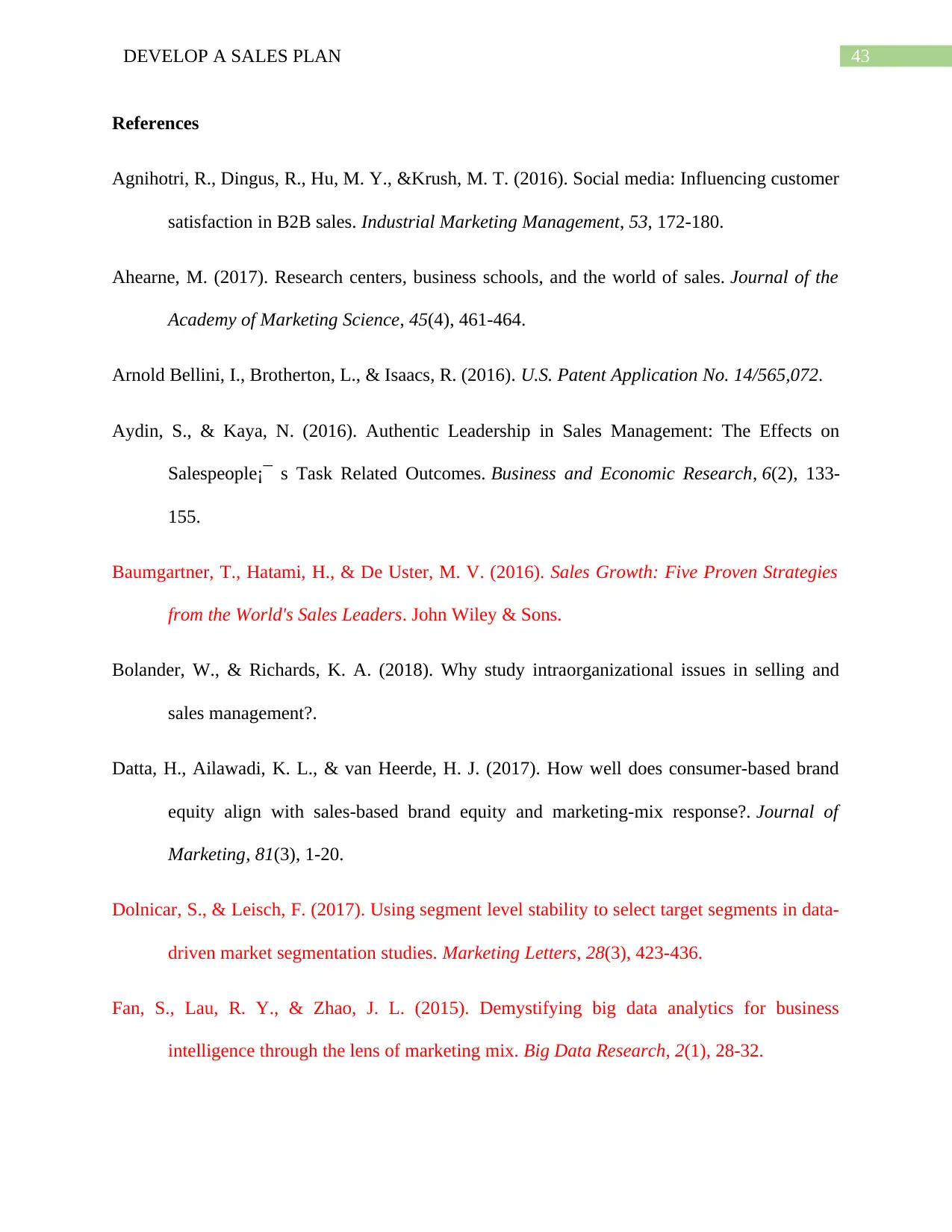
43DEVELOP A SALES PLAN
References
Agnihotri, R., Dingus, R., Hu, M. Y., &Krush, M. T. (2016). Social media: Influencing customer
satisfaction in B2B sales. Industrial Marketing Management, 53, 172-180.
Ahearne, M. (2017). Research centers, business schools, and the world of sales. Journal of the
Academy of Marketing Science, 45(4), 461-464.
Arnold Bellini, I., Brotherton, L., & Isaacs, R. (2016). U.S. Patent Application No. 14/565,072.
Aydin, S., & Kaya, N. (2016). Authentic Leadership in Sales Management: The Effects on
Salespeople¡¯ s Task Related Outcomes. Business and Economic Research, 6(2), 133-
155.
Baumgartner, T., Hatami, H., & De Uster, M. V. (2016). Sales Growth: Five Proven Strategies
from the World's Sales Leaders. John Wiley & Sons.
Bolander, W., & Richards, K. A. (2018). Why study intraorganizational issues in selling and
sales management?.
Datta, H., Ailawadi, K. L., & van Heerde, H. J. (2017). How well does consumer-based brand
equity align with sales-based brand equity and marketing-mix response?. Journal of
Marketing, 81(3), 1-20.
Dolnicar, S., & Leisch, F. (2017). Using segment level stability to select target segments in data-
driven market segmentation studies. Marketing Letters, 28(3), 423-436.
Fan, S., Lau, R. Y., & Zhao, J. L. (2015). Demystifying big data analytics for business
intelligence through the lens of marketing mix. Big Data Research, 2(1), 28-32.
References
Agnihotri, R., Dingus, R., Hu, M. Y., &Krush, M. T. (2016). Social media: Influencing customer
satisfaction in B2B sales. Industrial Marketing Management, 53, 172-180.
Ahearne, M. (2017). Research centers, business schools, and the world of sales. Journal of the
Academy of Marketing Science, 45(4), 461-464.
Arnold Bellini, I., Brotherton, L., & Isaacs, R. (2016). U.S. Patent Application No. 14/565,072.
Aydin, S., & Kaya, N. (2016). Authentic Leadership in Sales Management: The Effects on
Salespeople¡¯ s Task Related Outcomes. Business and Economic Research, 6(2), 133-
155.
Baumgartner, T., Hatami, H., & De Uster, M. V. (2016). Sales Growth: Five Proven Strategies
from the World's Sales Leaders. John Wiley & Sons.
Bolander, W., & Richards, K. A. (2018). Why study intraorganizational issues in selling and
sales management?.
Datta, H., Ailawadi, K. L., & van Heerde, H. J. (2017). How well does consumer-based brand
equity align with sales-based brand equity and marketing-mix response?. Journal of
Marketing, 81(3), 1-20.
Dolnicar, S., & Leisch, F. (2017). Using segment level stability to select target segments in data-
driven market segmentation studies. Marketing Letters, 28(3), 423-436.
Fan, S., Lau, R. Y., & Zhao, J. L. (2015). Demystifying big data analytics for business
intelligence through the lens of marketing mix. Big Data Research, 2(1), 28-32.

44DEVELOP A SALES PLAN
Fan, Z. P., Che, Y. J., & Chen, Z. Y. (2017). Product sales forecasting using online reviews and
historical sales data: A method combining the Bass model and sentiment
analysis. Journal of Business Research, 74, 90-100.
Fonseca, L. M., & Domingues, J. P. (2017). How to succeed in the digital age? Monitor the
organizational context, identify risks and opportunities, and manage change
effectively. Management & Marketing, 12(3), 443-455.
Gallino, S., Moreno, A., &Stamatopoulos, I. (2016). Channel integration, sales dispersion, and
inventory management. Management Science, 63(9), 2813-2831.
Górski, F., Buń, P., Wichniarek, R., Zawadzki, P., &Hamrol, A. (2015). Immersive city bus
configuration system for marketing and sales education. Procedia Computer Science, 75,
137-146.
Guesalaga, R. (2016). The use of social media in sales: Individual and organizational
antecedents, and the role of customer engagement in social media. Industrial Marketing
Management, 54, 71-79.
Hogan, A., Knez, N., & Kahng, S. (2015). Evaluating the use of behavioral skills training to
improve school staffs’ implementation of behavior intervention plans. Journal of
Behavioral Education, 24(2), 242-254.
Horak, S., &Nihalani, K. (2016). Social networks, vertical core competencies and sales
management in Korea. Management Decision, 54(8), 1929-1946.
Hughes, T., Gray, A., &Whicher, H. (2018). Smarketing: How to Achieve Competitive
Advantage Through Blended Sales and Marketing. Kogan Page Publishers.
Fan, Z. P., Che, Y. J., & Chen, Z. Y. (2017). Product sales forecasting using online reviews and
historical sales data: A method combining the Bass model and sentiment
analysis. Journal of Business Research, 74, 90-100.
Fonseca, L. M., & Domingues, J. P. (2017). How to succeed in the digital age? Monitor the
organizational context, identify risks and opportunities, and manage change
effectively. Management & Marketing, 12(3), 443-455.
Gallino, S., Moreno, A., &Stamatopoulos, I. (2016). Channel integration, sales dispersion, and
inventory management. Management Science, 63(9), 2813-2831.
Górski, F., Buń, P., Wichniarek, R., Zawadzki, P., &Hamrol, A. (2015). Immersive city bus
configuration system for marketing and sales education. Procedia Computer Science, 75,
137-146.
Guesalaga, R. (2016). The use of social media in sales: Individual and organizational
antecedents, and the role of customer engagement in social media. Industrial Marketing
Management, 54, 71-79.
Hogan, A., Knez, N., & Kahng, S. (2015). Evaluating the use of behavioral skills training to
improve school staffs’ implementation of behavior intervention plans. Journal of
Behavioral Education, 24(2), 242-254.
Horak, S., &Nihalani, K. (2016). Social networks, vertical core competencies and sales
management in Korea. Management Decision, 54(8), 1929-1946.
Hughes, T., Gray, A., &Whicher, H. (2018). Smarketing: How to Achieve Competitive
Advantage Through Blended Sales and Marketing. Kogan Page Publishers.
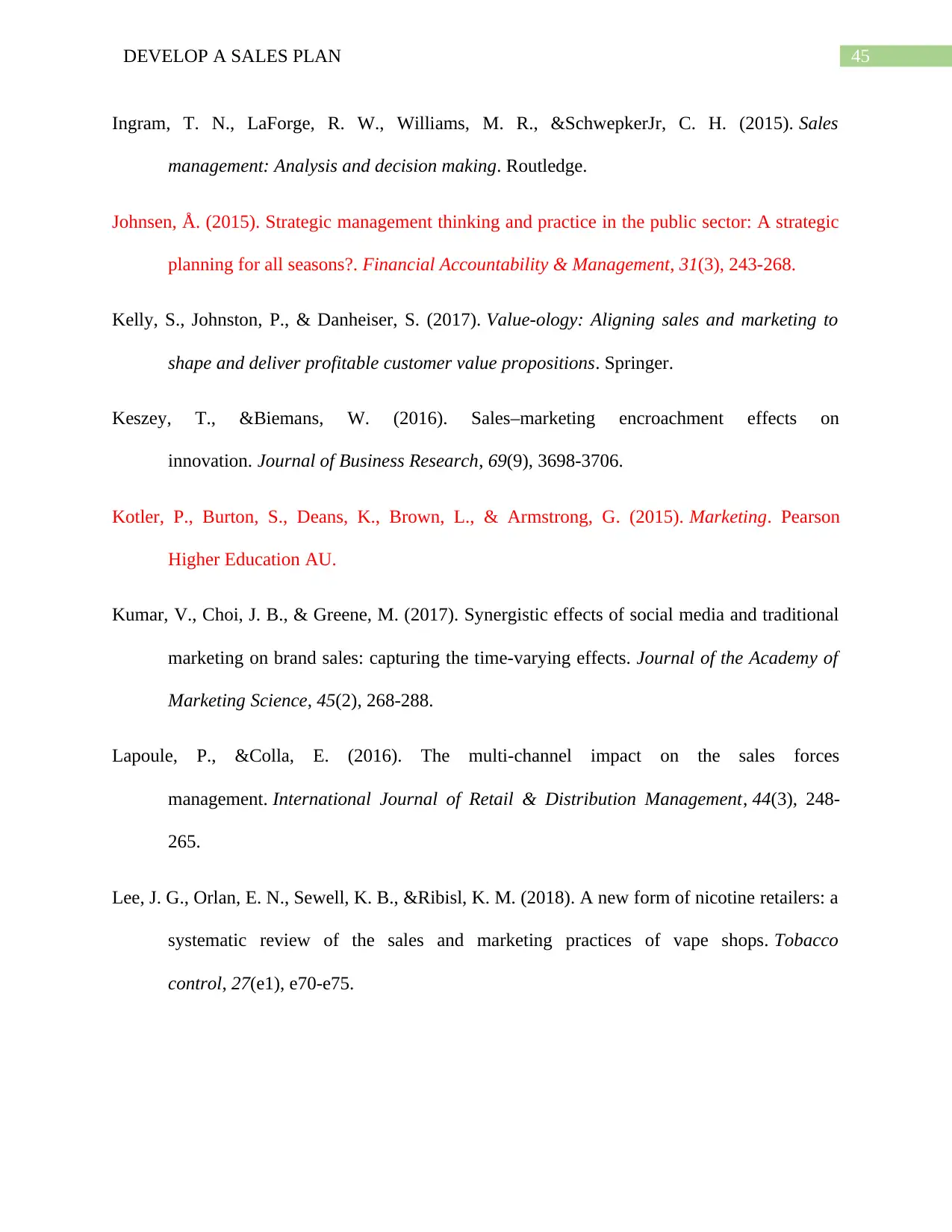
45DEVELOP A SALES PLAN
Ingram, T. N., LaForge, R. W., Williams, M. R., &SchwepkerJr, C. H. (2015). Sales
management: Analysis and decision making. Routledge.
Johnsen, Å. (2015). Strategic management thinking and practice in the public sector: A strategic
planning for all seasons?. Financial Accountability & Management, 31(3), 243-268.
Kelly, S., Johnston, P., & Danheiser, S. (2017). Value-ology: Aligning sales and marketing to
shape and deliver profitable customer value propositions. Springer.
Keszey, T., &Biemans, W. (2016). Sales–marketing encroachment effects on
innovation. Journal of Business Research, 69(9), 3698-3706.
Kotler, P., Burton, S., Deans, K., Brown, L., & Armstrong, G. (2015). Marketing. Pearson
Higher Education AU.
Kumar, V., Choi, J. B., & Greene, M. (2017). Synergistic effects of social media and traditional
marketing on brand sales: capturing the time-varying effects. Journal of the Academy of
Marketing Science, 45(2), 268-288.
Lapoule, P., &Colla, E. (2016). The multi-channel impact on the sales forces
management. International Journal of Retail & Distribution Management, 44(3), 248-
265.
Lee, J. G., Orlan, E. N., Sewell, K. B., &Ribisl, K. M. (2018). A new form of nicotine retailers: a
systematic review of the sales and marketing practices of vape shops. Tobacco
control, 27(e1), e70-e75.
Ingram, T. N., LaForge, R. W., Williams, M. R., &SchwepkerJr, C. H. (2015). Sales
management: Analysis and decision making. Routledge.
Johnsen, Å. (2015). Strategic management thinking and practice in the public sector: A strategic
planning for all seasons?. Financial Accountability & Management, 31(3), 243-268.
Kelly, S., Johnston, P., & Danheiser, S. (2017). Value-ology: Aligning sales and marketing to
shape and deliver profitable customer value propositions. Springer.
Keszey, T., &Biemans, W. (2016). Sales–marketing encroachment effects on
innovation. Journal of Business Research, 69(9), 3698-3706.
Kotler, P., Burton, S., Deans, K., Brown, L., & Armstrong, G. (2015). Marketing. Pearson
Higher Education AU.
Kumar, V., Choi, J. B., & Greene, M. (2017). Synergistic effects of social media and traditional
marketing on brand sales: capturing the time-varying effects. Journal of the Academy of
Marketing Science, 45(2), 268-288.
Lapoule, P., &Colla, E. (2016). The multi-channel impact on the sales forces
management. International Journal of Retail & Distribution Management, 44(3), 248-
265.
Lee, J. G., Orlan, E. N., Sewell, K. B., &Ribisl, K. M. (2018). A new form of nicotine retailers: a
systematic review of the sales and marketing practices of vape shops. Tobacco
control, 27(e1), e70-e75.
Secure Best Marks with AI Grader
Need help grading? Try our AI Grader for instant feedback on your assignments.
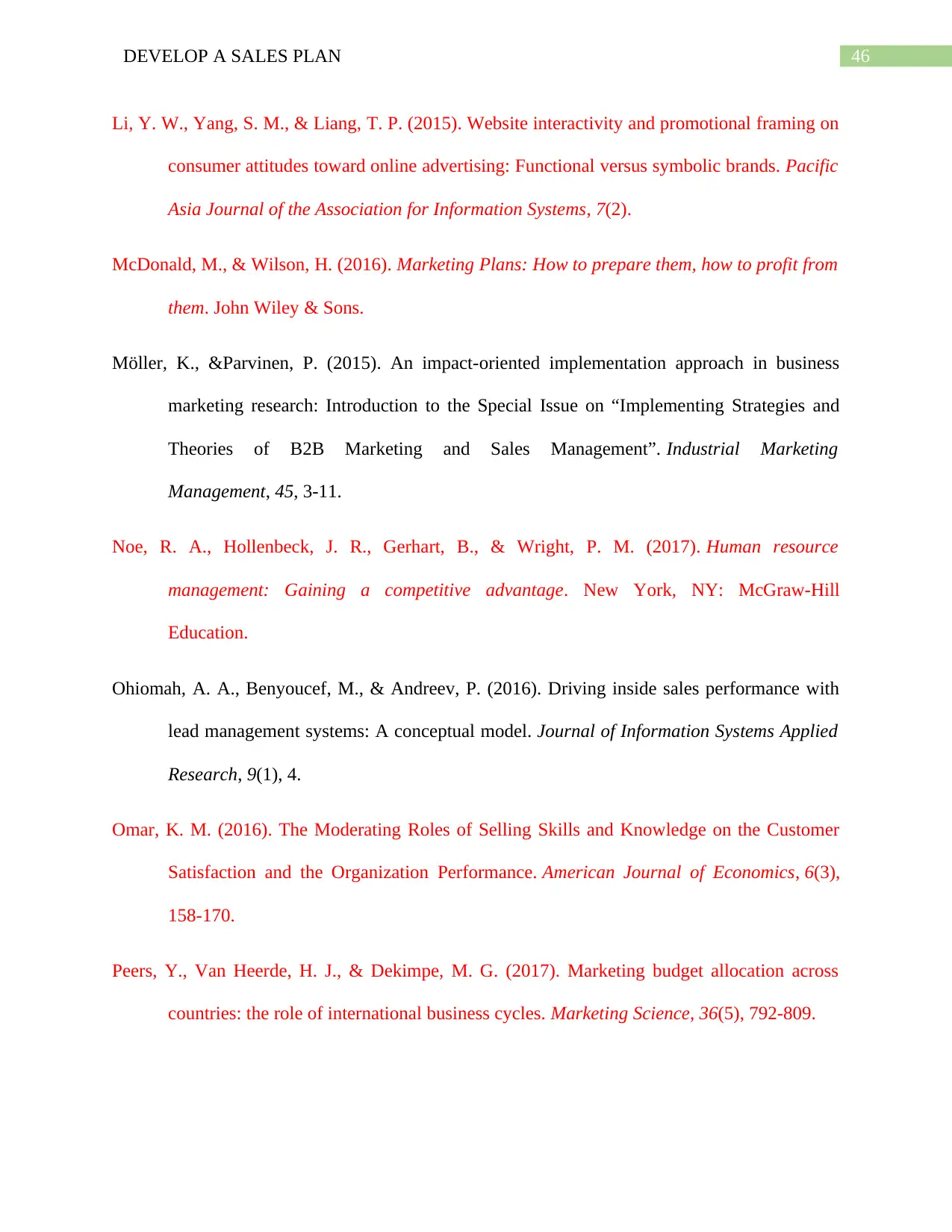
46DEVELOP A SALES PLAN
Li, Y. W., Yang, S. M., & Liang, T. P. (2015). Website interactivity and promotional framing on
consumer attitudes toward online advertising: Functional versus symbolic brands. Pacific
Asia Journal of the Association for Information Systems, 7(2).
McDonald, M., & Wilson, H. (2016). Marketing Plans: How to prepare them, how to profit from
them. John Wiley & Sons.
Möller, K., &Parvinen, P. (2015). An impact-oriented implementation approach in business
marketing research: Introduction to the Special Issue on “Implementing Strategies and
Theories of B2B Marketing and Sales Management”. Industrial Marketing
Management, 45, 3-11.
Noe, R. A., Hollenbeck, J. R., Gerhart, B., & Wright, P. M. (2017). Human resource
management: Gaining a competitive advantage. New York, NY: McGraw-Hill
Education.
Ohiomah, A. A., Benyoucef, M., & Andreev, P. (2016). Driving inside sales performance with
lead management systems: A conceptual model. Journal of Information Systems Applied
Research, 9(1), 4.
Omar, K. M. (2016). The Moderating Roles of Selling Skills and Knowledge on the Customer
Satisfaction and the Organization Performance. American Journal of Economics, 6(3),
158-170.
Peers, Y., Van Heerde, H. J., & Dekimpe, M. G. (2017). Marketing budget allocation across
countries: the role of international business cycles. Marketing Science, 36(5), 792-809.
Li, Y. W., Yang, S. M., & Liang, T. P. (2015). Website interactivity and promotional framing on
consumer attitudes toward online advertising: Functional versus symbolic brands. Pacific
Asia Journal of the Association for Information Systems, 7(2).
McDonald, M., & Wilson, H. (2016). Marketing Plans: How to prepare them, how to profit from
them. John Wiley & Sons.
Möller, K., &Parvinen, P. (2015). An impact-oriented implementation approach in business
marketing research: Introduction to the Special Issue on “Implementing Strategies and
Theories of B2B Marketing and Sales Management”. Industrial Marketing
Management, 45, 3-11.
Noe, R. A., Hollenbeck, J. R., Gerhart, B., & Wright, P. M. (2017). Human resource
management: Gaining a competitive advantage. New York, NY: McGraw-Hill
Education.
Ohiomah, A. A., Benyoucef, M., & Andreev, P. (2016). Driving inside sales performance with
lead management systems: A conceptual model. Journal of Information Systems Applied
Research, 9(1), 4.
Omar, K. M. (2016). The Moderating Roles of Selling Skills and Knowledge on the Customer
Satisfaction and the Organization Performance. American Journal of Economics, 6(3),
158-170.
Peers, Y., Van Heerde, H. J., & Dekimpe, M. G. (2017). Marketing budget allocation across
countries: the role of international business cycles. Marketing Science, 36(5), 792-809.
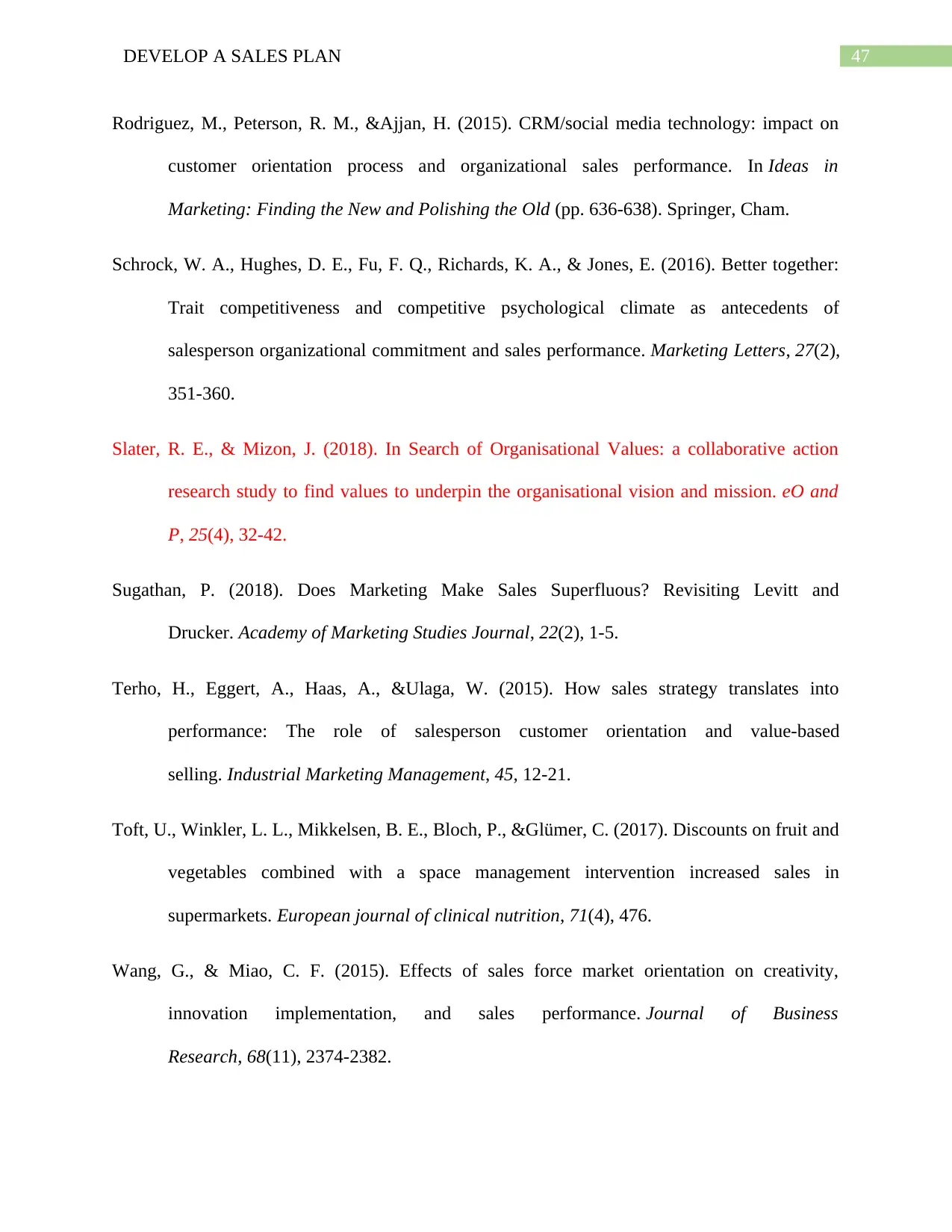
47DEVELOP A SALES PLAN
Rodriguez, M., Peterson, R. M., &Ajjan, H. (2015). CRM/social media technology: impact on
customer orientation process and organizational sales performance. In Ideas in
Marketing: Finding the New and Polishing the Old (pp. 636-638). Springer, Cham.
Schrock, W. A., Hughes, D. E., Fu, F. Q., Richards, K. A., & Jones, E. (2016). Better together:
Trait competitiveness and competitive psychological climate as antecedents of
salesperson organizational commitment and sales performance. Marketing Letters, 27(2),
351-360.
Slater, R. E., & Mizon, J. (2018). In Search of Organisational Values: a collaborative action
research study to find values to underpin the organisational vision and mission. eO and
P, 25(4), 32-42.
Sugathan, P. (2018). Does Marketing Make Sales Superfluous? Revisiting Levitt and
Drucker. Academy of Marketing Studies Journal, 22(2), 1-5.
Terho, H., Eggert, A., Haas, A., &Ulaga, W. (2015). How sales strategy translates into
performance: The role of salesperson customer orientation and value-based
selling. Industrial Marketing Management, 45, 12-21.
Toft, U., Winkler, L. L., Mikkelsen, B. E., Bloch, P., &Glümer, C. (2017). Discounts on fruit and
vegetables combined with a space management intervention increased sales in
supermarkets. European journal of clinical nutrition, 71(4), 476.
Wang, G., & Miao, C. F. (2015). Effects of sales force market orientation on creativity,
innovation implementation, and sales performance. Journal of Business
Research, 68(11), 2374-2382.
Rodriguez, M., Peterson, R. M., &Ajjan, H. (2015). CRM/social media technology: impact on
customer orientation process and organizational sales performance. In Ideas in
Marketing: Finding the New and Polishing the Old (pp. 636-638). Springer, Cham.
Schrock, W. A., Hughes, D. E., Fu, F. Q., Richards, K. A., & Jones, E. (2016). Better together:
Trait competitiveness and competitive psychological climate as antecedents of
salesperson organizational commitment and sales performance. Marketing Letters, 27(2),
351-360.
Slater, R. E., & Mizon, J. (2018). In Search of Organisational Values: a collaborative action
research study to find values to underpin the organisational vision and mission. eO and
P, 25(4), 32-42.
Sugathan, P. (2018). Does Marketing Make Sales Superfluous? Revisiting Levitt and
Drucker. Academy of Marketing Studies Journal, 22(2), 1-5.
Terho, H., Eggert, A., Haas, A., &Ulaga, W. (2015). How sales strategy translates into
performance: The role of salesperson customer orientation and value-based
selling. Industrial Marketing Management, 45, 12-21.
Toft, U., Winkler, L. L., Mikkelsen, B. E., Bloch, P., &Glümer, C. (2017). Discounts on fruit and
vegetables combined with a space management intervention increased sales in
supermarkets. European journal of clinical nutrition, 71(4), 476.
Wang, G., & Miao, C. F. (2015). Effects of sales force market orientation on creativity,
innovation implementation, and sales performance. Journal of Business
Research, 68(11), 2374-2382.

48DEVELOP A SALES PLAN
1 out of 49
Related Documents
Your All-in-One AI-Powered Toolkit for Academic Success.
+13062052269
info@desklib.com
Available 24*7 on WhatsApp / Email
![[object Object]](/_next/static/media/star-bottom.7253800d.svg)
Unlock your academic potential
© 2024 | Zucol Services PVT LTD | All rights reserved.





